Australian
and international
exploratory
performance and
media arts
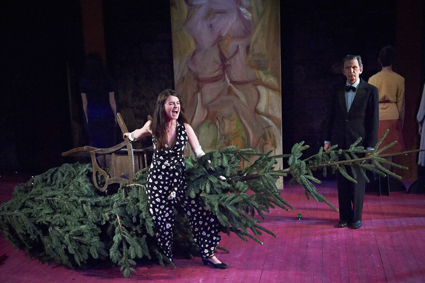
A Doll House, Pan Pan Theatre
courtesy the company
A Doll House, Pan Pan Theatre
BRISBANE POWERHOUSE’S WORLD THEATRE FESTIVAL WAS INAUGURATED IN 2010 WITH LOFTY AMBITIONS IF RELATIVELY HUMBLE MEANS.
There was some genuinely good and interesting work in the program, but as is often the case with inaugural years of risky and ambitious new ideas, audiences were small and populated mostly by dedicated theatregoers and industry practitioners. Shows that had worked well in idiosyncratic performance ghettoes in Melbourne (the ‘World’ being Melbourne and Dublin that year, from memory) didn’t always transfer successfully into the larger and more conventional theatre spaces of the Powerhouse.
Then in 2011 Artistic Director Andrew Ross pulled off a major marketing coup, securing a $500,000 philanthropic gift over three years from Wotif.com founder Graeme Wood. Suddenly WTF exploded into the stratosphere with work from the USA, the Netherlands, New Zealand and Argentina; the Australian quotient was more selectively curated, and local theatre-makers were nurtured under the auspices of a developmental wing in the form of a show-and-tell ‘scratch’ series (RT102). The 2013 WTF season is the final one of the Wotif endowment, and it is the crowning achievement of Ross’ tenure (he has stepped down from his Artistic Directorship of the Powerhouse) and Sarah Neal’s programming curatorship. WTF has become the must-attend event of the Brisbane theatre calendar.
The festival team has not only developed the strongest and most compelling line-up of all the WTFs thus far (with an entirely welcome new writing focus), they have also pulled off the most effective use of the Powerhouse’s many intriguing spaces. Melbourne’s MKA Theatre of New Writing bring their successful run of The Economist (RT107) to town, housed in the Rooftop Terrace, a flexible upstairs space tucked away beyond the administration offices. The Brechtian actor-audience shenanigans—the direct address and irreverent song-and-dance routines that drive the pace of this theatrical riff on the biography of rightwing Norwegian terrorist Anders Breivik—simply work better in enclosed confines than they would in either of the BP’s traditional theatre venues. And Ireland’s Pan Pan Theatre return to the large Powerhouse Theatre having played there in 2011 with their anarchic version of Oedipus; this time they know how to really fill the space and take advantage of its warehouse-like dimensions and extraordinary acoustics. Their postmodern A Doll House is a festival highlight.
a doll house
Ibsen’s 1871 play A Doll’s House might not scream ‘new writing,’ but writer-director Gavin Quinn’s liberal adaptation of the text (losing the possessive ‘s’ in the play’s title is perhaps emblematic of such liberty) renders it as fresh as a newly minted manuscript. Here the maid, Mrs Helmer, recites the stage directions to the audience, announces the subtext and provides plot summaries at key dramatic junctures. More than a post-Brechtian indulgence, the play text is being reconfigured and reimagined in strategic ways that cause us to reconsider who Nora is (not was in 1871). Is she a WAG—a footballer’s wife and/or girlfriend? A symbol of materialistic Celtic Tiger Dublin (before the Crash)? The acquisitive McMansion hausfrau in the outer suburbs of any 21st century city? Is she, in other words, one of us? In this version the language sings, as do the characters who break into rousing ballads from Les Mis or the Whitney Houston back-catalogue when internal reflection is called for. In Quinn’s Doll House, Nora rips open parcels, decorates for Christmas and dances a berserk tarantella like a demon-possessed Barbie. She delivers platitudes like a robot or an irrigation sprinkler caught in a repeat cycle. The playing style leans toward the absurdist but can just as readily dogleg into the melodramatic or soap operatic. Upon her arrival and having witnessed this spoilt-child-in-a-candy-store act, Christina announces, “You’re just like you were at school. A profligate. A wagon. A bitch.” Characters refer to taking Es and indulging in internet chat sex. It’s all irresistibly of its moment.
There were some I spoke to after the show who felt that certain of the post-Brechtian devices were gratuitous or inconsistently applied. Perhaps. But it’s difficult to begrudge a company of fine actors the odd moment or two of gratuitous playfulness when the cumulative effect is of such theatrical richness and exuberance. I enjoyed this production significantly more than the company’s 2011 grunge take on Oedipus.
white rabbit, red rabbit
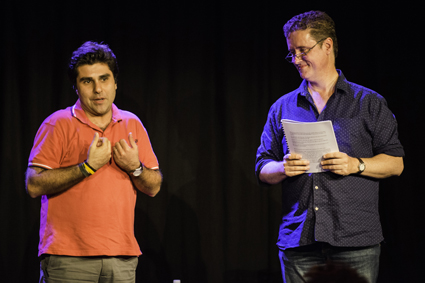
White Rabbit Red Rabbit, writer Nassim Soleimanpour stops the performance by Richard Fidler and introduces himself to the audience at WTF2013, Brisbane
photo Studio Impressions
White Rabbit Red Rabbit, writer Nassim Soleimanpour stops the performance by Richard Fidler and introduces himself to the audience at WTF2013, Brisbane
The performance history of this piece is as intriguing as the work itself. Soleimanpour has received national press coverage with this Australian premiere of his play. Despite the fact that the play has been performed in cities as far afield as Dublin, Edinburgh, Brighton, Calgary and San Francisco, this is the first time Soleimanpour has been granted a passport by the Iranian government and allowed to watch the work performed. Soleimanpour is the ‘I’ character in the script: it is written as correspondence to its imagined audience. A different actor reads the script each night. It arrives, delivered by a festival representative in a sealed packet. On the night I saw the show, it was ABC Radio’s Richard Fidler who ably executed the task. He is instructed by the playwright in absentia to do things like require the audience to number themselves out loud so that No 5 or No 12 might be asked to do things like improvise plot sequences or take notes of the performance so that they can be emailed to Soleimanpour to provide him vicarious experience of the show. Of course, this particular conceit was broken on this occasion by the physical presence of the writer. He leapt onto the stage to emotional applause at one point to acknowledge the fact.
The narrator, assisted by his team of audience conscripts, retells the story of Soleimanpour’s uncle who used to breed rabbits, painting one red and treating it preferentially. It is a psychological exercise in learned behaviour, as the white rabbits round savagely on the red rabbit. The upshot is that even when the inequity is taken away—the experiment suspended—future generations of rabbits still act according to the learned behaviour of their forebears. Prejudicial behaviour—even violence, and by metaphoric extension, war—is trained into us, the writer seems to be telling us. We hold onto ancient grudges even when we have no direct experience of the original point of conflict or resentment.
It is an extraordinary theatrical experiment, made all the more memorable on this occasion by the author’s physical presence rather than his haunting of a script he has never heard read aloud. It will influence writers, theatre stylists and experimenters of form and structure for years to come.
parah
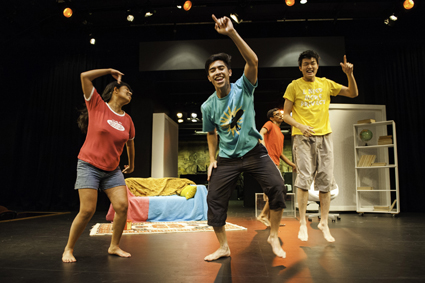
Parah, The Instant Café Theatre Company
courtesy the company
Parah, The Instant Café Theatre Company
In a post-show Q&A at the Parah matinee, director Jo Kukathas asked the audience if the surtitling of this piece had likely kept audiences away. Festival producer Zohar Spatz mentioned that at the 2012 WTF there were three foreign language productions and that it had been too tall an ask for Brisbane audiences; the festival was in the process of re-educating the local theatre-going community accordingly. If it’s true that language is determining which productions audiences choose—even at a festival themed by its focus on ‘new writing’ and the spoken/written word—it’s a shame, because Parah was an accessible and tightly crafted piece of dramatic writing.
Singaporean playwright Alfian bin Sa’at (whose 2012 MKA production of Sex. Blood. Violence. Gore has drawn several Green Room Award nominations; RT110) has a reputation for courting controversy. The Singaporean censor has not appreciated his frank depiction of (particularly queer) sexuality over the years. He writes in both English and Malay, and with Parah has provided the translation of the latter into the former. Taken from a real-life Education Ministry controversy, this is a student-centred play that examines racial prejudice in contemporary Malaysia. Ethnic Indian and Chinese minorities are the victims of racial stereotyping in a curriculum text, Interlok. Mahesh, Kahoe, Hafiz and Melur represent the Indian, Chinese and Malay communities depicted in the education text, and their own social cohesion is tested—indeed almost rendered asunder—by their responses to the allegations of racism in the school curriculum. This is a moving and beautifully acted piece; whilst the play is not the most radical of Sa’at’s works in either form or content, it has hit a cultural nerve in Kuala Lumpur and deserves a wider audience, particularly here in Australia where, as the festival producers are keen to remind us, the themes of racism, social cohesion and immigration are bound to resonate.
Melur provides an anecdote toward the play’s climax: her mother told her of a Malay lady from the end of her street who ritually cleansed her teacup after a Chinese tradesman drank from it. It is an elegant reminder of the sort of cultural prejudice that exists even in modern leafy suburbs. The four teenage friends survive the turmoil and play a real-life game of badminton in the theatre at play’s end, sharing water from the same bottle. It’s a gentle image that somehow encapsulates the heart at the centre of the writing, playing and direction of Parah.
Brisbane Powerhouse, World Theatre Festival 2013: Pan Pan Theatre (Ireland), A Doll House, writer Gavin Quinn, Feb 13-17; White Rabbit Red Rabbit (Iran), writer Nassim Soleimanpour, Feb 14-24; The Instant Café Theatre Company (Malaysia), Parah, writer Alfian bin Sa’at; Brisbane Powerhouse, Feb 13-17
RealTime issue #114 April-May 2013 pg. 45
© Stephen Carleton; for permission to reproduce apply to realtime@realtimearts.net
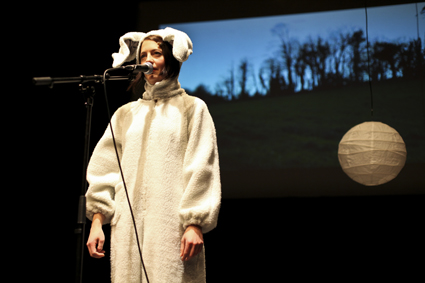
Sylvia Rimat, If You Decide To Stay, IBT13
photo Delia Spatareanu
Sylvia Rimat, If You Decide To Stay, IBT13
FRIDAY OR SATURDAY? SHOULD I BET ON RED OR BLACK? AN AISLE SEAT OR ONE AT THE BACK? THE DESIRED OUTPUT FOR REALTIME IS AROUND 1000 WORDS COVERING FOUR TO SIX SHOWS AT IN BETWEEN TIME. SO, HOW TO DECIDE BETWEEN ONE THING AND ANOTHER, WHERE TO START?
Before arriving in Bristol this decision is shaped both by my agency, and by structures that limit or influence my choices. Some decisions I take quickly, even subconsciously, others I deliberate over at length; rumination influenced by bias, reason, emotion and what is expected from me in this situation.
sylvia rimat, if you decide to stay
Decision-making is the explicit subject matter of Sylvia Rimat’s If You Decide to Stay, a performative lecture that meanders through personal experience, specialist knowledge and a loose set of experiments. Rimat analysed the types of choices we make on a daily basis and speculated as to whether these reflect what we really want. Listing the gamut of reasons that could explain our choice of seat within the auditorium, she then asked us to get up and choose a new one—somewhere we would not usually sit. I chose the middle seat of the back row and considered this to be a reasoned choice. However, the person I was with read this as an emotional choice, as it involved me moving closer to them (we were separated to start)—an audience predisposition that had already been described. Perhaps it was not one or the other, but rather a bit of both.
The complexities of decision-making were expanded upon: neuroscience, mathematics, psychotherapy and astrology formed tools to address the level of conscious choice we have and how much this is influenced through environmental, social and psychological cognition. However the work began to take a random turn. As The Clash’s “Should I Stay or Should I Go?” blared out, Rimat hopped around in a bunny outfit pondering some vaguely existential questions. This reflection on ‘not knowing’ appeared feigned. When Rimat said she did not know if there would be applause at the end of the performance, this consciously ignored the surrounding social structure that determined that there would be.
kim noble, i am not alone
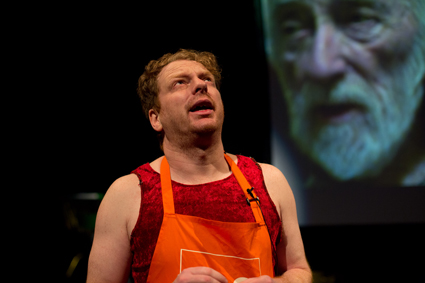
Kim Noble, I Am Not Alone, IBT13
photo Paul Blakemore
Kim Noble, I Am Not Alone, IBT13
Kim Noble’s I Am Not Alone presented a similarly dispersed narrative. As the audience entered, Noble was lying on the floor near the entrance. Wearing only a kitchen apron he simulated sexual noises, stating, “I just wanna be a woman.” This was followed by a rant about the couple living above him having sex (to which he responded by playing loud internet pornography back at them) and a detailed description of how he monitored another neighbour’s sex life. Acts of documentation extended to the minutiae of the artist’s life—from the text message he receives in Morrisons [supermarkets] to his taking a shit on a church floor—and border upon pathological self-obsession cum narcissism. Noble’s search for novel types of personal connection with others is deeply provocative and seriously funny, while being fundamental to his work. Noble chooses anonymous, banal individuals, for example Keith, a checkout assistant at the supermarket he has filmed for two years, or Dan with whom he forms a romance via a false female profile on Facebook.
The most extreme and sexually explicit relationship Noble forms is with a truck driver called John. John wants to fuck Noble, believing him to be a woman called Sarah. Noble adapts his behaviour in an attempt to impress John, sending him explicit texts and images in which he has fashioned breasts and a ‘pussy’ using parts of his own body. Noble juxtaposes this material with his relationship with his father, exposing him as a lonely, struggling old man with a nurse washing his arse. As Noble’s relationships descend into potentially humiliating territory—stalking Keith to his home, cross-dressing to meet Dan in a bar—the exploitation of himself and others is tempered by the sense of a kind of unrequited love. I Am Not Alone proved to be a paradox of a title. Noble is alone. Very much alone. As are Keith, John and Dan. The work deconstructs the reality of all our relationships, where characters and roles are performed and exchanged and affect is constructed. The performance comes to an end with the death of Noble’s father, brutally emphasising Noble’s pathetic failure to connect with anyone.
fiksdal, langgård, becker, night tripper
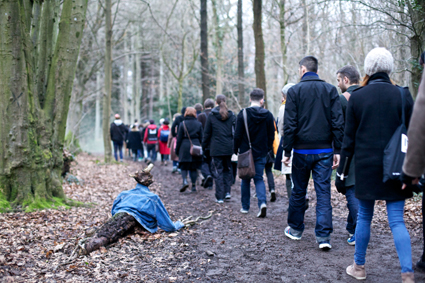
Night Tripper, Fiksdal/Langgård/Becker, IBT13
photo Oliver Rudkin
Night Tripper, Fiksdal/Langgård/Becker, IBT13
In stark contrast to these performance lectures, In Between Time offered an array of different formats. The course I chose transported me to the woods for Night Tripper by Fiksdal/Langgård/Becker, saw me wander through the sprawling exhibition survey, Version Control, and fail to find my role in Coney’s Early Days (of a Better Nation). Whilst Night Tripper was framed by ritual and a dream-like state of consciousness, this attempt at an all-consuming experience sometimes fell flat. The work was instead at its strongest pared back to its basic components: a minimalist dance aesthetic and accompanying sound from musicians and a hidden choir. In the transition from twilight to darkness, rolling, rocking figures, whining strings and droning hurdy gurdy offered cycles of repetition and a pleasing, numbing boredom.
coney, early days (of a better nation)
Coney presented a work in progress where the audience was set the task of collectively shaping a new nation. This aimed to reflect a wider political context of world events, and to get a hundred or so individuals to make decisions together. However, the narrative felt clichéd and the game mechanism was not strong enough to retain the audience within this performance fiction. From the outset the game structure and narrative did not facilitate the suspension of disbelief required to immerse us in the production of the work. Assigned groups tried to clarify what to do, as individuals drifted off, wandering aimlessly, acquiring additional wealth that was not then deployed with purpose. Over two hours the structure broke down, with video interludes and scripted oratory failing to bring it back under control; many now simply watching on as certain individuals chose to engage in familiar rhetoric, either exchanging rehearsed political positions or simply trying to disrupt them. (For another response to this work-in-progress see http://lettucemelodies.wordpress.com/2013/03.)
version control
The exhibition Version Control was an attempt to explore how a gallery can present performance and performativity, but resulted in an installation where the relations between works felt clunky, bunched together under broad groupings. This awkwardness was less apparent in work within the exhibition documenting Return of the Blogs, a two-week performance program from the collective Grand Openings at the Museum of Modern Art in New York. [The title Return of the Blogs refers to the documentation of the works in 2011—a daily account of the actions in the form of handwritten texts, fabricated objects, and audio podcasts presented in the gallery space and on MoMA.org. Eds.] It was an intriguing reflection on performance as a collective act, and live archive, within an institutional frame.
Over 1000 words covering five shows at In Between Time. The desired output is complete. Stop.
In Between Time 13, Sylvia Rimat, If You Decide to Stay; Kim Noble, I Am Not Alone; Fiksdal/Langgård/Becker, Night Tripper [Norway]; Version Control; Coney, Early Days (of a Better Nation); Arnolfini and other venues, Bristol, UK, Feb 14-17
RealTime issue #114 April-May 2013 pg. 23
© Niki Russell; for permission to reproduce apply to realtime@realtimearts.net
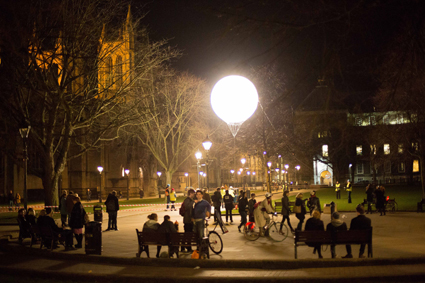
Fake Moon, Simon Faithfull, IBT13
photo Paul Blakemore
Fake Moon, Simon Faithfull, IBT13
A GANG OF MEN IN FLUORESCENT JACKETS MANHANDLED SOMETHING PALE AND UNWIELDY OVER COLLEGE GREEN IN THE TWILIGHT. A GLOWING WHITE BALL SECURED BY GUY-ROPES, POWERED BY A GENERATOR ON WHEELS, GUARDED BY PEOPLE IN TABARDS WARNING YOU NOT TO OBSTRUCT ITS DESIGNATED PATH.
simon faithfull, fake moon
As night fell the globe lifted above the rattling winter branches, high as the golden unicorn crowning the Civic Centre. Not quite as high as the turret of the Cathedral—definitely not as high as the waxing silver arc far above—but huge, soft and luminous, an accessible wonder. This extra moon would shine for the four nights of the festival.
College Green filled up with people diverted from their evening commute to stare and wonder, to take photographs and pause for a moment before catching the next bus home. A busker set up shop at the entrance to the Green. Above, the real moon exposed the fakeness of the apparition just as the work-jackets and guy-ropes worked a lovely little Heath Robinson analogy on the processes of artifice.
Simon Faithfull spoke later of his interest in “myths and illusion,” of “lying to tell the truth.” In this numinous piece of fakery the clearly visible apparatus of the illusion flickers in and out of awareness as though it were a mirage.
nic green, fatherland
Seven drummers and a piper stood in the dark. Lights up: a woman came forward dressed in a grey short-trousered suit with a heather-coloured tartan trim on the waistcoat. She spoke.
“Father, what is space?” Answers appeared projected above her and she asked the fathers in the room to speak them. Falteringly they acquiesced, in minutes becoming a strong chorus. As the performance progressed we all joined in, we all became the responder, the provider of an answer, the location of a dubious heritage.
She described her last meeting with her father, devoid of much feeling or connection. And we the chorus said, “I am visible only as land. I grow quieter. And firs, rough hillsides, drumbeats and drones.”
She described a circle in chalk on the floor. She took off her jacket with its tartan frill at the back. As one after another of the drums joined in beating a rhythm she paced, then ran, then sprinted round the circle, shrugging off her clothes; till wearing only navy-blue stretchy polyester pants with a tartan frill on the bum she gathered herself into the centre of the circle. As the pipes began to play she jumped and pranced and kicked: a strong, luminous, wild, proper body. She flung her arms up and down, stamped and twisted, ribs and muscles working, the tartan fringe flying.
When the dance was finished and the drumming over, she sat on the floor in a lone spotlight and stripped. She unwound the circle, walking widdershins, and handed bottles of whiskey into the tiers of audience for us to share. The pipes were now only droning.
Standing naked she sang in Gaelic. No need to understand the words. Heather, whiskey, islands and mist and loss, elements of the Celtic twilight—and a glimpse of a brusque masculinity hung on a scaffolding of nylon, tweed, stubble and greyness, shielding the view of the moors beyond. Only a glimpse of flesh muscle and bone shining; hard to uncover, but she’d done it; hard to invoke but she joined us all into the fire of that tribalism.
We drank while she was singing. Then she sat and drank her whiskey, looking at us. She and her drummers left the stage and she had the piper play us out.
reckless sleepers, a string section
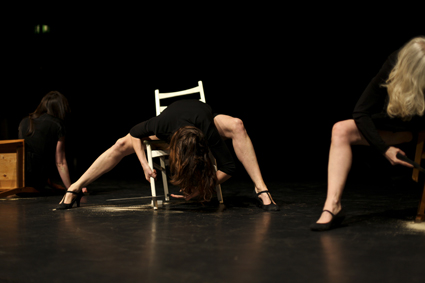
A String Section, Reckless Sleepers, IBT13
photo Delia Spatareanu
A String Section, Reckless Sleepers, IBT13
As this was the opening performance, the room was full. We’d been encouraged to circulate so I sat at the back waiting for the forest of legs and backs to disperse, but they never did. We at the back heard applause when the performers entered; we heard sawing sounds, raspy and unexpectedly harmonic. The tinkle-clunk of a bit of wood hitting the floor. I weaselled my way to the front.
Four women, sawing the legs off the furniture they are sitting on. They wear black formal dresses, heels, make-up. They are smart, maintaining balance on the aforementioned destabilised furniture. Those women who fall off, get back on their chairs again. Displaying control, ingenuity, determination and grace in the face of inevitable pratfall, and, like a thrumming of cello players, quite suggestively sexy.
jo bannon, deadline
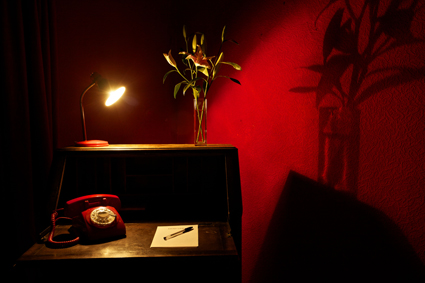
Deadline, Jo Bannon, IBT13
photo Oliver Rudkin
Deadline, Jo Bannon, IBT13
In Deadline one is ushered through meditative spaces from an airy, comfortable waiting room to a red study, to a seat by the window of a white room looking out on the wintry sun of an open cityscape. At each stage one is nudged into a thoughtful frame of mind by having to wait, by vases of lilies and related literature scattered around and by the concerned, considerate air of the guides/invigilators.
In the red study the phone rings and after completing a short questionnaire you can ask one of the experts at the other end of the line three questions. I got the Doula, the Midwife for the Dying. When, enlightened, you put the phone down, you are led to the white room to stare out of the window. The view is framed by lights gradually brightening round the window, and by urgently building noise.
It is a detaching experience: there is tension in the ringing of the phone, the building of noise in the white room. For a moment one anticipates the unknown, surrounded by props of the familiar: a telephone, a desk, a voice, a view of the city. An exercise in the practice of resilience.
zierle & carter, chamber made opera, living room opera
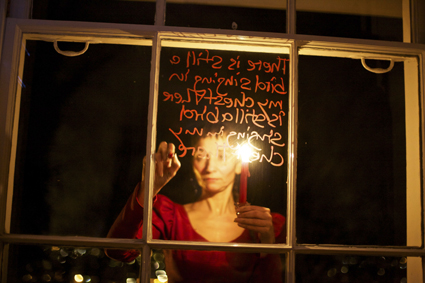
Living Room Opera, Zierle & Carter, Chamber Made Opera, IBT13
photo Oliver Rudkin
Living Room Opera, Zierle & Carter, Chamber Made Opera, IBT13
Flashbacks: we’re being guided through the night towards the venue, city lights spread below us, twinkling. A man in evening dress leans from the warmth of an upstairs window with a rope dangling from his neck. He rotates his neck and body, drawing up a crimson dress till it envelops him.
A tall woman greets us with the sound of birdsong captured in a china teapot. Buttoned up like a spectral Mrs Danvers, she moves slowly backwards drawing a pair of men’s shoes after her, conjuring a disembodied follower. We still can hear birdsong.
A kitchen permeated with the smell of tea, oranges and bread baking. The rattle of a magpie. Recorded voices coming from behind furniture or plant pots or from within cupboards; reflective voices telling slow stories of how they got to the house they grew up in, how they left it, who lived there, who built it.
A man with a clock case strapped to his head. The pendulum is stifled with salt. He opens the case and brushes the salt out with his fingers—time lies in heaps on the carpet, stilled. A heartbreaking excavation into a frozen past.
Upstairs in an anxiety of ambient sound, the young man stands maniacally scraping burned toast, his hair over his face tied in a thick knot by the hangman’s rope curving over the floor.
She, the hostess, now in the crimson dress, crawling towards him, seizing the rope, contorting her body….He, presenting her with a miked-up basin of milk, she plunging her face in it, howling, grunting and gasping.
A knot of bones, antlers and feathers falling to the floor.
From the balcony outside she draws on the window in red lipstick till a square of it is covered in overlapping scrawls. She looks like a revenant, a haunting, a fetch.
Histrionic, yes. As memory is, always making drama out of crisis, and narrative out of routine. Opera indeed.
And also, like entering grandmother’s cottage in the woods: come in, keep warm, have some tea and an orange…you don’t have to look at the bones too closely, though since you left, they lie heaped in every corner.
In Between Time festival: Simon Faithfull, Fake Moon; Nic Green, Fatherland, director Deborah Richardson-Webb; Reckless Sleepers, A String Section; Jo Bannon, Deadline, original concept Jo Bannon, Lucy Cassidy; Zierle & Carter with Chamber Made Opera, Living Room Opera; Bristol, UK, Feb 14-17
RealTime issue #114 April-May 2013 pg. 24-25
© Osunwunmi ; for permission to reproduce apply to realtime@realtimearts.net
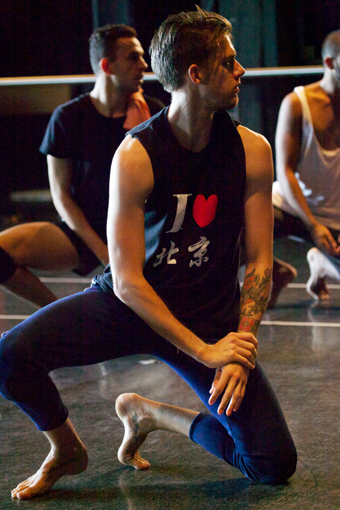
Daniel Riley McKinley (foreground), Kaine-Sultan Babij, Blak rehearsal, Bangarra
photo Greg Barrett
Daniel Riley McKinley (foreground), Kaine-Sultan Babij, Blak rehearsal, Bangarra
I MEET YOUNG INDIGENOUS DANCER AND CHOREOGRAPHER DANIEL RILEY MCKINLEY TO DISCUSS SCAR, HIS CONTRIBUTION TO BANGARRA DANCE THEATRE’S NEW WORK BLAK, WHICH ALSO FEATURES A WORK ENTITLED YEARNING BY ARTISTIC DIRECTOR STEPHEN PAGE AND KEEPERS, A PAGE-MCKINLEY COLLABORATION. A GENTLE PRESENCE, MCKINLEY EXUDES A PALPABLE PHYSICALITY IN HIS DEEP-SEATED ENTHUSIASM FOR HIS NEW CREATION, A COLLABORATION WITH SIX MALE DANCERS ON THE SUBJECT OF THE TRANSITION TO MANHOOD.
In the rehearsal room, McKinley speaks quietly, unhurriedly, checking on moves previously established, homing in on details, watching himself and the other dancers in the studio mirror as collective movement takes shape—elbows thrust out, hands reaching back in, claw-like, flexed sharply at wrists. An arm angled across the torso becomes a fixed line against which the body, dancing from a low centre of gravity, rises and sinks. There’s a meticulousness and fluidity in the detail which was also evident in Riley, the work McKinley (RT 94, p4) choreographed as part of Bangarra’s Of Sky and Earth (2010). I wrote at the time that there was “an inventiveness and welcome unpredictability in [McKinley’s] choreography.” McKinley tells me that with Scar he’s not simply creating a work but generating a dialogue among the men in Bangarra.
Tell me about the subject of the dialogue you’ve started with the men in the company?
I was really interested in creating something fresh and something contemporary around the subject of Indigenous boys going into manhood. Obviously it’s inspired by traditional initiation ceremonies, that transition from boyhood to manhood and how it works in traditional communities with the scarring and the boys being sent into the bush and having to make their way back. They’re told stories and taught songs and their level of responsibility changes.
For us, as contemporary Indigenous young men or boys, I feel it’s not so clear-cut because of this crazy world. If we live in Sydney, a beautiful city, we’re not consistently with culture. I get my daily culture fix coming to Bangarra. This is the reason I’m here, the reason I dance here, the reason I wanted to join Bangarra when I graduated from QUT—to learn about, to get culture.
Through dance?
I love dancing and I found out about my Aboriginality at quite a young age and for me, dance was that exploration of what it meant to be an Indigenous male. Every day is a learning experience. I leave here at Christmas holidays every year and I look back and think, “I’ve learned so much this year.” Stephen (Page) is the same. He’s consistently learning too. And the culture is constantly changing. There’s 40,000 years of culture to learn from and we’re always trying to find what it is.
And where you sit in it?
For me (in Scar) it was about trying to find out what the transition was for us from boys to men. It’s something I’ve thought about a lot since I joined Bangarra in 2007. Being a young first year dancer, you’re taught everything. It’s almost like you’re the youngest brother of the seven boys. So, you look up to your brothers. They’re older and they’ve got the knowledge and they’ve lived more and they have all the experience. I wanted to know when was that moment for me. I still wonder, when will I reach it? Have I reached it? When was that moment? Is it a series of steps? Is it a set of experiences that you gather together and put in your pocket and carry with you?
As choreographer you inevitably play a senior role.
Yes, of course. I’m in my seventh year, so I’m recognised in the company as a senior dancer, which I still find quite strange because I’m only 27. I think, a senior? Whoa! I’m choreographing, and dancing in the work too.
You didn’t dance in Riley, your first work, did you?
I wanted to be able to step away from it, to be able to view it as an audience whereas with this work, I want to experience it. I want to be the conductor but also be part of the band. I’m not creating every step—more just directing, forming and shaping things. So, it’s a huge collaborative effort because of the subject matter. It’s a personal thing, so I can’t exactly say, “do this or do that” or “no, that doesn’t feel right.” If (something) feels right for Waangenga (Blanco), then he should be able to do that.
So each of the dancers has a different idea of where they are in the manhood trajectory?
Exactly right, because we’re all within a 10-year gap. Waangenga is almost 30 and as a guest artist we’ve got Hunter Page-Lochard, Stephen Page’s son, who’s about to turn 21.
Have some of the dancers had more traditional experiences or are they largely from urban backgrounds?
We all grew up urban. Waangenga had a lot of connection with his Indigenous family and customs through the Torres Strait. Lenny (Mickelo) was connected to his Indigenous family but I’m not sure whether he learned dances or not. He lived in Brisbane and in Cherbourg. We’ve all had a mixed bag of experiences. We’ve all come from different places and we’re creating this gathering place onstage and in the rehearsal room.
It’s a really broad subject. What I find difficult is to bring it into one half-hour work. Obviously it’s not going to answer the question. I guess it will pose more questions. But through the course of the work, as men and boys onstage, we will go through that transition. So, it’s going to be a journey every night for us.
Presumably, even though you may not have experienced traditional life first-hand, you’re still drawing on it—there’s such a long tradition in Bangarra of spiritual advisors and investigation.
Of course, everything that Bangarra does is ingrained in that tradition, ingrained in culture. Djakapurra who’s performed with us many times has scarring between his pecs. Having danced with him a few times, I was just so interested in what they were. We got talking and that’s when I thought, well, maybe I should do a new ‘men’s work.’ I think the last men’s work at Bangarra was 2001. Stephen did Spear which was part of Skin. That’s a huge inspiration, but I’m reeling it in to where we are today as contemporary men. [Imagine] we’re a group of seven Indigenous boys walking the streets of Redfern. You look at them and think, “Where are they going? What’s their journey going to be?” They’re unlikely, in the city, to get traditional initiation. If they’re lucky enough they might get to go to the bush to do that. When will their responsibilities change?
To do this, have you adopted, as in Riley, a series of images to work to or is there a narrative?
There’s a sort of a story arc. I’m trying to stay away from vignettes. With Riley, it was very clear-cut. I had Michael Riley’s images that are so incredibly beautiful and they each had a story of their own anyway. [This time] I’d go home each night and think, “What am I trying to say?” Am I trying to take the audience on a journey or the dancers? I came to the decision that I’m going to take the dancers on a journey and the audience are voyeurs. It’s like they’ve stumbled across this gathering of boys going through this ceremony, the rite of passage, together.
Is there a sense of ritual in the work?
Absolutely. We will be doing some traditional dance and we’re using Djakapurra’s voice, but the rest of the sound is contemporary. I’ve got David Page and Paul Mac doing the music. So it’s really electronic and bassy. I was really inspired by those grimy, dirty hip hop instrumentals, bands like Clams Casino and those dirty beats for ASAP Rocky and other rappers out of America. A lot of Indigenous kids listen to that music. That’s the music of their generation. And I listen to that. It’s got this ‘attitude,’ this ego and pride behind it.
There’s a lot of vulnerability in this state as well, isn’t there?
Absolutely. The boys and I have talked a lot about that and what that vulnerability is and where that happens. We spoke about pre- and post- adolescence and what manhood is and who you look up to and who you see as a man and why. When you’re in high school, you’re trying to be yourself, but people are judging you. It’s so difficult. Even now, we’re still vulnerable. So, we’ll definitely be exploring that.
Will the seven performers each have a discrete persona?
Because the boys are creating the movement, they’re gonna be themselves. But in another sense I sort of see us as six different sides of Hunter. He’s the youngest and closest to the age we’re exploring. We’ve always had spirit guides in Bangarra—Aunty Kathy Balngayngu Marika and Djakapurra Munyarryun—but I’m sort of going to touch on a younger one, a boy who’s conducting it and who connects us and pulls us through this story. Hunter has done all his NIDA courses and films and TV shows, so his acting ability, that’s something I can draw from. And his dancing too (he’s studied ballet), it’s a good challenge for him. He loves Bangarra and he’s a great kid and we love him. It’s nice to have this youthful energy in the room. It looks so raw on him.
What about design?
Quite sparse. I’m just having a black box. [Jacob Nash’s] design for Riley was white and open. With this there’s a feeling of being more under the earth, in an underground club with this driving bass. It’s dark and moody. A few props, but mainly the light will dissect the space; the lighting (designer Matt Cox) will dictate space and shifts in mood.
And clothing?
Again, very simple and contemporary. There are so many images: the 2011 London Riots—young boys running (through) the streets in hoods. It was like they could put them on like their invisibility cloaks. We spent two weeks in Arnhem Land a month ago. We love going up there. We learn traditional dance around the fire, we sit with the kids and we just hang out with them, do what they do, find out what they get up to on these small outstations. It’s amazing how they fill their time even though there’s nothing to do out there. They sit and chat, play basketball…Looking around at what they wear, it’s all mismatched—big baggy basketball singlets and shorts, socks with thongs and hats, sunglasses at night. Their idea of fashion is really cool. You look at it and you think, well it sort of doesn’t work, but then it works on you. It helps to have their beautiful dark skin; all the colours they wear look so amazing on them. We took lots of photos when we were up there. Luke Ede is the costume designer and he’s looking at all that.
Transition into manhood in Indigenous traditional culture is men’s business and is full of secrets. Does that play some sort of role in this work?
I spoke to Djakapurra about it before we started, asked him about what traditional dance we could have for it and what song. He said there are some songs that I can’t give you. I said that’s completely fine. So he’s come up with a song that suits (the work) and a dance…the meaning of it is really poignant, really beautiful for what we’ve come out of and what we’re going into. It’s a water dance, for cleansing—the post-ceremonial dance. Goosebumps. It’s quite powerful. And the song is incredible. I sat next-door as Djakapurra recorded it at David’s [Page] studio. His voice is so incredible.
[As for the arc, in Scar you’ll see] seven men dancing. Okay, cool: they’re dancing and they’re together, but then they look frustrated. We’re going to dive down into that deep, dark hole, (into) that physical and mental frustration. We’ll rise out of that hole: “Ah!,” when it’s almost like a light [turned on]. Yes, we’re finally almost there. We’ll reach a kind of euphoria—in whatever form that will be at the end of Scar. There’s a story, a shape. Now we’re at work just colouring it.”
Bangarra Dance Theatre, Blak, National tour: Arts Centre, Melbourne, May 3-11; IPAC, Wollongong, May 17, 18; Drama Theatre, Sydney Opera House, June 8-22; Canberra Theatre Centre, July 11-13; QPAC, Brisbane, July 18-27; www.bangarra.com.au
RealTime issue #114 April-May 2013 pg. 36
© Keith Gallasch; for permission to reproduce apply to realtime@realtimearts.net
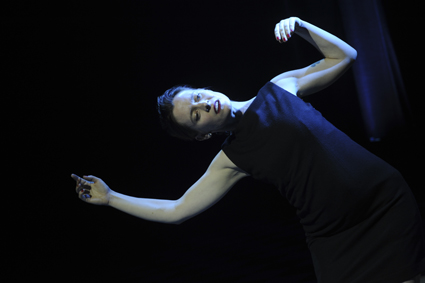
Jane McKernan, Slow Dances for Fast Times, Carriageworks
photo Heidrun Löhr
Jane McKernan, Slow Dances for Fast Times, Carriageworks
SLOW DANCES FOR FAST TIMES IS A COMPILATION OF “CHOREOGRAPHIC PORTRAITS” IN WHICH CHOREOGRAPHER MARTIN DEL AMO COLLABORATES WITH 12 AUSTRALIAN DANCERS. A “SINGLE CHOREOGRAPHIC IDEA” IS THEN EXTENDED AND MODELLED INTO “MINI-ACTS OF SOLITARY DEFIANCE” (PROGRAM).
Designer Clare Britton creates a velvety vaudevillian palace. Red carpet, red curtains, roaming spotlights and rolling projected text create a place of history and burlesque. Already there lurks a joke, for del Amo’s choreographic repertoire is the antithesis of varietal entertainment. This contextual tension creates a coherent performance that slips between the serious and the silly, between the committed and the parodied.
Some of the ‘portraits’ navigate this tension with surety. This assurance is most notable in the last of the 12 solos, danced by Jane McKernan. While the sublime Kiri Te Kanawa sings Mozart, McKernan manages to simultaneously conjure del Amo’s signature minutiae and live up to the spectacle of the voice. Holding a static kinesphere throughout she makes minuscule adjustments, creating new physical stories, states and shapes out of the almost imperceptible, rearranging the lines of her body into bright and new contortions, born deep within. One foot is turned slightly in, one knee slightly bent, one arm held uncomfortably out, distended, making the subtle torture of unease while her head dances the dance of rapture. At times McKernan’s being is an orchestra of parts speaking to each other as she floats off kilter. At other times these parts break away from each other as the deep seated pressure of excruciating movement makes apparent the tremors that are allowed to exist in del Amo’s world. This solo of seductive and rapturous crucifixion was a fine finish to a long show.
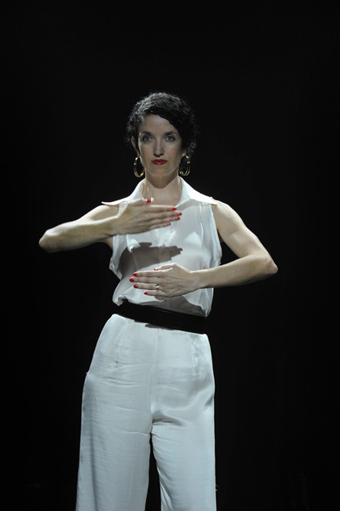
Elizabeth Ryan, Slow Dances for Fast Times, Carriageworks
photo Heidrun Löhr
Elizabeth Ryan, Slow Dances for Fast Times, Carriageworks
Solos danced by Luke Smiles, Sara Black and Kirk Page are revisited versions of earlier works: “birthday present[s]” from del Amo to dancer friends. Involuted light heartedness becomes satiric as highly skilled dancers move about as children or chorus line drunks, in a display of anti-technique. This was made more patently clear in the ‘bonus track’ finale, a new ensemble choreography where the salient formations and styles of well known local dance companies are gently, fleetingly, but clearly lampooned.
Certain choreographic and political strands emerged from this evening’s retrospectivity: self-referencing, political possibilities of movement and commitment to clearly refined and recognisable physical techniques. Certain recurrent physicalities reveal del Amo’s choreographic proclivities: the gentle distortions of discomfort as bodies are drawn away from graceful wholeness. The circular transcriptions of space seen in the endless running round the floor patterns and in the arcing of dancers as they sweep around their own axis in that discombobulating ongoingness that makes these solos fade rather than end. Then there are those floating arms that trace, dangle and sway as body parts with mind. These arms are what most conjured the choreographer-body, making me miss Martin.
Martin del Amo, Slow Dances for Fast Times, choreographer, director Martin del Amo, dancers Sara Black, Jade Dewi Tyas Tunggal, Benjamin Hancock, Raghav Handa, Julie-Anne Long, Jane McKernan, Sean Marcs, Kirk Page, Elizabeth Ryan, Luke Smiles, Vicki Van Hout, James Welsby, design Clare Britton, lighting Matthew Marshall, sound compilation Marcus Whale, production Performing Lines; Carriageworks, Sydney, March 6-9
RealTime issue #114 April-May 2013 pg. 38
© Pauline Manley; for permission to reproduce apply to realtime@realtimearts.net
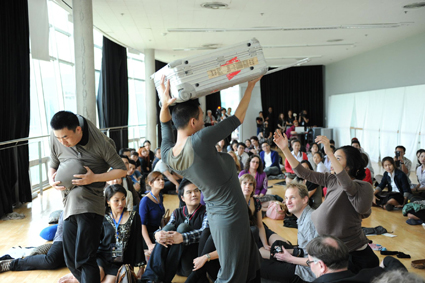
On the Road Again, Cai Ying, courtesy Bangkok University
ONE OF THE TASKS OF THE WORLD SYMPOSIUM ON GLOBAL ENCOUNTERS IN SOUTH-EAST ASIAN PERFORMING ARTS, WHICH RECENTLY TOOK PLACE IN BANGKOK, WAS TO BRING TO THE SURFACE THE TRANSNATIONAL SOUTH-EAST ASIAN ARTIST. AS THE INTERNET HAS SUCCEEDED IN BRINGING CIVILISATIONS CLOSER TO EACH OTHER, IT IS INTERESTING TO FIND WHERE AND HOW SOUTH-EAST ASIAN PERFORMING ART POSITS ITSELF IN AN UNDENIABLE WAVE OF MODERNISATION AND GLOBALISATION.
The papers presented at the conference displayed these preoccupations, as in the research of Parichat Jungwiwattanaporn on the work of Pichet Klunchun; Bethany Collier, who noted contemporary methods for the new generation learning the Balinese Arja; Miguel Escobar Varela on using hip hop music with the Wayang Kulit; Shreyosi Mukherjee looking at a Malaysian Mak Yong adaptation of Shakespeare’s A Midsummer Night’s Dream; William Petersen, who is enchanted with the contemporary aspect of the otherwise traditionally Tagalog senakulo; and, among many others, Tiffany Strawson recounting her first-hand experience of learning the masked dance topengpajegan. However, in the symposium performances Asian theatre maintained its traditional veneer.
Bangkok University’s Communication Arts Complex provided diverse choices of venues for performances. Traditional performances, including a charming Cantonese opera and the Balinese Barong-Rangda dance, were staged in the amphitheatre in the centre of the complex. Shadow puppet plays and three-hour heavy dramas were held in auditoriums. All the drop-in installations were located in small and medium-sized studios.
plant me a word
Patricia Correa, from Portugal, presented Plant Me a Word, which required little movement, in a small, carpeted room. Seated at a small wooden desk with her feet planted in a pot of soil, Correa looks around the room and invites a spectator to sit before her. Once seated, that person becomes part of the work. Correa immediately hands them a leaf and instructs them to “plant me a word” on it. Any word will do, it seems—she puts the entire leaf in her mouth, chews and swallows, all the while maintaining intense eye contact.
The onlooker wonders about the significance of the pot of soil, and what could happen if you asked Correa a question or kept her from putting the leaf in her mouth, or whether the leaves and ink might eventually poison her. But as she scans the room for the next participant, curiosity is replaced by terror—split-second terror of having to join in the work and forfeiting your position as audience. Whatever her objectives, Correa’s attempt to take the audience out of their comfort zone and into the work itself was quite successful over its three-day duration. The audience appeared to be helping her to ‘grow’ with the words they planted. There was no exchange of ideas; the work was a push to get ideas and words out of her participants’ bodies, to take root and grow with the tree that is Correa.
drawing your attention
Liesje van den Berk (Netherlands) set up a room in which lights hit a glass wall so that she could ‘draw’ the shadows of those who came to view her installation. She moves quickly, outlining the shifting, shadowy figures. Van den Berk also seems to simultaneously respond to guitarist Jeen Gert Rabs’ soundscape.
The point of Drawing Your Attention is not the finished product, though Van den Berk, primarily a visual artist, is definitely interested in that as well. Its value resides in the performance. The audience members whose shadows are being drawn on the wall are instantly performers, some accommodating Van den Berk by posing, so that she has more interesting shapes to outline.
thai tracings
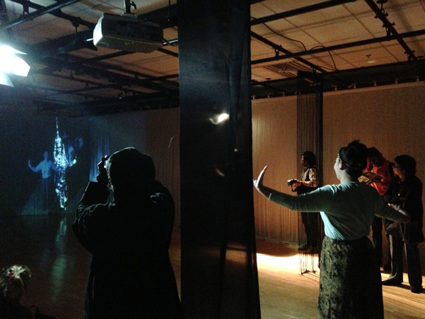
Thai Tracings, Sarah Rubidge
photo courtesy Bangkok University
Thai Tracings, Sarah Rubidge
At a Western conference, a new media panel would be bursting at the seams. However, the one in this symposium attracted only minimal attendance, while most participants were at the “Traditional Performance in a Changing World” panel conducted in the next room. South-East Asia is only starting to discover new media, as evidenced by the papers and performances presented.
The new media panel keynote speaker Sarah Rubidge (UK) discussed the progress of digital media in the development of contemporary dance. She provided a more intimate view of these digital trends with her installation, Thai Tracings. Images of classical Thai dancers were projected onto the walls of the studio, sometimes against an aerial view of Bangkok’s cityscape. To further blur the boundary between classical and contemporary, there were intervals where a live-feed of members of the audience standing in the room was projected on a screen beside the classical dancer.
With the recognition that the viewers are now part of the work, the screen presents the audience-performance relationship in its purest form, spectator and spectacle side by side on one panel. But once the realisation sets in, the dynamic is changed, by varying degrees: delight, fright, feigned disaffection. Some, interestingly, start to dance along with the projections, doing the same traditional movement but in street clothes.
on the road again
In Hong Kong choreographer Cai Ying’s On the Road Again, the performers move around the audience seated on the studio floor, interacting with them such that they become part of the performance and some of their reactions dictate the action. After circling the room holding carry-on luggage, the choreographer and her dancers stuff their clothes with travel pillows and melt into lethargy, as if turning into the pillows themselves. The performance is based on the artist’s dreams about the many journeys she’s taken. At the end, the dancers run out of the studio, leaping across a field we can see through the window and beckoning us to join them (we didn’t).
a mask for a shadow puppet
Hanuman Meets His Father is an elaborate Wayang theatre experiment where the shadow puppet play and the masked dance drama occur on the same stage. It was quite electrifying when the masked actor playing Hanuman suddenly leapt onto the stage from behind the screen of shadows—the last thing you’d expect, and yet it did not feel out of place.The scholars studying Indonesian theatre were astounded and immediately wanted to know how older generations of theatre practitioners might react. The Wayang Theatre of Bali has yet to perform this for the locals, but is optimistic.
Perhaps to Western practitioners, this may not seem as groundbreaking as it does to South-East Asian artists. Informed by a strong sense of tradition and yet reeling from the effects of colonialism, South-East Asians have the burden of bridging the gap between past and present, between where they live and where they can practice their art. Just how they’ll get there will be interesting in practice, and as a topic for a future conference.
World Symposium on Global Encounters in South-East Asian Performing Arts: Plant Me a Word, concept, performer Patricia Correa, Feb 1-3; Drawing Your Attention, visual artist, concept, performer Liesje van den Berk, music Jeen Gert Rabs, Feb 1-3; Thai Tracings, concept, digital execution Sarah Rubidge, Feb 1-3; On the Road Again, choreographer Cai Ying, Feb 1; Hanuman Meets His Father, director I Wayan Dibia, performers the Wayang Theater, Bangkok University, Thailand, Feb 3
RealTime issue #114 April-May 2013 pg. 38
© Joelle Jacinto; for permission to reproduce apply to realtime@realtimearts.net
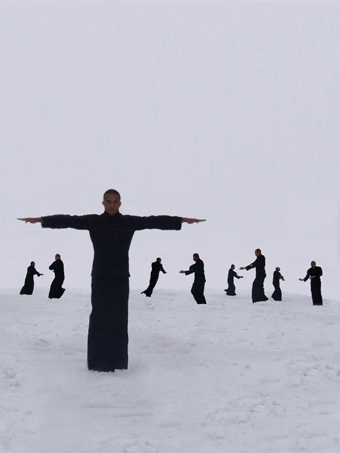
Lemi Ponifasio, Birds with Skymirrors, MAU, courtesy the company
AT A MAU PERFORMANCE YOU JUST HAVE TO LET YOURSELF BE, OPENING YOURSELF UP TO AN OSMOSIS OF STRANGE SOUNDS AND MOVEMENTS SEEPING INTO YOUR VERY BEING. ARTISTIC DIRECTOR OF THE AUCKLAND-BASED COMPANY, SAMOAN LEMI PONIFASIO BELIEVES THAT OUR LIVES ARE DOMINATED BY DOING AND ACTING, BLINDING US TO “THE INVISIBLE DIMENSIONS OF OUR LIVES”—OUR CONNECTION WITH THE EARTH, OUR BEING AT ONE WITH IT.
I spoke with the witty and erudite Ponifasio by phone about his internationally acclaimed Birds with Skymirrors, part of Carriageworks’ 2013 program, first asking him if each of his works is initially triggered by an image. I was thinking of the press releases and interviews that reveal that it was the sight of a frigate bird trailing shining videotape (the skymirror of the title) from its beak that initiated the making of the work. “Well,” he quips, “it wasn’t a Saul of Damascus moment, but it gave me an idea.”
What kind of idea?
Fantastic things. All kinds of terrible things. It was very funny because I thought, at first, what a beautiful sight, and then became quite afraid, because I suddenly felt alone and wondering what was happening. [The birds use the tapes for their nests; but this kind of pollution kills massive numbers of birds and animals across the Pacific. Eds] Then you start to think about everything in life from ancestors to all kinds of civilisations. I was thinking about Botticelli, the Venus picture; I felt this image of innocence had turned into a whore. I thought about the Persian poem, The Conference of the Birds. Your mind wanders everywhere. It was a moment you feel the world is so big—that kind of connection. I’m not trying to tell anybody not to pollute the water. It’s simply about our connection, the genealogy that we share with birds. We are part of the [lives] of birds. That is [the kind of connection] I try to make with my work.
I’ve read that you’re very keen for the audience to enter a contemplative state; you don’t use narrative because you don’t want to impose stories on people.
The theatre has become too human and is about people’s storytelling and people expressing people. I think the theatre is more than that. It’s a cosmological experience. I’m sure the origin of theatre was our feeling this intense bond with existence so that we get up and sing or perform. So the theatre I try to make is about how to return you to or take you to a dimension that is not about human time but more about cosmological time—how to get you away from the phenomenal world, the world of everyday into the noumenal, which is a much bigger world.
In essence, to stop thinking just about oneself? You said in one interview that you thought that Western theatre was simply narcissistic.
No! (LAUGHS). But I do think the theatre is not for mirroring life; it’s to shatter the mirror that we’ve created for ourselves. The mirror of life is really what we construct in our heads. That’s our ego. And I think the invitation of the theatre is an invitation to be. And that’s a really hard thing for the human being, but it’s part of our title as ‘human beings.’
There are practices and concepts in your work that appear to come directly from your own culture. How do these figure in your thinking?
Well, it might sound strange, but I don’t think I come from a culture. I think my arrival on the Earth was on the island of Samoa. I just arrived there and I don’t think so much about culture and cultural identity.
But you certainly draw on it.
It’s what I know.
It’s a part of you?
It’s pure form, but I know it along with knowing what’s happening in New York or Algeria or Iraq. So it’s a consciousness. It’s not something particular to a culture, I don’t think.
So the work is not going to say to an audience, do something about climate change, but I assume it’s part of the work’s ‘subconscious.’ The people who work with you, your community, some of them would come from islands, I suppose, that are in danger of disappearing under the ocean in years to come.
Well, I think there is a bigger thinking, something more than just cleaning up the rubbish or hugging trees or buying organic. I think this is a very childish way of dealing with climate change. We need to think in terms of our relationship with the world. The closer we feel the connection, the more we appreciate that we are just part of the process of nature, we can somehow understand the intense link that we have with nature. For example, a dog is a dog but if you take a dog as your puppy, then you have a strong sense of relationship. I think that is what I’m trying to do—to bring you to the present, to just be present and by being present you can become more strongly aware of this.
Like the notion of ‘just being’ rather than doing and acting?
Well, it’s a consciousness. I could take you to an English garden that’s full of roses and you can look at it and admire it; or I could take you to a Zen garden where there is nothing but stones and a rock. You’re standing there and you feel differently. You attend to your existence—why am I here? So, it’s the power to bring forth an experience of presence and being conscious of one’s being.
Elsewhere you’ve described Birds with Skymirrors as being like “the last dance on Earth,” which sounds very apocalyptic, and ritualistic. A review in New Zealand described your work as “an ancient futuristic ritual.” This idea of ceremony seems to be important to you.
I say to the people I work with, “If this is the last dance or the last song, what are you going to sing about?” Are you going to sing about your iPad or your iPhone? No. We are going to sing about something very important to our lives. So this dimension of one’s life is why I talk about the last dance. I think the audience who come to the performance must not come merrily like they’re going on a dinner date. It’s like a pilgrimage, going to the theatre. There is something that you come to engage with; there’s something that you bring; there’s something that you want to be with.
There’s a difference between ceremony and ritual. I’m not interested in ritual. People always say ‘ritual,’ but a ceremony is when we come to engage, because there is a reason why we gather, an important step in one’s life, whether it’s a funeral or a birth. In ceremony we elevate ourselves into another sort of sense of ourselves. And I think the point of the theatre is to remind the soul of its higher self, a higher space.
My performers are not necessarily trying to express anything. They are there to serve the ceremony, to serve the space. Their bodies are ceremonial bodies—that’s how I prepare them. Of course, they have to do what they need to do well, but their presence, their activation of the space, it’s the whole point of going to the theatre, performing for it.
You don’t talk a lot about dance or art or artists, but I was astonished by the variety of gesture and movement in your work, the sense of a melding of physical movement and dance from across the region.
I work with people who don’t have Western training. They are all from communities. They know the language of ceremony, the movement of ceremony, the presence of ceremony. This is why I like working with them—because of the amazing knowledge you don’t need to teach anybody. You can’t learn that from art school.
In the performance there is tremendous individual sensuality and sinuousness, extreme body states and a great sense of synchronicity, of meticulous movement together. These people must spend a lot of time with you to achieve that sense of unanimity.
It’s a very strange thing to say, but we don’t practice that much. We do other kinds of work. We think it’s much more important than going to the dance.
What other kind of work is that?
Being part of the community. I make them go and do what they do normally. That gives you the sense of a different way of being. I want the dancers to be the stage, not dancing on the stage. It’s a different quality. I think it’s a proposal of the theatre. We need to move away from a theatre that is too much about the human and loses its power because it’s just humans talking to humans, like soap opera, instead of humans talking to the divine.
* * *
After seeing MAU’s The Tempest in the 2010 Sydney Festival I wrote, “Walter Benjamin’s angel of history wanders the stage screaming; a group of monks glide about in fast, small steps and with beautifully complex gesturing; a man very convincingly becomes a dog; a Maori elder addresses us, first revealing his tattoos, later dressed in a suit; and a lone man appears to bend and collapse beneath the weight of the world until a moment of release late in the work. For all its mysteries, Mau is an engrossing work suggestive of post-colonial tensions, environmental exploitation and a Pacific Rim cultural sharing” (RT95, p14). The Tempest was an experience as rewarding as it was demanding, and difficult to put into words—you just had to be there, and just be. As you will, at Birds with Skymirrors.
MAU, Birds with Skymirrors, Carriageworks, Sydney, May 1-4; www.carriageworks.com.au; co-production Théâtre de la Ville (Paris), Theater der Welt 2010 RUHR, spielzeit’europa Berliner Festspiele, Wiener Festwochen, KVS Brussels, Holland Festival, Mercat de les Flors Barcelona, DeSingel Antwerp, New Zealand International Arts Festival
RealTime issue #114 April-May 2013 pg. 39
© Keith Gallasch; for permission to reproduce apply to realtime@realtimearts.net
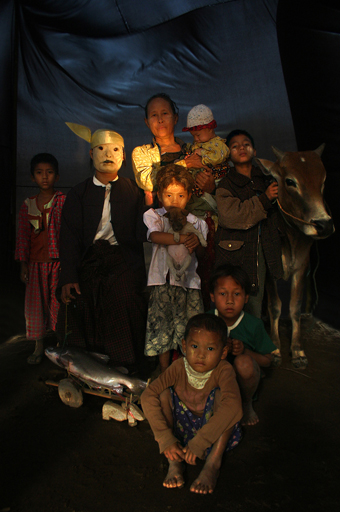
Nge Lay, The Relevancy of Restricted Things (2010), from the collection of the Singapore Art Museum and Fukuoka Asian Art Museum
IN JANUARY I WAS INVITED TO PARTICIPATE IN THE 8TH FLYING CIRCUS PROJECT (FCP) IN MYANMAR AND SINGAPORE. FCP IS AN INITIATIVE OF ONG KENG SEN, DIRECTOR OF THEATRE WORKS SINGAPORE AND FROM ITS BEGINNINGS IN 1996 THE INTERDISCIPLINARY LAB HAS EXPLORED CREATIVE EXPRESSION IN ASIA.
From 2007 FCP widened its brief to include artists from Europe, the Arab world and Africa. Its focal points are individual creative action, encountering difference and the strategies of art practice, emphasising the tenacity of local sites—with their artists, activists and public intellectuals. The lab is curated around the central notion of ‘world creating,’ how do we form micro-worlds, which are responsible, articulated and ethically engaged?
superintense & ulter u
In 2007, the FCP visited Ho Chi Minh City/Singapore and in 2010 explored Phnom Penh/Singapore. Each time a group of international artists, themselves working in sites of transition and cultural change, is invited to participate in a curated local program. The FCP artists contribute a one-hour presentation from their own ‘world’ in a back-to-back endurance fest titled Superintense, in 2013 staged in Yangon (Rangoon) and Singapore. Theatre Works also runs the Alter U program as a tandem project, an ‘alternative university’ with a commitment to artist-to-artist exchange and exposure to a diversity of artistic strategies which they describe as “a shared micro-space/time made by artists for world-citizens to contemplate action.” Ulter U is the part of the program where local artists engage with the FCP artists and includes commissioned local work, workshops, presentations and other activities to stimulate the development of individual artists in their own context.
on the path to democracy
In 2010 Keng Sen began exploring the possibility of staging FCP8 in Myanmar while the so-called transition to democracy rapidly accelerated during that period. The release of Daw Aung San Suu Kyi followed by her party, the National League for Democracy, gaining 43 seats in the Myanmar Parliament spearheaded the change. As Keng Sen says, “It is true that this is only a fraction of the total 664 seats but it is still a significant dent in the armoured tank that runs the land some have nicknamed ‘the forgotten country.’” Well it’s no longer forgotten, for never a week passes without some headline grabbing news: from President Obama’s historic visit to the Rohingar issue and ethnic conflicts in the western state of Rakhine, to the violent security raids on monks and mine-workers during a recent protest in Monywa.
fcp8
FCP8 took place in the shifting sands of a Myanmar in transition at a moment in time where artists and activists who had lived a life of fear simply for taking on the roles of educators, critical thinkers or documenters were facing an overwhelming level of change. This included the possibility of being able to speak directly to their audiences, exposure to international arts practices and, of course, the potential for all this to be swept away again in the erratic path of a violent and repressive regime.
artists as public intellectuals
The essential structure of FCP, of exchange across local and global contexts, laid itself out pretty quickly in Yangon where all activity took place at the Alliance Francaise. No strangers to censorship issues coming from Singapore, the Theatre Works team carefully set up the context where Burmese artists and activists were able to speak publicly on French soil.
In introducing the range of artists in the opening days in Yangon, Keng Sen proposed that the 8th FCP look at the role of public intellectuals in forming new societies. How do they communicate with a mass audience beyond the arts community and in a delicate dance with the authorities? We heard a range of approaches to change through arts practice from doctor and educationalist Ko Tah, cartoonist Au Pi Kyeh, novelist and environmentalist Ju to filmmaker Keiko Sei.
Burmese painter, photographer and video journalist Sithu Zeya, installation artist and photographer Nge Lay and performance artist Lyn Htet, director of Theatre of the Disturbed, have all worked from inside and outside the country and have each faced fear of censorship and imprisonment. 23-year-old Sithu Zeya was arrested for taking pictures of the aftermath of explosions in Yangon and sentenced to 18 years imprisonment. He was released on January 2012 after the relaxing of the censorship laws. Each of the artists has developed strategies to reflect government atrocities and stimulate art practice.
In 2013 FCP widened its scope to include activism and journalism. Keng Sen commented that the VJs (video journalists) are the cowboys of journalism, putting themselves in view of the secret police to make sure stories are told and smuggling footage out of the country, most often to Thailand. When Sun, one of the VJs featured in the award-winning documentary Burma VJ, addressed us at the French Embassy in Yangon it was the first time he had spoken publicly in his own country. One of Sun’s first statements to us was that Burma needs to release all political prisoners. Many of his colleagues have been tortured and are still locked away.
liberating film
Keiko Sei, a Japanese filmmaker working for 15 years in Burma, explained that the country has been quite random in its censorship; DVDs were sold quite freely over the past decade. What was lacking was not information but education and guidance on how to work with information that was forbidden. People were overloaded with mediatised junk and lacked perspective; as opposed to Eastern European dictatorships which have withheld media, the Burmese government took the opposite approach: “Korean soap operas, endless football and completely poisonous Hip Hop are what the government swamped the broadcast time with.” After being raided by the secret police and losing all the participants in her film discussion project Keiko Sei asked herself, “What would I risk 15 years’ imprisonment for, what art is worth that risk? It was a big responsibility for me.” After retreating to Thailand for some time, she returned, assisted by the Prague Film School who now take several students from Myanmar each year into their training program. Film played a significant part in FCP8 with the commissioning of English subtitles for short films by young Burmese filmmakers, the restoration of a lost print of the fabulous Wearing Velvet Slippers, Holding a Golden Umbrella (1971) by Maung Wanna (Godard meets Blanche Dubois in Yangon 1970!) and the presentation of the second ever Myanmar Film Festival in Mandalay.
theatre of the disturbed
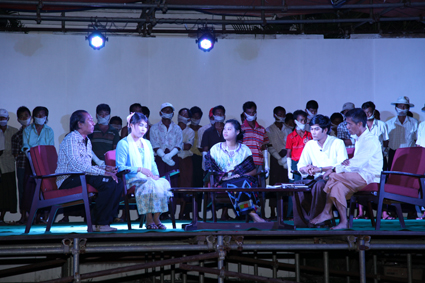
Hotel Reverie: Part 2 , Theatre of the Disturbed, Yangon during Flying Circus Project #8
courtesy the artists and Flying Circus Project
Hotel Reverie: Part 2 , Theatre of the Disturbed, Yangon during Flying Circus Project #8
One of the most tangible elements of FCP was the commissioning program by Theatre Works which included two productions of the Yangon-based performance art company, Theatre of the Disturbed. The first production was a restaging of Hotel Reverie Part 1, a production which director Lin Thet stated was an experiment in considering the relevance of producing Shakespeare’s Titus Andronicus in Myanmar. The performance was presented in the gardens of the French Institute, beginning with a libation ceremony by nine Buddhist monks, chanting in memory of those who disappeared during the 64 years of military rule.
Throughout the performance 64 male workers, gagged and with their hands bound, stood, leaned or sat (apparently depending on their levels of boredom or exhaustion) as a background to the action downstage. Following the libation ceremony a talk show was staged with three prominent activists, one of whom had endured lengthy imprisonment, discussing the moral, spiritual and political concerns of using violence as resistance to a regime. Each statement was translated at length for our benefit, resulting in a painfully drawn-out experience and growing concern for the 64 men wilting in the background. In the final moments a performance art nod to Titus Andronicus was played out involving a young woman with a pram full of raw meat and an overweight young man on stage inhaling ice cream.
Exhausted on the way home in the bus back through the Yangon traffic, the FCP artists discussed the work from our differing perspectives, with one of the new media artists from India prophesying Lin Htet will become famous as one of the pioneers of contemporary art in Myanmar. I felt I had had a comprehensive introduction to the complexities facing the fusion of art and activism in Myanmar, the troubled nature of importing art movements and most importantly the voice of Lin Htet, vocalising his experience of his country’s bloody history. The event was indeed disturbing and yet it offered a compelling picture of the struggles facing art making in this “forgotten country.”
something or nothing?
As the FCP artist presentations began in Yangon, Keng Sen noted that the connections (of his curation) would become visible over the coming days, that the different strategies we employ as artists in our work of ‘world creating’ in our different contexts would emerge. These would come to include “Land Art” as a link, the documentation of unsanctioned memories of atrocities and also the work of art making in conflict zones. With three Sri Lankan artists from Singhalese and Tamil backgrounds present, the issue of how to build paths to artistic practice in Sri Lanka was also a focus and perhaps an entree to the next FCP.
Keng Sen declared that one of the essential elements of FCP is “collaboration in location,” the histories and communities of location. Choosing not to use the word “community”—feeling it has been appropriated by funding bodies—he raised the issue of ‘for whom is the work made?,’ proposing “when we talk of making communities NGO’s want to make something useful. The ‘useful’ is defined very conservatively: we are meant to pass on useful skills to disadvantaged people. Some people say the Flying Circus is not useful. It produces nothing, but the concept of ‘nothing’ from an Asian spiritual perspective, is also something. What is the something?”
Sri Lankan filmmaker and photographer Anomaa Rajakaruna’s presentation outlined her documentation projects during and after a war, which has supposedly ended, though, as she stated, the struggle continues. She has made five video features, each of which have been banned in Sri Lanka, so the issue of who she was making her work for was critical. Keng Sen commented on the work of artists in conflict zones documenting for the future, a critical issue in Myanmar where memory, documentation and practices of remembrance have been controlled by a military regime, producing an ‘official memory’ for 64 years.
New media artists Sonal Jain and Mriganka Madhukaillya from Desire Machine Collective, based in Assam, suggested that coming from the North West of India “there is an expectation from people that you will create exotic images of conflict, a kind of ‘conflict tourism.’” They asked, “When you are living in a conflict zone everyday, what does it mean to make art?”
At the close of the period in Yangon and following the theatrical and confronting South African artist Brett Baily’s Third World Bun Fight, Keng Sen said, “We have been hearing of stories of violence and pain but also of humour and glamour. There are two threads of artistic response present, a kind of daily life investigation and a transgressive, subverted investigation.”
beyond mandalay: museum art project#5
After nine days in Yangon we moved north to Mandalay where we were advised to keep an even lower profile since a group of Malaysian street theatre performers had been deported on the spot a couple of months earlier after attempting to present a performance there.
Perhaps the highlight for me, and the day I felt the chemistry of both the FCP and Ulter U projects converging, was the day trip from Mandalay by boat across the Irrawaddy River to the sleepy riverside village of Mignon to view the Museum Art Project # 5, a pop-up style contemporary gallery curated by Tun Win Aung and Wah Nu and supported by FCP. Like many of the artists we had met they were concerned with bridging rural life and the art world, responding to the curiosity of the villagers with their projects. “In 2010, we started to realise small scale exhibition spaces in different villages and towns where there are no art galleries or museums built for the people. We thought exhibition designs should be connected and reflect on local people’s daily life, situations or landscapes. Space designs should be friendly and accessible for local people. So, we chose local small huts, tents and barns.”
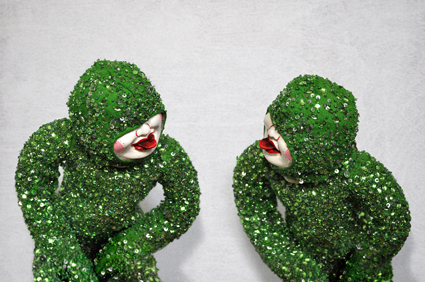
May Phue Thet, Be Happy Be Happy #02 (2012)
courtesy the artist
May Phue Thet, Be Happy Be Happy #02 (2012)
In Museum Art Project #5, Ming Thein’s Another Realm is a gigantic rifle made of hollow white cloth, suspended from the ceiling installed in one of the simple multi-use spaces perched on the banks of the river. May Phu Thet’s Be Happy Be Happy is a series of photos of Burmese baby puppets: garish white creatures with protruding, retractable red tongues, sporting lawn green sequined outfits. Curator Wah Nu addressed the FCP group and local guests saying, “This is an ordinary village but artists here have made it an extraordinary village. Now it’s like an art community where artists come to rent spaces and we can even say that the arts community here is stronger than in Mandalay. We have invited FCP here with the hope of exchanging with international artists. We hope it will be a good experience for the locals.”
What followed were two quite extraordinary presentations by FCP artists Sananthanan Thamotharampillai, a Tamil visual artist from Jaffana in northern Sri Lanka, and the wonderfully provocative Japanese performance maker and visual artist Tadasu Takamine, previously a member of Dumb Type. The range of their presentations—Sananthanan’s art book documenting Tamil displacement in hand drawn memories of the footprint of homes lost and Tadasu’s solo exhibition Cool in Japan, a series of rooms installed in Art Tower Mito as statements on Japan post-Fukushima—seemed to illuminate the goals of FCP as a site for exchange across worlds of experience.
For me FCP was a chance for reflection on our context in Australia, filtered through constant discussion with my good friend, South African artist Brett Baily, in our Southern Hemisphere gang of two! Long bus rides, pauses between presentations, random moments in temples gave space for exchange of the ideas behind the ideas between the participating artists, of what we do, how we do it and why, when and where we do it….And to meet new artists working in new contexts around the world, post Saffron revolution, post-Fukushima, post Arab Spring, in transition to democracy, or after war, under censorship or post apologies and reconciliation commissions, facing new challenges in cultural politics and representation.
Note: ‘Myanmar’ and ‘Burma’ are currently used interchangeably in that country. For more details on FCP8 see the blog by Singaporean theatre critic and writer Ng Yi-Sheng http://flyingcircusproject.weebly.com/index.html and the FCP website http://flyingcircusproject2013.wordpress.com/about/.
FCP8, Yangon and Mandalay, Myanmar, Jan 3-4; Singapore Jan 16-20, supported by the Ford Foundation, the Institut Français, the Lee Foundation and the National Arts Council (Singapore).
RealTime issue #114 April-May 2013 pg. 40-41
© Rachel Swain; for permission to reproduce apply to realtime@realtimearts.net
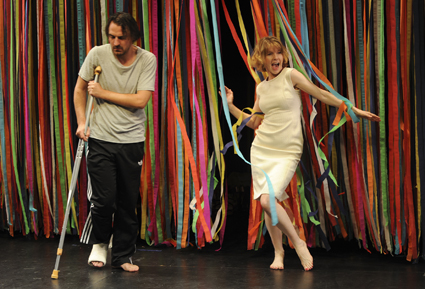
Ewen Leslie, Jacqueline McKenzie, Cat on a Hot Tin Roof
photo Heidrun Löhr
Ewen Leslie, Jacqueline McKenzie, Cat on a Hot Tin Roof
FOUR PRODUCTIONS, FOUR KINDS OF ENGAGEMENT—BELVOIR’S OVER-HEATED AUSTRALIAN ASSIMILATION OF CAT ON A HOT TIN ROOF, THE LIVING ROOM THEATRE’S OVERWROUGHT APPROPRIATION OF CONTEMPORARY PERFORMANCE, THE FIRST GARDEN’S TOO, TOO DIDACTIC RENDERING OF A LIFE, AND THE NATIONAL THEATRE OF BRITAIN’S CLEVER IMAGINING OF A COMMEDIA DELL’ARTE-INFUSED 60S BRITISH FARCE. SUCH ARE THE THINGS THAT THEATRE IS MADE OF.
belvoir, cat on a hot tin roof
There was pretty much unanimity among Sydney reviewers that Belvoir’s production of Tennessee Williams’ Cat on Hot Tin Roof (1955) was flawed, not least because of the directorial decision to render it in a tonally neutral Australian English. Bye bye Williams’ musicality, save for Big Mama, Lynette Curran’s marked oz accent delivering something of the much-missed poetry. In Jacqueline Mackenzie’s Maggie the loss of Williams’ lyricism meant that she was all “on a hot tin roof,” embodying a stunning hyperactivity born of emotional and sexual starvation, but not at all sensual, sinuous or feline. Elizabeth Taylor in the film (1958) conveyed something of the toxic combination of sultry languor and outburst that was missing here, for all of Mackenzie’s otherwise finely nuanced performance.
The production is framed by a large curtain comprising brightly coloured strips, suggestive of celebration, through which entrances and exits can be made on a revolve which allows for characters, a piano and various pieces of furniture to come and go, and for scenes to merge seamlessly. The frame for the performance thus becomes circular, at one stage lined by Maggie’s shoe collection, at another sustaining the momentum of Maggie’s fruitless pursuit of the limping Brick (Ewen Leslie)—the husband wounded by the death of his dearest friend and near silenced by the inability to express his homosexuality.
Maggie’s self-belief and sense of theatricality are amplified from the opening with an extended focus on her dressing, making up and applying toe-nail polish all the while verbally pummelling the still Brick and at one point scissor locking him with her legs. Brick breaks Maggie’s flow with silence or a blunt counter-rhythm. The fraught relationship between Brick and his father, Big Daddy extends this counterpoint—at its best on the occasions when Marshall Napier (a late replacement for an ill Anthony Phelan), was free of the script, the pair realising a verbal dance of evasion and potential connection fuelled by Big Daddy’s needy desire (after a cancer scare) to communicate and Brick’s belief that it had never happened and never will. The dialogue is frequently about talk—the meaning and weight of words, ‘pity,’ ‘homo,’ ‘truth,’ ‘queer’ and especially ‘disgust’; about questions, the barrage aimed at the unresponsive Brick by Maggie and Big Daddy; and when talk fails—a crutch kicked away, furniture smashed, the curtain torn down (melodramatically underlined with screaming guitar).
The structure of Cat on a Hot Tin Roof poses a particular challenge of balance. Maggie is the driving force of the first third of the play with Brick a reticent, sulky presence. The conflict between Big Daddy and Brick, again a battle against refusal, is the play’s centre. This is followed by Maggie’s manipulative assertion of her husband’s rights—and then her own as she prepares, in this production, to fellate Brick. That the drama plays out more between a dying father and his son than between husband and wife (Maggie is a lesser psychological and stage presence in the latter half of the play) makes the ending feel unlikely and the relationship forever unresolved. Perhaps that’s as it should be. But we’re left in no doubt about Maggie’s strength and determination, if uncertain of Brick’s passive resolve. Despite critical reserve, the profound loss of the music of Williams’ Southern English and an absence of interpretive clarity (unusual for director Simon Stone), Belvoir’s volatile Cat on a Hot Tin Roof has apparently proved to be a popular success—a family saga with themes still quite contemporary and big issues—existential disgust, social prejudice and a sense of renewal with “a life in the place of death”—all writ large.
i love todd sampson
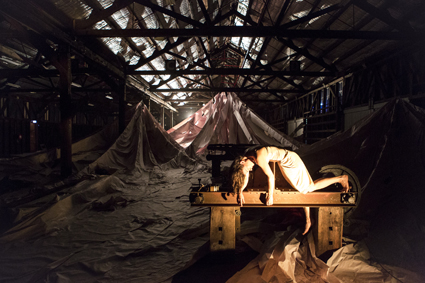
Gabrielle Quin, I Love Todd Sampson, The Living Room Theatre
photo Brett Boardman
Gabrielle Quin, I Love Todd Sampson, The Living Room Theatre
Pier 2/3, Walsh Bay is the expansive site for the Living Room Theatre’s I Love Todd Sampson—Voices of the Vulnerable, a large-scale multimedia installation through which the audience follow Laura (Gabrielle Quinn), a woman suffering a nervous breakdown, the result of abuse and the likely false belief that she is responsible for the death of a cellist. On a journey into deepening madness, Laura encounters her mother, people from her past, a would-be lover whom she consistently rejects and symbolic figures (a woman abseiling across the wharf’s timber walls while towing a resistant figure) in a variety of installations designed by members of local architectural firms. These vary from domestic (rooms within rooms) to surreal (a mountainous winterscape made of paper) and domestic-surreal (a stylish, seemingly off-balance kitchen, the setting for an unstable domestic scenario). Adding to the sense of unease created by changes of location and character mutations, is the voiceover provided by the actual Todd Sampson (CEO of Leo Burnett Australia, co-creator of the Earth Hour initiative and commentator on The Gruen Transfer and The Project). Laura aurally hallucinates him as her saviour, but when she fails to make him incarnate, and sexual, in a spooky (carefully designed) wreck of a building, she emotionally unravels. Finally, after being subjected to increasingly nightmarish scenarios (including a near hallucinatory vision—for the audience—of a rain shower sparkling into suspended motion), she collapses onto rusted machinery in an arctic waste and dies.
While to all appearances a contemporary performance work I Love Todd Sampson was burdened by heavy-handed acting, taxing longeurs and highly variable design quality, as well as by sundry performance clichés. The scale of Wharf 2/3 meant that text, either doggedly literal or numbingly opaque, wasn’t always audible. I Love Todd Sampson is a work of excess but not excess that yields wisdom. It has some structural and psychological kinship with Botho Strauss’ similarly discursive Gross und Klein, but Strauss’ vision is more consistently lateral and quite un-melodramatic; Lotte might be regarded as mad by those she encounters, but they themselves prove to be more dangerous. If I Love Todd Sampson is clearly the work of ambitious young artists defeated by the scale of their vision, they nonetheless warrant praise for realising it on such scale and for the rigour, if not subtlety, with which Gabrielle Quinn lives out Laura’s fatal madness.
one man, two guv’nors
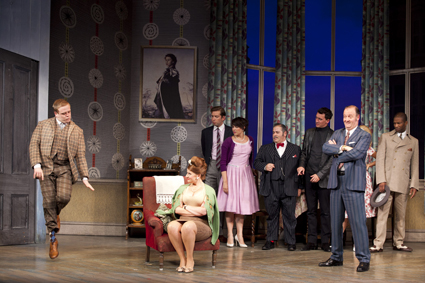
One Man, Two Guv’nors, National Theatre of Great Britain
photo Lisa Tomasetti
One Man, Two Guv’nors, National Theatre of Great Britain
Other than to entertain, there appears to be no visible or palpable sense of higher purpose to Richard Bean’s One Man, Two Guv’nors, the international stage success rooted in the commedia dell’arte tradition (it’s based on Carlo Goldoni’s The Servant of Two Masters, 1746), transposed to early 1960s London and textured with postmodern flourishes that a 2013 audience knowingly applaud. Politically the play is light-on, most of its references to feminism and homosexuality are of the arch insult or the ‘nudge nudge, wink wink,’ variety, funny because they now appear so quaint, recalling a more repressed era, that of the risqué joke. At times, when murder is on the agenda or sadomasochism is hinted at, it’s as if One Man, Two Guv’nors will turn out to be a farce desultorily knocked out by the late Joe Orton, the comic genius of the 1960s British theatre, for a bit of spare cash. The show is laced with the broad humour of Benny Hill, the Carry On films, cross-dressing and a few touches the overtly satirical new wave of British comedy in the 60s.
If there is a higher purpose to One Man, Two Guvnors, it is manifest in the production’s celebration of commedia dell’arte, British comedy and above all theatrical virtuosity—expert timing, risk-taking physical dexterity (physical comedy director, Cal McCrystal), broad characterisations with memorably subtle touches, convincing singing, dancing and vaudevillian turns and the capacity to adopt the audience as confidante and transform them into the conned. Owain Arthur—the one man-two servants—embodies all these skills, realising Frances as not too bright but endowed with highly adaptive tunnel vision and the physical capacity to act on it, lurking, running, vaulting, crashing and spasming all too convincingly. The best reason for seeing One Man, Two Guvnors, even if the calculatedly thrusting direct address of the actors and the musical interludes can be wearying and the status quo holds, as ever, is to witness theatre history virtuosically recreated and reimagined.
the first garden
Olive Pink, like Daisy Bates, is one of those significant and eccentric female figures from Australian history who are resurrected to public attention from time to time (Tracks Dance produced Fierce, about Pink, in Darwin in 2001, RT45, p9) both for their relationship with and support of Aboriginal people, if much more contentiously so in the case of Bates.
Pink (1884-1975) was a botanical illustrator, anthropologist, environmentalist, an activist for the Warlpiri and Aranda people of Central Australia and the creator of an ecologically sound Australian garden in Alice Springs. The play by Christopher Raja and Natasha Raja (who plays Pink) is plainly and quite didactically constructed. The aged Pink at work on her garden is haunted by the over-protective Harold Southern she lost to World War I and who attempts to restrain her activism. Into this scenario come other figures including the amiable Warlpiri man who assists her, Johnny Tjampatjimpa, played by Eshua Bolton, who also doubles as a hostile and destructive Tasman, on the run from the law and testing the limits of Pink’s compassion. Although Bolton imparts a degree of subtlety to his performance, Raja as Pink is one-dimensional, restrained by a heavily made-up, mask-like demeanour and a rigid physical interpretation of ageing. Like Scott Fraser, who plays Southern, her vocal delivery is one-note, presumably to meet the exigencies of outdoor performance. Slowly paced and too inclined to exposition and broad characterisation, The First Garden is to be admired for its commitment to revealing the complexities of Olive Pink’s life and the richness of her vision and is pleasantly staged in Sydney’s Botanic Gardens with music live from Christopher Brocklebank, Hugh Brocklebank and Bill Peechy.
Belvoir, Cat on a Hot Tin Roof, writer Tennessee Williams, director Simon Stone, performers Ewen Leslie, Jacqueline McKenzie, Marshall Napier, Lynette Curran, design Robert Cousins, costumes Alice Babidge, lighting Damien Cooper, composer, sound designer Stefan Gregory, Belvoir from Feb 20; The Living Room Theatre, animateur Michelle St Anne, performers Imogen Cranna, Alan Flower, Lanneke Jones, Michelle St Anne, Ling-Hsueh Tang, Gabrielle Quinn, Carol Divjak, architectural producer Andy Macdonald, creative advisor Chrissie Koltai, installation artist Michaela Gleave, media artist Imogen Cranna, production designer Joel West, composer, sound designer Lawrence English, composer, pianist Alister Spence, cellist Mary Rapp, Wharf 2/3, Feb 28-March 10; National Theatre of Great Britain, One Man, Two Guv’nors, writer Richard Bean, director Nicholas Hytner, physical comedy director Cal McCrystal, choreographer Adam Penford, lighting Mark Henderson, music Grant Olding, design Mark Thompson, Sydney Theatre, from April 2; The First Garden, writers Christopher Raja, Natasha Raja, director Steve Kidd, performers [see review], co-producers Benjamin Convery and the Olive Pink Botanic Garden, Alice Springs; Royal Botanical Gardens, Sydney, March 8-17
RealTime issue #114 April-May 2013 pg. 42
© Keith Gallasch; for permission to reproduce apply to realtime@realtimearts.net
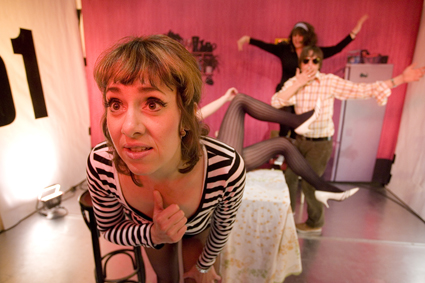
Gob Squad, Kitchen (You’ve never had it so good), courtesy the artists
LET ME SHARE WITH YOU TWO IMAGES THAT SUM UP THE ELECTRIC CARNIVAL THAT WAS THIS YEAR’S SUBLIMELY PROGRAMMED WORLD THEATRE FESTIVAL.
The first involved me trying to explain to a bemused and bespectacled WTF patron what the dazed man covered in peanut butter was doing as he lurched from renowned American academic and director Richard Schechner’s workshop to a nearby toilet.
The second involved the same patron simulating oral sex onstage with German sex kitten Laura Tonke in Gob Squad’s Kitchen (You’ve never had it so good) and looking like she was having the night of her life.
The premise of Kitchen is deceptively simple. The audience is greeted by the three members of the Gob Squad collective who are on tour. We are asked to walk behind the large screen installed onstage and inspect three sets: a bed, a kitchen and a scrim. Once settled in our seats, the show begins and we discover that each set is based on a seminal Warhol pop film: Sleep (1963), Kitchen (1965) and Screen Tests (1964-66). Live footage is streamed onto the giant screen as the performers attempt to recreate each film: squabbling, flirting, remonstrating and philosophising with each other. “Everything began here,” Gob Squad’s Bastian Trost whispers seductively to the audience while appearing in saturated black and white close-up. Across the duration of the show, the initial premise is skillfully deconstructed. Three audience members are co-opted into playing the performers’ roles, deftly instructed by them via head-piece to enact the show’s climax: a post-Warhol, hyper-reality where the “real audience member” celebrity has superceded the performers’ increasingly petulant antics.
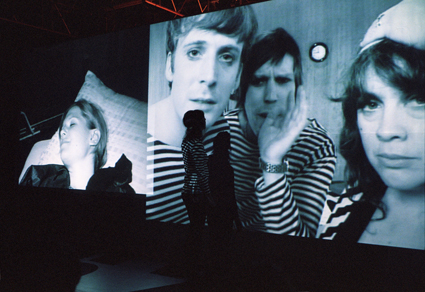
Gob Squad, Kitchen (You’ve never had it so good)
courtesy the artists
Gob Squad, Kitchen (You’ve never had it so good)
Gob Squad was as assured and expert as its reputation promised. The show was flawlessly executed, the technology so integrated into the performance it seemed to melt away: I have never been less conscious of a screen onstage. Each performer was dextrous in coaxing wincingly vulnerable admissions from the audience without it seeming inappropriate. The melding of pop sensibility, witty one-liners and the homage to Warhol was a spoonful of sugar that made the critique of our celebrity-drenched, mediated culture go down unnoticed. The company’s unique creative methodology, collective institutional structure and resulting polish and professionalism make for a seamlessly entertaining theatrical experience.
The helpful WTF program suggested that Kitchen patrons would also enjoy Reckless Sleepers’ The Last Supper. Indeed, both companies are trans-European and were founded in that post-dramatic eruption of energy in the late 1980s and early 1990s, energy that Reckless Sleepers’ founder Mole Wetherell describes as “a reaction to proper theatre in big places” (www.reckless-sleepers.co.uk).
Unlike the cheerful, polyglot, technology-driven Gob Squad, Reckless Sleepers’ work has more of a literary and mannered atmosphere with a deliberately anti-theatrical agenda, more akin to the live art manifesto of British company Forced Entertainment. The Last Supper is one of their older works, commissioned in 2004 and recently revived. As in Kitchen, the audience is greeted by a performer, Mole Wetherell in formal attire but with noticeably dusty bare feet. We are courteously given a number and the other two performers, Leen Dewilde and Tim Ingram, lead us to long narrow tables in a square configuration, marked with seemingly random numbers.
The performers fill our glasses with wine and then adjourn to their table, pre-set with red wine, scripts, apples and short stacks of square paper the size of palm cards. They begin a series of toasts. The tone is muted, ironic, with a slowly building undertone of hysteria and menace. At intervals, marked by the performers with a sense of weary collusion, they read quotations from their stack, pause, wrap the paper into delicate bundles, tip their heads back slowly and ‘eat the words’ of the famous dead they have just quoted. Between toasts and consumption, unobtrusive waiters appear with plates of food assigned to the numbers at respective tables: the final death row meals of various Texan prisoners in the 1990s. The florid and eccentric meal requests—liver and burger, pickle and pie—make this ghoulish experience the most alive part of the proceedings, in contrast with the detached manner of the performers as they read from their scripts.
I had been really looking forward to this show since, like Gob Squad, Reckless Sleepers’ reputation precedes them. However, The Last Supper felt like a revived work that had somehow lost its initial zeitgeist. The deliberately hackneyed choices of the kitsch Texan death row meals and the great clichés of deathbed (yes, we did Elvis and Marilyn, Che Guevara and Trotsky, Rasputin and Da Vinci) felt lazy rather than biting. There seemed very little at risk for a form whose traditions thrive on experimentation and that sense of audience discomfort at a game being played where the rules are not necessarily understood. I kept waiting for the turn, or the retreat, or even the unravelling of the carefully formal mise en scène. While l really enjoyed the creamy intensity of Leen Dewilde’s performance, the tang of the red wine and the evident intellect and craft of Wetherell’s script, I was shocked when the show stopped, almost petering out. I felt deflated. Perhaps this was an intentional anti-ritual demonstrating that last meals are as mundane as any, whatever faded glamour or religious intensity we might try to attach to them?
It was a privilege, nonetheless, to see iconic Gob Squad and Reckless Sleepers’ repertoire co-terminously and in the broader context of the savvy international programming of this year’s fabulous World Theatre Festival.
See Osunwunmi’s account of Reckless Sleepers’ String Section as part of In Between Time, Bristol.
World Theatre Festival 2013, Gob Squad, Kitchen (You’ve never had it so good), devisors, performers Johanna Freiburg, Sean Patten, Sharon Smith, Berit Stumpf, Nina Tecklenburg, Sarah Thom, Laura Tonke, Bastian Trost, Simon Will, video Miles Chalcraft, Martin Cooper, sound Jeff McGrory, Jeffrey Fisher, dramaturgy: Christina Runge; Reckless Sleepers, The Last Supper, writer, designer Mole Wetherell, devisors, performers Tim Ingram, Leen Dewilde, Mole Wetherell; Brisbane Powerhouse, both shows, February 20-24
RealTime issue #114 April-May 2013 pg. 44
© Kathryn Kelly; for permission to reproduce apply to realtime@realtimearts.net
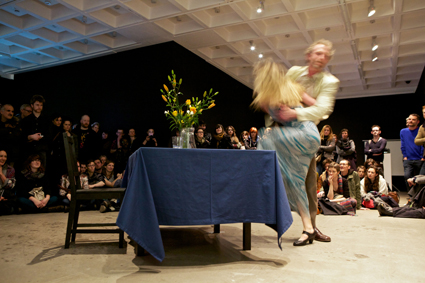
Images: top – Tim Etchells, Untitled (after Violent Incident), IBT13
photo Oliver Rudkin
Images: top – Tim Etchells, Untitled (after Violent Incident), IBT13
THERE’S A GENERAL THEME OF HOSPITALITY RUNNING THROUGH THIS YEAR’S IN BETWEEN TIME, WHERE EVERY OTHER PERFORMANCE COMES WITH A FREE ALCOHOLIC DRINK AND YOU’RE AS LIKELY TO BE USHERED INTO A PLUSH TOWNHOUSE, OR A CAMPFIRE-LIKE CIRCLE IN THE TWILIT FOREST, AS A BLACK BOX STUDIO. IT’S RARELY A PASSIVE EXPERIENCE FOR THE AUDIENCE.
alex bradley, field test
Alex Bradley’s solar-powered churchyard installation Field Test invites you to gaze up at tree branches filled with constellations of LED lights, as sweet music drifts from bird-box speakers all around you. Even here, in an overlooked backstreet of central Bristol, a busker has stumbled upon Bradley’s ambient meditation and is adding long, surprisingly sensitive violin motifs to the rich textures and city noise. People come and go in the dark. Drug dealers try, unsuccessfully, to tout their wares. The electronics are enough.
tim etchells, untitled (after violent incident)
In Between Time’s air of hospitality is gratefully received by an enthusiastic and vocal audience. Bristol has been missing the large-scale curation of a certain kind of performance (most often non-mimetic, non-narrative, physically uncompromising and oblique in immediate intent) since the last IBT in 2010. On the opening night, Arnolfini is packed so tight you can barely move, and I plant myself in front of Tim Etchells’ Untitled (after Violent Incident), a live version of his Bruce Nauman-inspired video work, to catch the whole thing from start to finish. Two performers re-enact a compression of the actions and atmospheres from Nauman’s 1986 multi-screen installation, a repetitive set of altercations, slaps, pratfalls and grievous bodily harms around a dinner table, stuck in a loop—but a human loop, imperfect, with the male and female performers sometimes recognising the absurdity of their actions in tiny and knowing ways. Over time it becomes alternately horrifying, hilarious and exhausting, a ritual derived from data retrieved from a faulty drive. It’s as interesting to watch your fellow audience as it is the choreography: to see where they laugh, where they frown, markedly different expressions upon every face in the crowd at any given point.
holzinger & riebeek, kein applaus für scheisse
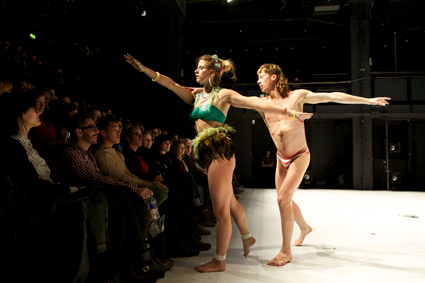
Kein Applaus fur Scheisse, Holzinger & Riebeek, IBT13
photo Oliver Rudkin
Kein Applaus fur Scheisse, Holzinger & Riebeek, IBT13
I find myself thinking back to Untitled later in the weekend, when Florentina Holzinger and Victor Riebeek stage Kein Applaus Für Scheisse, also an account of negotiations between a man and woman, but this time it’s a goofy, sweet portrait of the artists’ real-life relationship—albeit thoroughly excretal. Dressed like acid-house hippies and singing bad karaoke, Holzinger and Riebeek present a series of tableaux with their bodies and bodily functions at the centre. He eats a trail of red string from her vagina; they dance in formal but bungled style, limbs knocking against each other; he urinates on her and she spits it out into his open mouth. In this instance you don’t need to see the audience’s faces. You can hear them. At the point where Riebeek genuinely and repeatedly vomits a startling pure blue liquid onto Holzinger’s arching body, there are gasps, jeers, laughter, and someone behind me involuntarily exclaims: “Easy, tiger!” But beyond the human fluids, the pictures are slowly becoming more formal, more obviously constructed, more touching even. It’s awkward but honest. Holzinger looks up at us, covered in her lover’s blue bile, and mutters: “I need to take antibiotics, I have the allergies.” It’s another ritual from an obscure corner of the world, but this time you get the sense that these two dancing geeks will keep on changing it, making it relevant to each destination and each other as they see fit, and shrugging off anyone who thinks it perverse.
the vacuum cleaner, mental
The vacuum cleaner (“an artist collective of one”) in his solo show, Mental, invites us into a very different kind of autobiography. It’s billed as a work-in-progress but already constitutes one of the most powerful portraits of creativity and depression I’ve ever seen. Twelve of us are bussed to a sparsely furnished bedroom in a hilly part of the city and fed tea and cake until the artist emerges, rheumy-eyed, from underneath a duvet. With grim countenance he pulls folders bulging with documents from under the covers and pillows: his psychiatric reports, his police records. One by one he slides acetates onto an OHP, reads out extracts, then flicks them away, as the story of his fight with the black dog plays out through medical assessments and the unintentionally hilarious prose employed by officers of the law. It’s a heart-rending journey—because the vacuum cleaner has set himself up for a fall: his work, anchored in activism and social justice, is about desperately hoping for the best from the world. And on those terms the world often tends to kick you in the teeth.
Mental is presented in a familiar way, in the tradition perhaps of Bowery-loft performance art, the artist’s life writ large. But there are some remarkable little victories, observations and stings in the tale that make it as important to the listener as the speaker. At the end, when it’s done, I sit and eat a piece of carrot cake that—for reasons I can’t even begin to divulge—has become the saddest and most beautiful taste I can possibly imagine.
emma bennett, slideshow birdshow
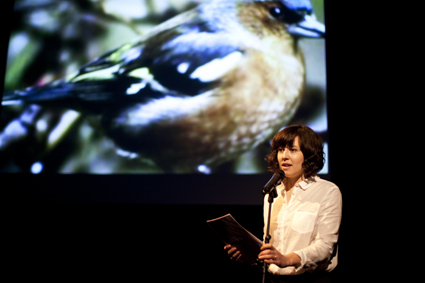
Emma Bennett, Slideshow Birdshow, IBT13
photo Delia Spatareanu
Emma Bennett, Slideshow Birdshow, IBT13
At the other end of the emotional scale the biggest laughs at IBT13 come thanks to Emma Bennett’s uncooperative powerpoint lecture, Slideshow Birdshow. Quiet and formal, Bennett begins to deliver a dull talk about ornithology but rapidly gets derailed by a chain of fuzzy, unhelpful and repetitive images that lead her into a cut-up verbal dance. She’s confused but seems compelled to keep talking, continually repeating useless, self-evident details back and forth in time with the slides; and what emerges is a piece of music, like spliced tape running off the spool, out of control, peppered with occasional exclamations or expletives. Towards the end of this short performance the laughter subsides, the rhythms generate an odd calm—and with massively pixelated images flashing by, Bennett’s trembling voice in perfect and unlikely synch with them, her wordless tones turn into a quivering digital birdsong all of their own, singing from somewhere deep inside the machine.
In Between Time: Alex Bradley, Field Test; Tim Etchells, Untitled (after Violent Incident); Holzinger and Riebeek, Kein Applaus Für Scheisse; the vacuum cleaner, Mental; Emma Bennett, Slideshow Birdshow; Bristol, UK, Feb 14-17
RealTime issue #114 April-May 2013 pg. 22
© Timothy X Atack; for permission to reproduce apply to realtime@realtimearts.net
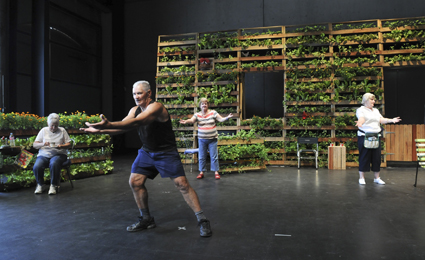
(l-r) June Hickey, Ivan Sevrovic, Dorothy Weir, Judy Murray; Life As We Know It, Urban Theatre Projects
photo Heidrun Löhr
(l-r) June Hickey, Ivan Sevrovic, Dorothy Weir, Judy Murray; Life As We Know It, Urban Theatre Projects
I HAVE NEVER SEEN A THEATRE WORK FEATURING SEVEN ELDERLY NON-ACTORS. IN SOME WAYS, TO DESCRIBE LIFE AS WE KNOW IT LIKE THIS DOES IT AN INJUSTICE, SINCE IT OCCURS WHERE THEATRE, PERFORMANCE AND PARTICIPATORY ART CROSS PATHS.
Urban Theatre Projects’ new artistic director Rosie Dennis’ production is the culmination of 18 months of organic workshopping and story swapping with mature-aged residents of the south west Sydney suburb of Minto about their life experiences. In that sense, Life As We Know It is neither improvisational theatre nor a traditional play. It’s something else: a collective autobiography and an instance of the diversity of practices that now encompass theatre and performance.
The first thing the audience sees is a lush, green, vertical garden fashioned from timber paletts. The impact of this transformation of the black box theatre space is akin to sitting in your own grandparents’ backyard. Subtle links to the ‘outer world’ are everywhere—a breeze through the open windows rustles the flowers and lettuce leaves in one corner, and a roaring jet outside seems less like an intrusion than another part of the production. It’s a joyful, inclusive, living set that unifies what could otherwise be a disparate collection of stories and characters. Immediately, we are put at ease, a feeling that grows as performers—people, rather—with names like June, Judy, Daryl and Dot leave their seats in the audience and enter the stage, one by one. One is a European migrant, married for close to half a century; one put her own ambitions on hold to raise a family; another was raised on a mission for Indigenous people in Kellyville. Unmannered in movements and speech, all of them appear distinctly nonplussed about their onstage roles.
A series of conversations, monologues and musical numbers interweave seamlessly, unrolling with ease and humour potentially depressing themes of aging, mortality, compromise in marriage and loneliness. The production balances stylisation and naturalism to produce a kind of mediated realism that is moving but not schmaltzy, life-affirming but not preachy, and honest but not too earnest. There are no big false life lessons learned, no dramatic character arcs. There is barely a fourth wall, just very frank, funny and direct theatrical communication. It’s the kind of theatre that appeals to people who think they loathe theatre.
Surely this is what contemporary theatre is demanding of practitioners—to produce work that embraces audiences and values their generative contribution to the art-making process. To throw light on barely heard communities and to contribute to them. To go beyond merely theoretical exercise in participatory principles.
This is not theatre as a fringe activity. Rosie Dennis’ work matters—to the communities she is enabling on stage and to the audiences she is connecting with.
Urban Theatre Projects, Life As We Know It, director Rosie Dennis, with Judy Murray, June Hickey, Jenny Shillingsworth, Daryl Cooke, Ivan Sevrovic, Dorothy Weir, Vicky Andrews, musicians Matthew Steffen, Toby Martin, lighting Frank Mainoo, design Joey Ruigrok Van Der Werven; a Campbelltown Arts Centre Commission, produced by Urban Theatre Projects; Carriageworks, March 13-16
RealTime issue #114 April-May 2013 pg. 46
© Lauren Carroll Harris; for permission to reproduce apply to realtime@realtimearts.net
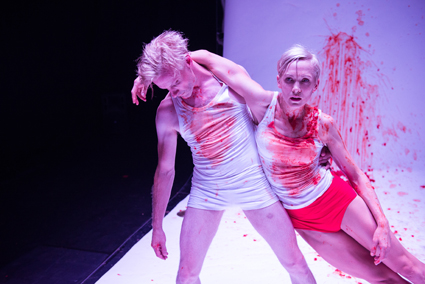
Gerard Van Dyck, Kate Denborough, Flesh and Bone, KAGE
photo Lachlan Woods
Gerard Van Dyck, Kate Denborough, Flesh and Bone, KAGE
AS KAGE, KATE DENBOROUGH AND GERARD VAN DYCK HAVE BEEN WORKING IN CLOSE COLLABORATION FOR MORE THAN 15 YEARS, BUT IN FLESH AND BONE, THE TWO SHARE THE STAGE FOR THE FIRST TIME IN A GREAT WHILE. IT’S A WONDER, NOT SIMPLY BECAUSE IT’S A POTENT REMINDER OF DENBOROUGH’S EXCELLENCE AS A DANCER (SHE USUALLY DIRECTS WHILE VAN DYCK PERFORMS).
flesh and bone
More than that, Flesh and Bone is one of those rare and deeply gratifying examples of work that could only be accomplished by artists who have spent so long developing ideas together. It’s an intimate and highly personal work, brave and revealing, and casts a particular spell that would have broken if another performer had entered the space.
It begins in near darkness, dim illumination gradually allowing our eyes to adjust and make out the pair in odd proportions—her shoulders broad and masculine, his silhouette showing off feminine hips and breasts. They’re both in a kind of drag that extends to the flesh, and after they strip themselves of their clothes they continue this process of unveiling by calmly discarding the skin they wear beneath. Still, even when they’re back to themselves, their individuality seems never to fully recover itself, this sense of overlapping identity maintaining itself throughout the hour that follows.
In making the work, Denborough and Van Dyck sought out the thoughts of a group of young people (facilitated by writer Clementine Ford). Their discussions on gender informed what was to become Flesh and Bone; there are sequences in which the traditional roles of male and female dancers are reversed, as Van Dyck is supported by Denborough’s lifts, while that most gendered of performances, the tango, is given a more permeable and supple twist. At one point he removes a pair of fake breasts from his shirt, she a prosthetic penis from her trousers. Despite the powerful exploration of gender that runs throughout the work, it would be an error to say that the piece is ‘about’ gender. It’s simply one of the conditions that the work is testing. There’s no lesson in any of this, no obvious point to be made. Each moment has an elusive but compulsive necessity that requires no explanation. There’s no logic or narrative, but everything is as it must be.
It’s also a thoroughly visual work, with each vignette offering striking images. On a curved, mirrored surface the pair create subtle illusions with a number of immense, black balloons; a massive expanse of grass forms the foundation for a quiet, introspective moment; a vast sheet of unbroken white paper is canvas for a violent moment of rupture. The most memorable scene is also the most inexplicable—Van Dyck places a small mirrored table over Denborough’s prone form and proceeds to make pasta from scratch, topping it with sauce and shaved cheese. This unfolds with methodical slowness, yet it’s impossible to look away.
As is typical of the company, the work displays its roots in dance but draws just as heavily on other disciplines, from circus and magic to post-dramatic theatre. It refuses to stay one thing, but just as importantly is always something—it’s never an act of negation or refutation but rather of continual expansion. It’s buoyant, occasionally startling and always generous towards its audience. Hopefully it’s a sign of what’s to come, too.
until then, then
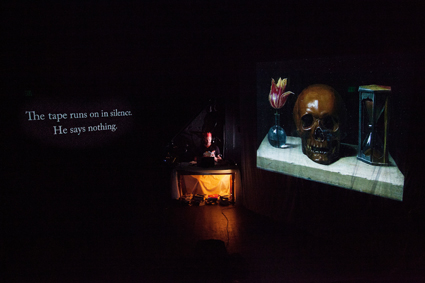
Until Then, Then, The Public Studio
photo Pier Carthew
Until Then, Then, The Public Studio
A stark contrast comes in the form of Until Then, Then, another piece by two long-time collaborators, Ming-Zhu Hii and Nicholas Coghlan, under the rubric of The Public Studio. Both retreated from creating new work several years ago after reaching a point of dissatisfaction with the art scene in Melbourne, and that process of negation also underscores every aspect of Until Then, Then. It’s not merely anti-theatre, which has its own conventions by now. It’s closer to an installation, in some ways, one which actively invokes theatrical traditions in order to do away with them.
Coghlan sits at a small desk, wearing a paper crown, and mutely operates a laptop to bring up a series of projected images and text. The visuals are manipulated paintings that evoke the Baroque vanitas or memento mori, the reminder that death accompanies all worldly existence. Here those skulls and hourglasses are subjected to their own digital decay and retrieval, piling up in infinite regression or finding themselves magnified to the point of unintelligibility. Some of the visuals are Bacon-esque in their ghastly fleshiness, but they never quite reach a point of morbidity.
Meanwhile, snatches of dialogue from the ‘great’ male characters of (mostly) modernist theatre—Woyzeck, Krapp, Peer Gynt—are displayed. They provide no context, and very quickly begin to suffer their own ravaging, as words disappear from sentences before they can be parsed, leaving brittle skeletons of phrases with the meat ripped off. Coghlan seems to be enacting this violence from within his tiny alcove, but his lack of expression never clues us in as to the nature of his relationship with the strangeness taking place around him.
The overall effect is a radical act of silence, in a way. It’s almost the theatrical equivalent of a hunger strike—it refuses, and refuses and refuses, and it’s perhaps no surprise that many audience members have been thoroughly confused and at times bemused by the work. It’s common that emerging theatre makers will think they’ve reinvented the form, but here we have more mature artists who seem to have come to the realisation that such a thing is impossible. The work offers no answers, and I don’t know that it admits of its own questions, either. It doesn’t exactly celebrate failure, since it doesn’t allow for the existence of success. But what the alternatives might look like remains teasingly out of the frame here.
KAGE, Flesh and Bone, creators, performers Kate Denborough, Gerard Van Dyck, costumes Lisa Gorman, lighting Paul Jackson, composer Kelly Ryall, Fortyfivedownstairs, March 7-24; The Public Studio, Until Then, Then, co-creator, performer Nicholas Coghlan, co-creator, director Ming-Zhu Hii, sound Russell Goldsmith, lighting Damien McLean, design Matthew Angel, Ming-Zhu Hii; La Mama Theatre, Melbourne, March 6-10
RealTime issue #114 April-May 2013 pg. 47
© John Bailey; for permission to reproduce apply to realtime@realtimearts.net
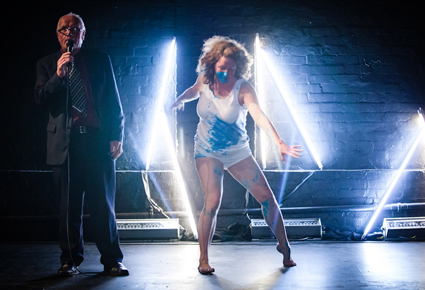
Bron and Jim Batten, Sweet Child of Mine
photo Max Milne Photography
Bron and Jim Batten, Sweet Child of Mine
WITH TENTS ERECTED, POP-UP BARS BUILT AND CITY GARDENS TRANSFORMED INTO NIGHTSPOTS, FRINGE WORLD IS A WELCOME SUMMER CARNIVAL.
With fresh and affordable shows, it neatly dovetails with the mainstream Perth International Arts Festival. As one of the youngest but rapidly growing festivals on the international fringe calendar, this year’s program attracted diverse and savvy works from Perth artists, the national fringe circuit and international acts. Here’s a small sample from a very large program.
sweet child of mine
Bron Batten’s parents don’t exactly know what their daughter does for a living, so she made a show with them to explore her art-making process. In a hybrid performance of dance, stand-up and film, Batten explores her life as an artist with self-reflexive satire while her Dad provides fatherly advice to the audience and admits his daughter’s work is still something of a mystery to him.
While Melbourne-based Batten’s stand-up observations tend to be insubstantial, she does have a knack for ironic setup; her lightning-fast overview of ‘deconstructionist’ theatre—blithely referencing Foucault, Derrida and Jamieson—is juxtaposed with filmed segments of her parents’ droll perspective as they try to categorise something as abstruse as contemporary art. Batten has a wicked sense of the ridiculous, which is highlighted in a sketch where she dresses as a beaver and recruits an audience member to play the artist’s role in a scripted exchange with her mother. This adds distinctive insight into that relationship without sentimentality. While occasionally trite, Batten’s self-deprecating wit and her parents’ roles as unwitting comics provide a refreshing and playful approach to the perplexing nature of art.
the wives of hemingway
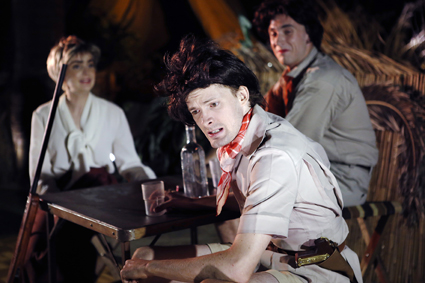
Tim Watts, Adriane Daff & Josh Price, The Wives of Hemingway
photo Skye Sobejko
Tim Watts, Adriane Daff & Josh Price, The Wives of Hemingway
Ernest Hemingway’s oeuvre brimmed with stoic male characters on magnificent, grisly adventures. If his literary output is anything to go by, he was obsessed with death, violence and love. Drawing inspiration from his texts and love life, The Wives of Hemingway is a satirical reimagining of the writer’s tumultuous marriages. Newlyweds Catherine and Wilson go on safari, a surreal journey complete with big game hunting, rampant heroics and sordid sexual exploits. The advent of Helen joining their call to adventure turns the hunt into a brutal battle for love.
Perth writer-director Zoe Pepper and her team of co-devisors capture imperial idioms of the romantic adventure genre exquisitely. Performers Tim Watts, Josh Price and Adriane Daff sit on the razor edge of parody before tumbling into the dark Hemingway psyche: where fear of emasculation and the feminised male materialise in the guise of female grotesques. Homely Helen and sexually audacious Catherine are played interchangeably by Price and Daff. Price taps into the fragility of both women with extraordinary black humour, while Daff exhibits a restrained delirium throughout. The quintessence of the piece is realised in Watts’ portrayal of Wilson. His is a most ironic yet beguiling portrayal of the Hemingway model: dashing, combative, passionate yet heartless.
Pepper has deft control over the material, which could tumble into a “Carry On” nightmare in the wrong hands. Instead, this achingly funny show induces much compassion for its outlandish characters.
birdboy
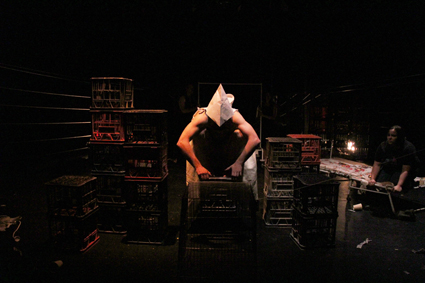
Ian Sinclair, Birdboy
photo Samantha Hughes
Ian Sinclair, Birdboy
I felt less empathy for Birdboy’s Miss Nightingale, who lives with her caged son and dozens of birds. She sings nightly for him and her feathered fans, reliving her fleeting glory as a radio star. Upon his mother’s sudden death, the boy is discovered by a neighbour who takes him in, and he discovers life beyond the confines of his enclosure. Inspired by a factual account of a seven-year old Russian boy who was raised as a pet bird by his mother, The Wet Weather Ensemble’s latest work struggles to get airborne. Wavering between drama, satire, musical parody and soap opera, Birdboy is tonally unsure and uneven. Ian Sinclair’s performance as Miss Nightingale enlivens the piece with his “Baby Jane”-meets-“Mommy Dearest” theatricality. St John Cowcher as the boy is sweet, and yet his enigmatic portrayal prevents any insight into Birdboy’s emotional journey, while the introduction of romantic interest between him and his rescuer is particularly incongruous. Not without charm, Birdboy, a creation of Perth’s The Wet Weather Ensemble, could benefit from a return to the development room and firmer directorial vision.
uta uber kool ja
Prima donna peevishness is more palatable in the guise of Uta Uber Kool Ja. Having thrown parties in Adelaide, Sydney and Melbourne in 2012, Uta and her manager George celebrate a new year with Uta’s comeback tour in Perth. Uta invites guests to her hotel room for an immersive performance comprising diva antics and drug-induced flashbacks. The story of Uta’s discovery, her (sort of) fame behind the Iron Curtain, celebrity love affairs, tormented marriages and her life alongside Vivienne Westwood are all laid bare. Meanwhile, George ensures the champagne and flattery flows, enlisting the party-goers to keep Uta’s ego afloat.
With dress-ups, dancing, party games and more spandex than this side of 1985 has seen, Uta celebrates the launch of her remixed single. The guests revel in the sheer hedonism that is Uta—a blend of Eddie and Pats with a touch of Marianne Faithfull. As the party draws to a close, the act of stripping back her character to reveal Georgina Symes (the Melbourne-based actress) is a little capricious. After being so immersed in the world of George (Nic Dorward) and Uta, her exposure as a mere character was a paroxysm of reality I couldn’t accept – lang lebe Uta!
the three little pigs
Rob Van Vuuren & The Pink Couch’s The Three Little Pigs is a well-oiled, South African political comedy-thriller take on the traditional children’s tale. Inspired by the daily newspapers and drawing its gritty aesthetic from TV shows like The Wire, it dissects the politics between media and government and the corruption within law enforcement in modern South Africa with an Orwellian sensibility. Distressed and terrified by the slaughter of his two brothers, the last little pig turns to the cops—notably a chicken and a goat—to investigate the brutal murders in a world teeming with sly and desperate personalities, where morality is eschewed.
The actors play multiple roles, but James Cairns stands out with menace and frightening exactitude as the chicken heading the investigation; Albert Pretorius’ goat is weary and bitter within the political machine, and Rob Van Vuuren’s many hapless and wretched characters, including a piggish security guard, a raw-boned rabbit who owns a gym and an erotic dancing cat, are delivered with fine physical humour, providing welcome relief from the ominous tension. Director Tara Notcutt transforms the action with ingenuity; however, the demise of the Big Bad Wolf plays out rather softly for a play that touts Tarantino as an influence.
The Three Little Pigs renewed my faith in theatre as a potent medium for telling stories of our time: its observations on and satire of contemporary South African society and politics give it immediate currency, yet it is also a play that stands up in any number of contexts as a comment on the abuse of power. To paraphrase Orwell, it is a rare beast that can fuse political with artistic purpose into a cohesive whole
Fringe World 2013: The Blue Room Theatre Summer Nights, The Last Tuesday Society & PICA, Sweet Child of Mine, directors Bron Batten, Gerald McCulloch, PICA, Feb 4-8; Side Pony Productions & Weeping Spoon Productions, The Wives of Hemingway, writer-director Zoe Pepper, North Perth Bowls Club, Feb 8-16; The Blue Room Theatre Summer Nights, The Wet Weather Ensemble & PICA, Birdboy, director Moya Thomas, Ian Sinclair, PICA , Feb 11-16; Army of Love, Uta Uber Kool Ja, creative producer Nic Dorward, performers Georgina Syme, Nic Dorward; Riverview Hotel Feb 12-23; National Arts Festival South Africa, Rob Van Vuuren & The Pink Couch, The Three Little Pigs, director Tara Notcutt, The Courtyard State Theatre Centre of WA, Perth, Feb 12-24
RealTime issue #114 April-May 2013 pg. 48
© Astrid Francis; for permission to reproduce apply to realtime@realtimearts.net
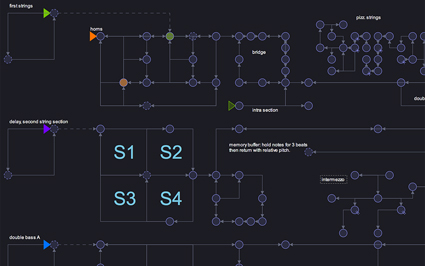
screen grab from Nodal, Jon McCormack, Peter McIlwain, Aidan Lane
THE SHORT-LIVED CONCERT SERIES LURK, RUN BY UK COMPUTER MUSICIAN ALEX MCLEAN, HAD THE TAGLINE “SOFTWARE TO MAKE MUSIC TO DRINK BEER TO.”
Lurk, like most of McLean’s activities, elegantly draws attention to this world of burgeoning activity in enchanting language; humanising the creative use of machine instructions, reminding us that with software code, as with any other human tool, it’s what you do with it that counts. In general McLean’s writing is indicative of a new generation of individual creative coding, powered by the evolution of flexible and social software development tools.
uncharted territory
The allure of software programming is that there is so much uncharted territory. The blank code editor is like an artist’s blank canvas or a writer’s blank page. The cliché that programming is the new literacy is fitting, not just because code offers a new handle on information but also because of its potential for self-expression and new ways of thinking, dependent above all on its open-endedness. An important aspect of creative coding is the ever-changing relationship between people in the production of tools and outputs.
a single process
In Alistair Riddell’s short history of Australian computer music in Experimental Music: audio explorations in Australia (ed Gail Priest, UNSW Press, 2009), a prominent theme is the fusion of coding and creative practice in a single process, the code being the unique means by which certain creative goals can be achieved. This contrasts with what many would consider a normal state of affairs, where programmers create tools to be used by artists. But the in-between space that has grown to maturity is illustrated by Riddell in early examples, such as the work of Graeme Gerrard or Greg Scheimer, developing software for their own projects that is then adopted by their contemporaries. The creative development of a system goes on to be a useful tool for others, and lives as both infrastructure as well as artwork in its own right.
Fast forward to today and the growth of such activity has naturally echoed the technological Cambrian explosion that computers have unleashed universally. A diversity of patterns and relations is unfolding.
software for making art
Developed single-handedly by Melbourne’s Ross Bencina for over a decade, AudioMulch is pro-audio software that lets you fluidly whip together virtual music-making machines. AudioMulch fits the model of commercial tool: developed by developers, used by artists (except that Bencina is its quintessential pro-user), performing delicate works that bring out its innovative design. Beyond Bencina’s use of it, AudioMulch reveals further versatility in the hands of original artists such as the USA’s Girl Talk or the UK’s Four Tet, who enthuse about its non-linear approach and its focus on live sound creation.
For an increasing number of artist-programmers, the distinction between the world of software-as-art and the world of software-to-make-art is more blurry, and the growing norm for many is to straddle both.
software as art
Australian systems artists such as Jon McCormack create works that exploit the patterns and properties of natural processes in code, rising to the philosopher Manuel de Landa’s challenge that artists must “be able to hack biology, thermodynamics, mathematics and other areas of science.” Typically digital artworks are manifestations of custom programs, but once in a while a project idea emerges instead as a creator’s tool, destined for public consumption. McCormack’s recent collaboration with Peter McIlwain and Aidan Lane has led to Nodal, a music-making tool based on the flow of data around a user-created network of events, something like a virtual Domino Rally of musical notes. Nodal is quirky and fun but equally usable. Like AudioMulch, it frees you from the musician’s timeline and lets you think structurally about music, a challenge weary producers can delight in.
On a finer, more day-to-day level, software artists routinely deposit nuggets of useful code on the web. Today, collaborative coding environments such as Github and modular creative tools like MaxMSP, encourage distributed modular development that is always “to share,” though one problem that arises from the uninhibited sharing of software is the resultant minefield of usability.
For some, the relation between art and tool development is even more tightly intertwined. Perhaps Australia’s best case is the “live coding” software developed by Brisbane’s Andrew Sorensen. Sorensen’s Impromptu and Extempore environments are software tools that let you write code live to make music, emerging from earlier work by Sorensen and Andrew Brown on the software library jMusic. “Live coding” describes the idea of writing code live in performance, often as an act of performance. Sorensen’s Vimeo channel hosts an archive of such work.
That Sorensen is making software to make software to make music to drink beer to is true to the experimentalism of Toplap, live coding’s “temporary organisation.” The deep food chain of creative software development is revealed; we don’t just take inspiration, or even remix each other, but deposit nuggets of infrastructure on the web to add to a many-layered creative ecosystem. With usable code being the object of exchange, along with traditional know-how, the idea that digital artists are “standing on the shoulders of giants” takes a more concrete form.
Programming is also getting easier, and the creative coding world is developing its canon, with publications such as “Generative Design,” and mass-popularisation via The Creators Project. Public discourse contains references to code as “the new literacy” (or for some peculiar British minds, “the new Latin”).
Creative coding is also not just for cyberspace, with a new generation of user-hackable physical computing technologies visibly eroding what BBC technology writer Bill Thompson calls the hacking world’s “brief sojourn in the virtual.” A recent Australian start-up, Ninja Blocks, offers a suite of plug-and-play wireless modules entering the growing marketplace of the soon-to-be-ubiquitous Internet of Things. Ninja Blocks form a wireless network of sensors, buttons, power switches and so on. Their key design feature is that they can be easily hacked by a software-literate user base, and the company’s focus is on this ease of development, the holy grail of creative coding success.
steim, amsterdam
The relations between networks of technologists and artists are also mediated in diverse social ways. A long-standing European example, The Studio for Electro-Instrumental Music (STEIM) in Amsterdam, is a hub of music electronics experimentation that has hosted residencies by Australian creators such as Bencina, Douglas Khan and improviser Jon Rose, whose work includes electronically augmented violin bows and the use of bouncy balls as wireless musical controllers for gamified interactive compositions. Through its residency program, STEIM offers creative practitioners tailored technical support in the development of electronic instruments and provides a suite of their own instruments and software.
STEIM is a pleasantly informal hub for creative technological collaborations that creates a notable niche for the grassroots DIY scene—exemplified by a worldwide network of Dorkbot meet-ups and collectives such as Hand Made Music in Melbourne—commercial projects, umbrella initiatives such as the Australian Network for Art and Technology and the many academic hubs researching creative technologies. STEIM leans towards the maker/tinkerer mode of production and social organisation, embodying a passion for creative tool-making. As the role of the technologist becomes more prominent and also more diverse, this offers one model for the arts to incorporate sustained tool development and design into its ecosystem. New emerging Australian organisations such as Media Lab Melbourne, hosting short-term creative hacking collaborations —“sprints” in their parlance—are innovating alternative manifestations of the artist-technologist relationship. More variations on this theme are bound to arise, and should be welcomed, as this Cambrian explosion continues.
RealTime issue #114 April-May 2013 pg. 49
© Oliver Bown; for permission to reproduce apply to realtime@realtimearts.net
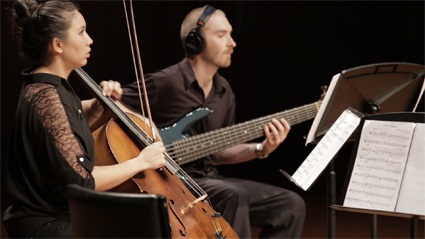
Ezmi Pepper, Joe Manton, Seven Stations: Love Poems for Sydney
photo Hospital Hill
Ezmi Pepper, Joe Manton, Seven Stations: Love Poems for Sydney
THERE WAS A CELEBRATORY NOTE IN THE AIR WITH THE FIRST CHRONOLOGY ARTS CONCERT OF 2013 MARKING THE 65TH BIRTHDAY OF THE ORGANISATION’S PATRON AND ONE OF ITS COMMISSIONERS, CHARLES DAVIDSON, AND THE COMPLETION OF WORKS COMMISSIONED FOR THE OCCASION.
The Acacia Quartet chewed into Movement I of Daniel Manera’s first String Quartet with evident enjoyment, the occasional tonal chord glimmering amid the bare, striated textures like pyrites within quartz. The quartet carefully groped their way through Manera’s taut clusters, unease building towards a claustrophic stasis. And when movement’s lush denoument arrived it was with a sense of relief for musicians and audience alike, full bows opening up the sound in great sucking lungsful.
Written in three distinct sections, former AIDS activist Lyle Chan’s composition, Mark and Adrian are her sons, opened with slight, weightless gestures iterated with increasing frequency, suggesting private anxieties in pre-dawn darkness. Then some threshold was abruptly breached, the Acacia players falling into a jagged, resolute march, coloured by jazzy, almost ragtime inflections. This section, surely reflective of politician Franca Arena’s apparent hostility to AIDS victims who had contracted the disease sexually as opposed to medically, then receded into the warmly concordant finale, a rich melody being skilfully palmed between the instruments. Though effective as program music—the piece being excerpted from Chan’s extended musical memoir for string quartet—as a stand-alone work it did not seem to quite cohere, the final section in particular losing focus.
The first half closed with Perth-based composer Lachlan Skipworth’s where the mountains meet, written specifically for the gorgeously turquoise six-string bass guitar of Joe Manton, who performed the work. Melodic fragments materialised and faded around precisely articulated harmonics, with further overtones resonating like peaks glimpsed through cloud. A further dimension was added to this basic effect with the incorporation of the delay pedal, ascending runs flashing rapidly across the ear, echoes allowed to hang and gradually fade, action and response being contained within a strictly formalised aesthetic reminiscent of tightly choreographed martial art. A beautifully realised performance, made all the more impressive by the severely limited time constraints within which it was apparently prepared.
Seven Stations—Love Poems for Sydney, a song cycle written in collaboration between poet Chris Mansell and composer Andrew Batt-Rawden, draws its inspiration from the railway stations that circle the inner-city—a schematic that seems to reinforce the romantic, tourist-bureau notion that this most suburban of cities begins and ends at the perimeter of the CBD. That said, Mansell’s text here is unabashedly romantic. “I am love” begins the opening song, Town Hall, filled with an unironic immediacy reflected in Batt-Rawden’s directly evocative music: trains shriek through tunnels, muttered spicatto conjuring the “wary scary/ hungry beast” lurking amid the subterranean shopping arcades—Halcyon’s Alison Morgan (soprano) and Song Company’s Anna Fraser (mezzo soprano) chewing, chattering and spitting words like some two-faced creature, the city’s shining self-image doubled by the coiled thing below.
Written for various combinations of soprano, mezzo soprano, bass guitar, viola, cello, percussion, electronics and kalimba (much of the music was written while Batt-Rawden was living in Brazil), the subsequent pieces play off this basic dichotomy to varying effect. St James, a duet for bass guitar and soprano, generates a fraught anxiety, Morgan interspersing precisely articulated text with heavy mouth breathing over Manton’s propulsive bass riff. Sydney Terminal, a cooing lullaby for strings, soprano and bass guitar, didn’t quite seem to capture the grinding limbo of Central Station filled with “fresh fodder/ new meat/ for the city,” though the repetition did recall Cityrail’s festive season habit of playing a single Christmas song on loop.
Redfern was more successful, stalactitic electronics and dissassociative bongos contrasted with the smooth control of Ezmi Pepper’s cello playing to evoke the “depleted girls too drunk to walk” and the “madonnas and a man walking his pig.” Less so was Museum, Fraser donning black gloves and red shoes for some almost burlesque showmanship, Sydney being presented as “liminal and silly/ this beat and rattle girl/ with a bad bad past,” purring and trilling over bowed drums and cymbals. Surely a missed opportunity to present the city as Drag Queen.
Though brimming with intriguing effects, “grey fear cruis[in-g] below” suggested by glistening viola double stops and chittering wood blocks, The Quay suffered from Batt-Rawden’s journeyman conducting, a problem compounded by the score’s page order becoming muddled. Similar issues plagued Sydney Terminal as well as the final section of the work, Kings Cross—though the musicians maintained the densely chromatic evocation of “where the polygamous money lies” with admirable poise, the vocalist’s weirdly enunciated spoken word being contrasted with a shriekingly hectic cello figure, energetically delivered by Pepper. Difficulties in execution notwithstanding, Seven Stations seemed at times weighed down by the conceit of the concept, straining against but never quite escaping the lure of “singular tragedies and perfect farces.”
Seven Stations: Love Poems for Sydney, Chris Mansell & Andrew Batt-Rawden, Daniel Manera, Lachlan Skipworth, Lyle Chan; Music Workshop, Sydney Conservatorium of Music, March 1
RealTime issue #114 April-May 2013 pg. 51
© Oliver Downes; for permission to reproduce apply to realtime@realtimearts.net
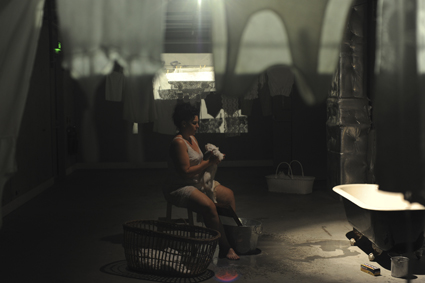
Sarah-Jane Norman, The River’s Children (2013), Unsettling Suite
photo Heidrun Löhr
Sarah-Jane Norman, The River’s Children (2013), Unsettling Suite
IN CARRIAGEWORKS BAY 19, A SERIES OF ROOMS, ENTERED VIA A SMALL SANDY HALLWAY, HAS BEEN CREATED BY DIVIDING THE SPACE WITH BARELY TRANSPARENT, PLASTIC WALLS. THE EVOCATION IS OF AN EPHEMERAL SPACE IN WHICH ARE FOUND QUITE SUBSTANTIAL ACTIONS AND OBJECTS, LARGELY DOMESTIC, FEMININE AND HISTORICAL IN CHARACTER—WITH A DISTINCTIVE EDWARDIAN FEEL.
Washed white clothing hangs outside the ‘house’ on one side, and on another is a laundry—a bathtub, basket, Sunlight soap, signs of recent washing and more clothes, this time providing a screen for projections of labels (eg “1849, hospital”). Other suggestions of a lived-in abode include a functioning kitchen and dining space, with an oven and signs of recent cooking. A sideboard displays hand-painted crockery.
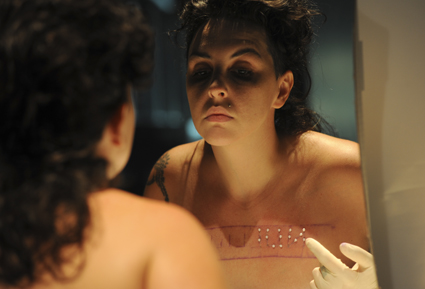
Sarah-Jane Norman, Corpus Nullius/Blood Country (2013), Unsettling Suite
photo Heidrun Löhr
Sarah-Jane Norman, Corpus Nullius/Blood Country (2013), Unsettling Suite
The house ambiguously connotes ownership, servitude and artistic creativity. Replete with a boudoir, it implies the presence of the ‘lady of the house.’ On the other hand the labour suggested in the kitchen and laundry conjures images of young Aboriginal women in the 19th and 20th centuries taken from their families and forced into the role of maids. It also evokes the home of an artist with scholarly inclinations and is suffused with her blood—in the paint on the crockery (Heirloom Dinner Set), in the scones the gallery-goers are invited to have with their tea after witnessing their making (Take this for it is my body), and in the handiwork of the woman of the house (Corpus Nullius/Blood Country). The word ‘Terra’ (as one part of ‘nullius’) is partly embroidered with thread and blood onto shaved sheepskin. Among more sheepskins, a negligee hangs from the ceiling, a crinkled, shiny cast, like the discarded shell of an insect, a relic of the owner and the artist’s embodiment.
Less obviously domestic is a room with a museum case containing a sugar cast of the artist’s leg—on a white mattress over red soil—being slowly devoured by native ants. Another room is a genteel workspace where words from Aboriginal languages have been meticulously carved onto sheep and cattle bones. Some of these are also displayed in a museum case.
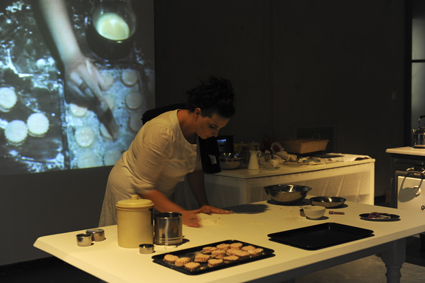
Sarah-Jane Norman, Take This, For It Is My Body (2013); Unsettling Suite
photo Heidrun Löhr
Sarah-Jane Norman, Take This, For It Is My Body (2013); Unsettling Suite
The house comes alive when Norman appears, brusquely inviting visitors to take tea and scones, emptying drops of her blood from a vial into the scone mix, cooking, serving and issuing orders to her guests. Here she embodies at once householder, maid and artist. This is one of several performances (another is the ‘embroidery’ of “nullius” onto the artist’s chest with pins in the lady’s parlour) built into Unsettling Suite—and unsettling they are in a work already disturbingly resonant. As Norman explains in a realtimetv video interview, “each part of the work has a material element and a bodily part or gesture.” Wool, meat, cotton and sugar found in homes also represented the economic power of colonialism and the displacement of Aboriginal people from their traditional lands.
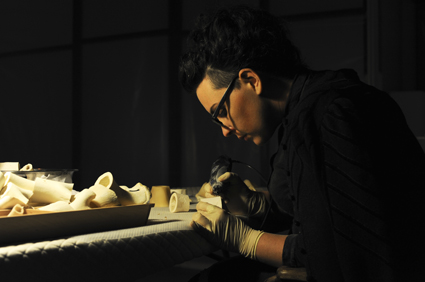
Sarah-Jane Norman, Bone Library (2013), Unsettling Suite
photo Heidrun Löhr
Sarah-Jane Norman, Bone Library (2013), Unsettling Suite
The bones (engraved, dated and catalogued) in Bone Library comprise a dictionary of extinct Aboriginal languages; pieces can be taken in trusteeship by visitors. They may also participate by offering white clothes to be washed in water from the Hawkesbury River, “which runs through my grandmother’s country,” says Norman, “country with a dark history.” The projections onto the clothes list the dates and places of recorded massacres of Indigenous people. As Norman says, contributors’ clothes are returned, “imbued with this trace of a very violent history.”
Unsettling Suite, finely curated by Performance Space, comprises installations and performances created over a number of years as Sarah-Jane Norman has steadily built her practice. They have evolved into a single creation of great power at once subtle and necessarily confronting. As she says, these works “add up to a lot of heavy, heavy shit and very complicated shit. There’s a lot of rage…in a very quiet meditative space…[T]he unreconciled miasma of our collective history is filtered through my body into this work.”
realtime tv interview
See Sarah-Jane Norman’s article, “Blood is such clever stuff,” in the RealTime RealBlak edition (RT111) and the video interview on realtime tv.
Performance Space, Matters of Life and Death: Unsettling Suite, artist Sarah-Jane Norman; Carriageworks, Sydney, Feb 22-March 10
RealTime issue #114 April-May 2013 pg. 52
© Keith Gallasch; for permission to reproduce apply to realtime@realtimearts.net
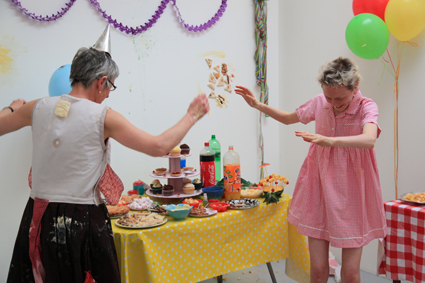
Sarah Coggrave and Bronwyn Platten, Untitled (The Party), 2011—a short film conceived and performed by co-collaborators Sarah Coggrave and Bronwyn Platten for Mouths and Meaning. Filmed and edited by Insa Langhorst with still photography by Huw Wahl
WORKING IN THE UK SINCE THE LATE 1990S, BRONWYN PLATTEN MADE A WELCOME REAPPEARANCE IN ADELAIDE THIS YEAR. HER MOUTHS AND MEANING EXHIBITION EXAMINED IDEAS ABOUT EMBODIMENT AND BODY-CONSCIOUSNESS, THE BODILY EXPERIENCE, AND RELATED PHOBIAS AND CONDITIONS (BULIMIA, ANOREXIA) AND SOCIAL, GENDERED ATTITUDES TO THE BODY. WHILE A NUMBER OF SMALLER OBJECTS AND STILL IMAGES SERVED AS BAFFLES, COMPLICATIONS TO THE MAIN FOCUS, FILMED WORKS DOMINATED.
Untitled (The Party) (2012) was projected large, to wall-filling size in a room to itself. Its soundtrack—intermittent and with long stretches of silence, but regularly bursting out into a goony, boisterous frivolity—filled the gallery, advertising the film’s presence if you had just entered, reminding of its story and content once seen.
Running for just a little under 20 minutes, it offers itself as both narrative and documentary and as a child’s story. A young woman turns up to a door, knocks and enters to meet an older woman and there they have a party: cakes and fizzy drinks. Platten’s collaborator, artist Sarah Coggrave, is the shy, uncertain visitor—addressing the door tentatively, entering slowly, filmed from behind and below. Her red balloon lingers briefly, caught outside the door before following her in. Inside, Platten sits at a table repeating to herself, “Mum, mum, mum, Mum; mummy, mum-mum mum”—writing the words as she speaks. So, mother(s). We are quietly shown the room with its arrayed feast of sugared and creamy fare. Some plain black shoes are filled with whipped cream and feet are plunged into them, the cream squelches luxuriantly as the foot enters, and again as the laces are pulled tight. A moment for both glee and revulsion. Hilarity begins, and the ‘comic’ music. The two don conical party hats, stomp about and attack the food, blow paper trumpets etc. An exorcism.
The film’s longueurs are calming. If exorcism—or facing-down—is the point, it seems a simple exercise: the pace is leisurely, the actions few. The pay-off is a kind of capaciousness that allows the viewer to entertain as many of the various thoughts, the various attitudes about these matters, as might suggest themselves. The Party holds them in suspension, or in slow revolution.
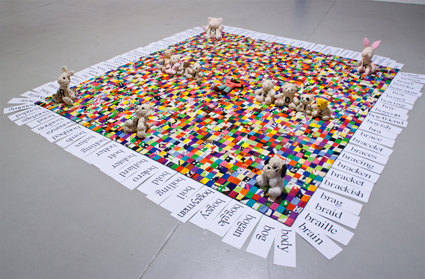
Bronwyn Platten, For more and more love hours (R.I.P. Mike Kelley 1954-2012), 1973-2013, hand-stitched marimeko quilt, found soft toys, oats, liquorice, treacle
photo Alex Lofting
Bronwyn Platten, For more and more love hours (R.I.P. Mike Kelley 1954-2012), 1973-2013, hand-stitched marimeko quilt, found soft toys, oats, liquorice, treacle
A floor-piece sits centre gallery, a large, brightly checkered hand-sewn blanket, a tribute to artist Mike Kelley—with the initials, M. K., RIP, and dates of birth and decease, borne on the chests of soft toys arranged there—bears, dogs—each covered in breakfast oatmeal. (Abjection, shame are the terms associated with Kelley.) Around the blanket’s perimeter is a fringe of boldly printed words. All begin with ‘B’ and are to do with physicality, the body, with activities that a self might undertake or enact as a role-playing, gendered being. (Body, boo, boohoo, boobs, booby, book, bookish, boss, bossy, bosom, boy, boycott, bounce, bouncer, bow, bowel, bowl, brain).
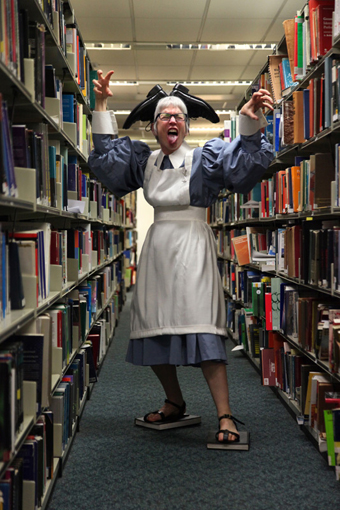
Bronwyn Platten, body to brain and back again, 2013, still of filmed performance
photo Huw Wahl
Bronwyn Platten, body to brain and back again, 2013, still of filmed performance
It is these words, taken from a child’s dictionary, that Platten does brief, three-to-five-second impressions of, one after the other, in the sequence that they follow around the sculpture—in the film on the nearby screen—as in the manner of charades. A little like a one-woman Haka, with a wider range than just the usual threat to devour and rend: demonic and graphic and sometimes inscrutable, at others ticklingly on-the-money. Platten is filmed—fixed camera, the action sped up—between the shelving stacks of a library. So, framed by books either side—in a rather full, dowdy pale blue frock, with serviceable pinafore. On her head are draped a pair of upside-down (men’s) black shoes—heels at the centre of her head, the toes above each ear. The silhouette says (to me, anyway), ‘Dutch milk-maid.’ Under each foot a book is strapped. (Knowledge? Theory? Yes, the feet-above-the-head—body-over-the-cultural, over ‘ideas’—signals a kind of topsy-turvy or reversal.) Platten swaggers and stomps about, crouching, gesticulating, remonstrating, shaking her fist, clutching at her stomach, adjusting an imaginary bra, swaggering, slumping, slouching, perorating—ingratiating or coquettish, threatening or stern. Mad and very funny.
Titled body to brain and back again (2013), the film, on permanent, crazy rotation, renders the words and the kind of definitions we might imagine for them suddenly literal, ‘embodied,’ all vague nuance banished: as if ideas—abstract, nebulous—are just so many wisps-of-nothing, each one dispatched. At its regular beginning Platten stands, ready—ready for the roll-call of words to begin, her mouth tightens then opens slightly and we see that she is breathing like an athlete readying for a test, her chest rising and falling. Heroic. Then the action begins.
Bronwyn Platten, Mouths and Meaning, Australian Experimental Art Foundation, Adelaide, Feb 1-March 2
RealTime issue #114 April-May 2013 pg. 53
© Ken Bolton; for permission to reproduce apply to realtime@realtimearts.net
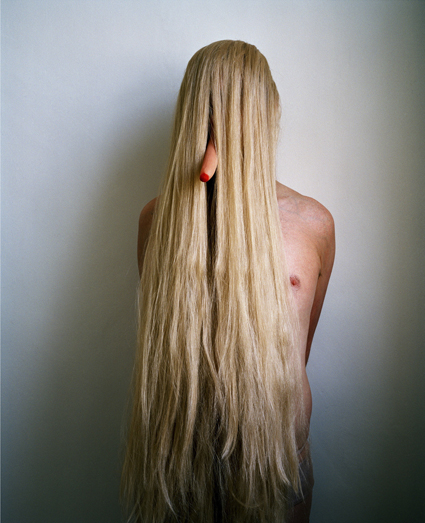
Polly Borland, Untitled IV from the series Smudge 2010; We used to talk about love, Balnaves contemporary: photo media; AGNSW
courtesy the artist and Murray White Room, Melbourne
Polly Borland, Untitled IV from the series Smudge 2010; We used to talk about love, Balnaves contemporary: photo media; AGNSW
A LONG WEEKEND CAN BRING A DIVERSE CROWD INTO A GALLERY AND SO ON A BUSTLING EASTER SATURDAY I FOUND MYSELF OBSERVING WITH SOME FASCINATION THE REACTIONS OF AUDIENCES TO THE LATEST BALNAVES FOUNDATION EXHIBITION, WE USED TO TALK ABOUT LOVE, AT THE ART GALLERY OF NEW SOUTH WALES.
The combination of a re-engineered viewing space (a collaboration between curator Natasha Bullock and architect Jan van Schaik), which adapted the galleries into an intimate labyrinthine configuration, and the lyrical quietness emanating from the vernacular subject matter resulted in a focused viewing experience with a stilling effect, yielding some surprising results.
Most striking was the communion taking place in the darkened, altar-like space housing Grant Stevens’ minimalist video installation, Crushing (2009), where audiences appeared mesmerised by the drift of white text messages floating across the black screen. Set to a wistful piano soundtrack, the texts sharpened into focus and then faded out, coalescing into a loose narrative that poignantly conveyed the anguish of a break-up. Families leaned in closer to one another as they watched, mothers stretched their arms around their kids to offer comfort and one man gently rested his hand on his wife’s shoulder. Despite the banality of the phrases, this intuition of the universal experience of rejection aroused an atmosphere of shared vulnerability in the space.
Not all works in this exhibition of photomedia by 11 contemporary artists exploring the theme of love were intended to provoke such strong affects. Still, emotional responses were encouraged by Bullock’s thoughtful curating which sought to chart the more treacherous, taboo or melancholic, rather than sentimental, territories of love. There were allusions to the complexities and contradictions of young love, for example, in such works as Angelica Mesiti’s video Rapture (silent anthem) (2009). Capturing the spiritual quality of the idolatrous fervour of a crowd of sweaty teenagers in a mosh pit, Mesiti also tapped into the powerful role that projection and transferred affection play in sublimating overwhelming feelings like love in the transition into adulthood.
Far from the collective euphoria of this scene, there was much solitude and yearning in the slickly aestheticised photographs of David Sylvester. Redolent of advertising images in their strategic placement of consumer items, Sylvester’s photographs suggest stories around isolated figures. In one image, a forlorn high school student clutches a break-up letter while in another a teenage couple in a library appear trapped in the gaze of their peers. These emotionally stranded protagonists disarm the viewer in their incongruence with the breezy confidence and self-assurance we have come to expect of the subjects of aspirational mass-media culture.
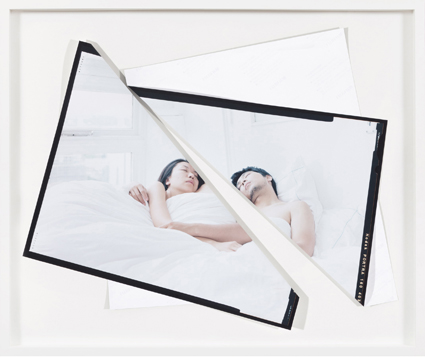
Paul Knight, Untitled (2012), We used to talk about love, Balnaves contemporary: photo media; AGNSW
image courtesy the artist
Paul Knight, Untitled (2012), We used to talk about love, Balnaves contemporary: photo media; AGNSW
A show about love would be incomplete without reference to the body and while sex was not a strong feature of this exhibition, it did take an expansive approach in this area. In a section themed To Begin with the Flesh, the very different works of Polly Borland and Paul Knight, for example, were connected by their impulse to push beyond idealised representations of the body that curtail our appreciation of the complexities of sexual language.
Standing before Borland’s Smudge (2010) photographs, I overhead one viewer describe the work as “nightmarish.” But what, exactly, is the nature of Borland’s nightmare? In this uncompromising and oddly humorous suite of portraiture, sitters dressed in stockings, lycra, prosthetics, wigs and other accoutrements, are transformed into uncanny, post-human creations. Here it is arguably the repression or shame caused by fear of the body that is depicted as more ugly than whatever one feels compelled to hide. Also concerned with the limits of photographic representation were Knight’s candid photographs of couples in bed. Literally folded to partially conceal the nudity of their subjects, this cleave in the images alluded to the doubleness of physical intimacy as a tightrope dance between togetherness and separation.
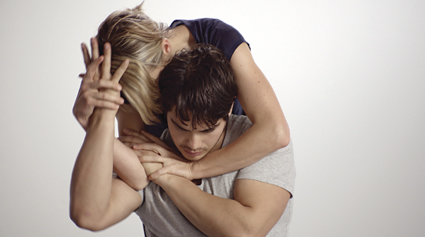
David Roseztky, How to feel (still) (2011), We used to talk about love, Balnaves contemporary: photo media; AGNSW
image courtesy the artists and Sutton Gallery Melbourne, © the artist
David Roseztky, How to feel (still) (2011), We used to talk about love, Balnaves contemporary: photo media; AGNSW
More pervasive than the body, though, was the question of whether living in an age of rampantly proliferating ‘connecting’ technologies is actually making it any easier to express profound emotions like love. The resounding response offered here, implicitly rather than explicitly, was no. Painting a particularly alienating picture was David Rosetzky’s feature length video, How To Feel (2011), in which the artist collaborated with a choreographer and dramaturg in bringing together a group of actors in a warehouse setting where they explored, verbally and non-verbally, the challenges of authentic communication and social interaction. The dance sequences were perhaps more effective than the dialogue, which at times felt a bit contrived, in conveying the psychological barriers and defences that the individual pushes against in the daily performance of the self.
Contemporary art and love haven’t always shared an easy relationship. During the 20th century, in particular, its feminised associations positioned love as an unmodern theme. In her introductory essay, however, Bullock notes a recent paradigm shift as emotion, intimacy and affect become of increasing relevance to artists. This exhibition offered strong supporting evidence for such a shift. It might not come easily but love, it seems, is certainly something we will be talking more about.
Art Gallery of New South Wales: We used to talk about love, Balnaves contemporary: photomedia. Artists Polly Borland, Eliza Hutchison, Paul Knight, Angelica Mesiti, David Noonan, David Rosetzky, Tim Silver, Glenn Sloggett, Grant Stevens, Darren Sylvester, Justene Williams; AGNSW, Jan 31-April 21
RealTime issue #114 April-May 2013 pg.
© Ella Mudie; for permission to reproduce apply to realtime@realtimearts.net
Berberian Sound Studio, DVD plus CD
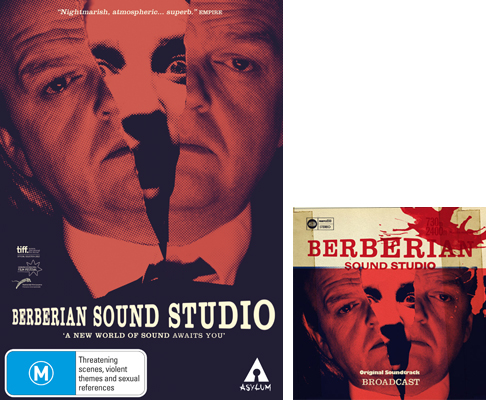 “What is this film about? If one accepts its hypno-haunto inclination, it’s a dual text. One, a dream-narrative about Peter (Toby Jones), a very British sound editor from the mid-70s who ends up producing sound effects for a very Italian mixer, Santini, tracking and mixing an unseen film, The Equestrian Complex, in the eponymous Italian post-production studio. The other, an audiophiliac celebration of the components, procedures and techniques for recording sound effects back then, with an ancillary appreciation of the Italian giallo subgenre of erotic thrillers produced in Italy since the 1960s” (Philip Brophy, RT113). This psychological thriller about a foley artist going mad is accompanied by a CD of the music from the era and sounds, including unnerving screams, from the film.
“What is this film about? If one accepts its hypno-haunto inclination, it’s a dual text. One, a dream-narrative about Peter (Toby Jones), a very British sound editor from the mid-70s who ends up producing sound effects for a very Italian mixer, Santini, tracking and mixing an unseen film, The Equestrian Complex, in the eponymous Italian post-production studio. The other, an audiophiliac celebration of the components, procedures and techniques for recording sound effects back then, with an ancillary appreciation of the Italian giallo subgenre of erotic thrillers produced in Italy since the 1960s” (Philip Brophy, RT113). This psychological thriller about a foley artist going mad is accompanied by a CD of the music from the era and sounds, including unnerving screams, from the film.
3 copies of DVD + CD courtesy of Madman Entertainment
Amiel Courtin-Wilson, Hail DVD
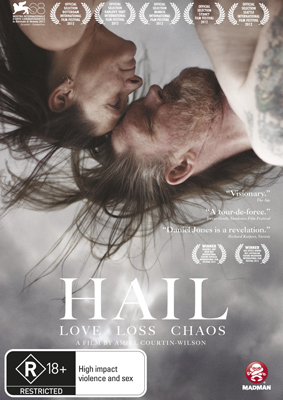 Danny, just out of gaol, struggles to find employment and to confirm love, but circumstances and his damaged psyche coalesce to set him on a path to brutal vengeance. Not a film for the faint-hearted. After seeing Hail at its premiere in the 2011 Adelaide Film Festival, I wrote, “Hail is a drama feature that deftly manages to fuse documentary immediacy (fluid hand-held camera work, raw dialogue) with carefully constructed scenography built around lyrical editing and richly textured and adroitly framed widescreen cinematography (Germain McMicking). It’s a big screen, immersive experience… Despite some uneven plot development, Hail is a remarkable film: Daniel Jones and Leanne Letch’s performances are excellent in their portrayal of a profoundly uneasy love, cinematography is superb and the script tightly focused, conveying both spontaneity and a sense of craft and purpose” (Keith Gallasch, RT102).
Danny, just out of gaol, struggles to find employment and to confirm love, but circumstances and his damaged psyche coalesce to set him on a path to brutal vengeance. Not a film for the faint-hearted. After seeing Hail at its premiere in the 2011 Adelaide Film Festival, I wrote, “Hail is a drama feature that deftly manages to fuse documentary immediacy (fluid hand-held camera work, raw dialogue) with carefully constructed scenography built around lyrical editing and richly textured and adroitly framed widescreen cinematography (Germain McMicking). It’s a big screen, immersive experience… Despite some uneven plot development, Hail is a remarkable film: Daniel Jones and Leanne Letch’s performances are excellent in their portrayal of a profoundly uneasy love, cinematography is superb and the script tightly focused, conveying both spontaneity and a sense of craft and purpose” (Keith Gallasch, RT102).
5 copies courtesy of Madman Entertainment
Searching for Sugarman, DVD
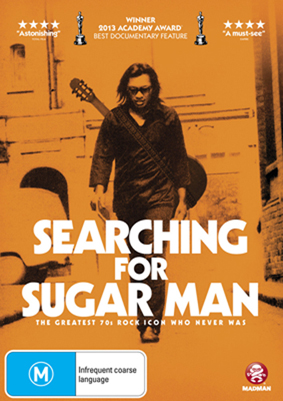 “In the late 1960s, a musician was discovered in a Detroit bar by two celebrated producers struck by his soulful melodies and prophetic lyrics. They recorded an album that they believed was going to secure his reputation as one of the greatest recording artists of his generation. The album bombed and the singer disappeared into obscurity amid rumours of a gruesome on-stage suicide. But a bootleg recording found its way into apartheid South Africa and, over the next two decades, it became a phenomenon. In this Oscar-winning documentary two South African fans set out to find out what really happened to their hero [leading] them to a story more extraordinary than any of the existing myths about the artist known as Rodriguez” (Madman Press release).
“In the late 1960s, a musician was discovered in a Detroit bar by two celebrated producers struck by his soulful melodies and prophetic lyrics. They recorded an album that they believed was going to secure his reputation as one of the greatest recording artists of his generation. The album bombed and the singer disappeared into obscurity amid rumours of a gruesome on-stage suicide. But a bootleg recording found its way into apartheid South Africa and, over the next two decades, it became a phenomenon. In this Oscar-winning documentary two South African fans set out to find out what really happened to their hero [leading] them to a story more extraordinary than any of the existing myths about the artist known as Rodriguez” (Madman Press release).
3 copies courtesy of Madman Entertainment
Please note you can nominate for ONLY ONE GIVEAWAY.
Email us at giveaways@realtimearts.net with your name, postal address and phone number.
Include ‘Giveaway’ and the name of the item in the subject line.
This giveaway is open until June 1.
RealTime issue #114 April-May 2013 pg. 56
© RealTime ; for permission to reproduce apply to realtime@realtimearts.net
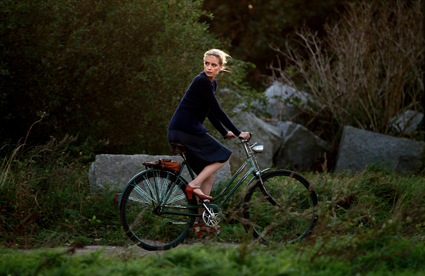
Barbara, © Schramm Film, ZDF, ARTE 2012
A SENSE OF WEARINESS PERVADES CHRISTIAN PETZOLD’S COLD WAR DRAMA SET IN 1980S EAST GERMANY. IT’S THE WEARINESS THAT COMES WITH ALWAYS HAVING TO LOOK OVER YOUR SHOULDER, A STATE OF EXISTENCE BARBARA’S PROTAGONIST IS CLEARLY ACCUSTOMED TO FROM THE FILM’S OPENING SCENE.
As punishment for applying to join her boyfriend in the West, Dr Barbara Wolff is sent from Berlin to work in a provincial hospital, where she goes about her constrained life not only under the watchful eye of the security service but, she assumes, of all her colleagues. House and strip searches occur with cruel regularity. Simultaneously character study, thriller and historical portrait, Barbara is a spare, grim film with an intense focus on its central character. There are very few scenes that aren’t seen through its heroine’s eyes.
The film eschews stylistic flourishes. Its cinematography is austere and naturalistic, though not to the extent of drawing attention to this as an aesthetic decision. There are passages where the beauty of the countryside is evident, but there’s little pleasure to be had in it. Barbara’s world is joyless, and we share her outlook. The film’s sound is similarly spare, its infrequent music executed only by the characters themselves. At one point, Barbara plays the piano and escapes into the music she is producing, but it’s a rare instance in a film whose stylistic severity suggests a world from which frivolity and spontaneity have fled.
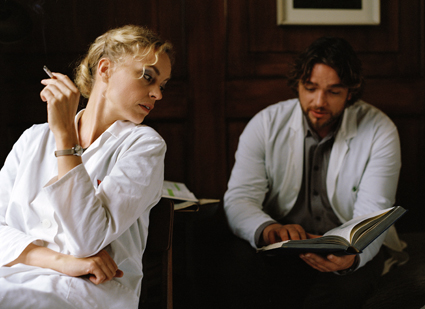
Barbara, © Schramm Film, ZDF, ARTE 2012
The other effect of the film’s lack of stylistic distraction is to focus all attention on character and performance, especially Nina Hoss’ masterful interpretation of the title role. Her performance is one of eloquent restraint. Every physical action, from her slightly stiff carriage to the stifling of normal reactions—the tendency to smile in response to friendliness, for example—gives the impression of a woman under enormous strain. She is ever watchful, ever tensed in anticipation of the next threat to her personal freedom.
Most emotions in the film are internalised in this way, self-policed by those wary of expressing too much in this society where all motives are questionable. Barbara’s colleague Dr André Reiser (Ronald Zehrfeld) is an exception, but in this climate even his kindness seems suspect. That’s not to say the film is black and white in its presentation of East versus West. Barbara’s boyfriend, with whom she shares the occasional illicit tryst, mentions callowly that when she makes it to West Germany she won’t have to work, as he’ll earn enough money for both of them. It’s a statement that gives this highly educated woman, so clearly devoted to her work, pause for thought.
Though Barbara is very effective in its overarching narrative of persecution and heroism, it’s in the smaller moments of quiet humanity that it becomes thought provoking. As the rapport deepens between Barbara and André, the question arises, “Can one make a life for oneself under these conditions?” The possibility is left open at that.
Barbara, director Christian Petzold, screenplay Christian Petzold, Harun Farocki, director of photography Hans Fromm, editor Bettina Böhler, music Stefan Will, 2012; distributed in Australia by Madman Entertainment
RealTime issue #114 April-May 2013 pg. 21
© Katerina Sakkas; for permission to reproduce apply to realtime@realtimearts.net
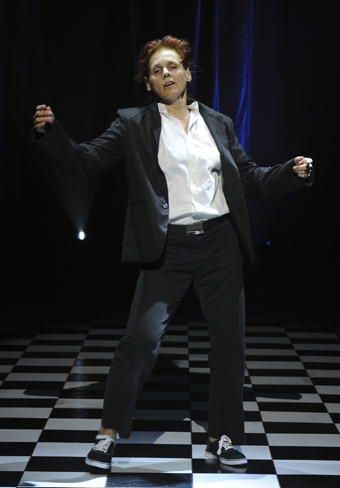
Vicki Van Hout, Slow Dances for Fast Times, choreographer Martin del Amo, Carriageworks
photo Heidrun Löhr
Vicki Van Hout, Slow Dances for Fast Times, choreographer Martin del Amo, Carriageworks
In RealTime114, our writers tumble Alice-like into the rabbit hole of arts festivals. First stop, a cavernous ballroom populated by Melbourne’s Dance Massive, the Adelaide and Perth Festivals and dances in Sydney and Bangkok. Our mirror neurons fire, limbs twitch and fingers glide across keyboards. Next, we’re through a door to a wonderland of Tweedle-Dee Tweedle-Dum international arts festivals and their Mad Hatter kin—Bristol’s In Between Time, Brisbane Powerhouse’s World Theatre Festival and Perth’s Fringe World—all crying out, “Eat me! Eat me!” Ingesting so much art we grow huge, bounding over oceans to ideas-and–action Tea Parties—The 8th Flying Circus Project (FCP) in Myanmar and Singapore, and the World Symposium on Global Encounters in South-East Asian Performing Arts in Bangkok. Out we pop, home, informed, inspired and over-excited, already anticipating the next hallucinatory experience—the Cheshire Cat IT magic of ISEA2013 in Sydney. We need inspiration—we’ve lamentably found ourselves in a very different hole. An international survey has dropped Australia from 9th to 18th in terms of IT accessibility and innovation—simply put, it costs Australians too much to innovate. Off with our heads! But we’ll keep dancing—with Bangarra’s Blak, which includes a new work by young Indigenous choreographer Daniel Riley McKinley, and Lemi Ponifasio’s mindbending Birds with Sky Mirrors at Carriageworks where Vicki Van Hout (pictured here) wowed us in March, dancing to the Jimi Hendrix version of Dylan’s All Along the Watchtower in Martin del Amo’s Slow Dances for Fast Times. Back into the rabbit hole!
RealTime issue #114 April-May 2013 pg. 2
© Keith Gallasch; for permission to reproduce apply to realtime@realtimearts.net
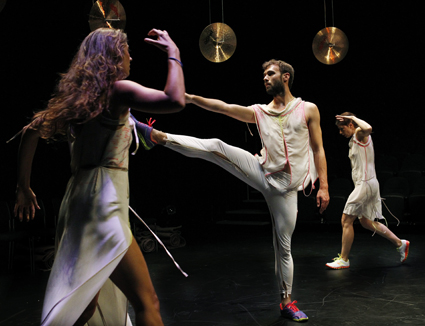
Brooke Stamp, Rennie McDougall, Deanne Butterworth, And All Things Return to Nature Tomorrow, Phillip Adams’ BalletLab
photo Jeff Busby
Brooke Stamp, Rennie McDougall, Deanne Butterworth, And All Things Return to Nature Tomorrow, Phillip Adams’ BalletLab
THE EYES OF BALLETLAB PERFORMERS HAVE A UNIQUE QUALITY. THERE IS A STRANGE, DISTANT, SATISFIED WORLD BEHIND THEM. STRANGE IN ITS EXOTICISCM, DISTANT IN ITS MYSTERY, SATISFIED IN ITS METHOD.
In a work like Amplification (RT102), this quality suggested the serious certainty of mortality—death being exotic, mysterious and inevitably methodical. In a work like Aviary (RT106), this quality infused the occasionally maddening ornithology with an equally maddeningly convincing internal logic—the kind of logic that is masked, impenetrable and yet undeniable. In a work like Miracle (RT93), this quality suited the transcendental mysticism to a tee—is there anyone as strange, distant and satisfied as someone on a higher plane of consciousness?
And All Things Return to Nature Tomorrow is a double bill of works by Brooke Stamp and Phillip Adams that both make full use of the BalletLab corps. Thematically, the works feel linked to Miracle. They are cosmological, ritualistic and transcendental.
Brooke Stamp’s And All Things Return to Nature kicks off the evening in full house lights. We are seated in an unevenly weighted square, where two sides are stacked with audients and two sides are made of only single rows. Above the stage are suspended 16 cymbals that form a golden circle of circles, a halo of musical vibration. The dancers are clad in high fashion sportswear by Susan Dimasi—part Nike the brand, part Nike the goddess. As visual signposts, the design elements point the way clearly enough: this will not be proscenium theatre, we will encounter the celestial, we will be party to mysticism dressed in high technology fibres.
Initially, the dancers move in isolation. They are transfixed by their own paths through space, uninterested in the other, wrapped in the self. Their gentle vocalisations suggest chants, incantations, mantras. Garth Paine’s intensely detailed composition picks these sounds up and layers them, forming a cascading aural blanket of indiscernibility.
As the dancers draw together, Stamp’s choreography echoes one of Phillip Adams’ stylistic touchstones with a prolonged sequence of action—in this case, a shuffling unison of steps. As the four performers stretch from a line to a diamond to a square, the squeak of their sneakers against the floor becomes a lulling certainty. Though their steps never break the unified rhythm, their faces betray some deeper meaning. At times, their eyes subtly shift focus and lose clarity. The strange, distant, satisfied world vacates them and one sees the struggle, the striving and the searching. Higher planes are hard work.
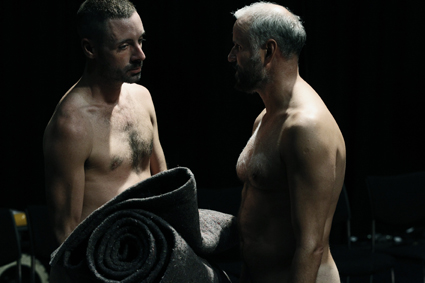
Matthew Day, Phillip Adams; And All Things Return to Nature Tomorrow, Phillip Adams’ BalletLab
photo Jeff Busby
Matthew Day, Phillip Adams; And All Things Return to Nature Tomorrow, Phillip Adams’ BalletLab
In Tomorrow by Phillip Adams, the eyes are back on full beam. Entering naked, the performers build a stage of swags, stones, fluorescent twine, reflectors and audience members. We are courting UFOs, constructing a landing pad and hoping for ascension in the form of abduction. The eyes, the nudity and the whispered intimacies with the front rows set up a peculiar dynamic of compelling coerciveness. What are you willing to do in the safe confines of a theatre with a hundred witnesses? When you look into a naked man’s eyes and see an exotic, mysterious and assured alternative world, will you follow him? It is to BalletLab’s credit that we do. They have created a cult with nothing more than their eyes.
Phillip Adams’ BalletLab, And All Things Return to Nature Tomorrow, direction & choreography Brooke Stamp & Phillip Adams, performers Phillip Adams, Brooke Stamp, Deanne Butterworth, Rennie McDougall, Matthew Day, composer Garth Paine, set design Matthew Bird (Architect), fashion & design Susan Dimasi (Materialbyproduct), lighting Robin Fox, Southbank Theatre, The Lawler, Melbourne, March 15-23
RealTime issue #114 April-May 2013 pg. 35
© Carl Nilsson-Polias; for permission to reproduce apply to realtime@realtimearts.net
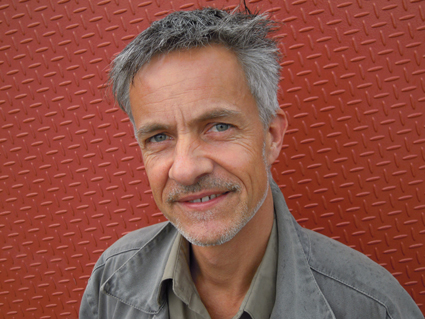
Jonathan Parsons, ISEA Director
photo Maria Barbagallo
Jonathan Parsons, ISEA Director
ISEA2013 IS COMING TO TOWN, A FEAST OF IDEAS AND EXHIBITIONS FOCUSED ON ELECTRONIC TECHNOLOGIES AND THEIR EVER INCREASING PRESENCE IN OUR LIVES AND OUR ART, SUCH THAT WE ARE FREQUENTLY TOLD “RESISTANCE IS FUTILE”—WHICH IS THIS YEAR’S ISEA THEME.
For media artists and media arts academics and anyone intrigued by the impact of new technologies on communication, creativity, culture and ethics, the ISEA [International Society of Electronic Arts] Symposium is a critical, annual, international event, a merging of conference, exhibitions, performances and workshops. Each year since 1988 it’s been held in a different city, for example Nagoya, 2002 (RT53), Singapore 2008 (RT88), Istanbul in 2011 (RT106) and Albuquerque (RT113).
ISEA2013’s director Jonathan Parsons, an experienced festival director and late appointee to this role, just manages to exude his usual clear-eyed charm and good humour under pressure of pulling together a massive event .
Parsons tells me that each city presents the overall event in terms of its own vision and theme. The theme for Sydney is “Resistance is Futile” and the vision for the event extends from Sydney Harbor to the University of Technology, from Carriageworks in Redfern to Campbelltown Arts Centre. Presented by the Australian Network for Art and Technology (ANAT), ISEA 2013 is supported by the Australia Council and—to enable a connection between ISEA and the Sydney Opera House’s Vivid—by Destination NSW.
21 years on
The aim of ISEA, founded in the Netherlands in 1990, is to encourage “interdisciplinary exchange among culturally diverse organisations and individuals working with art, science and technology” (press release). The event was last held in Sydney in 1992. For Parsons it’s a timely return 21 years on. In the 1990s the ‘new’ in ‘new media’ was still meaningful. “Now,” says Parsons, “I think the phenomenon has become all-pervasive to the point where it’s so much part of the fabric of our lives that we’re starting not to notice it. I think that’s an interesting thing in itself to investigate.”
It’s not only that new media are embedded in our lives, but our engagement with them, says Parsons, has matured. Consequently, he’s very pleased with ISEA’s association with Vivid Lights. “Vivid Lights [that aspect of Vivid that lights up the city in unusual and innovative ways. Eds] is an expression of things that could only have been imagined in 1992. They’re quite mainstream now. But that kind of data mapping and its projection were largely only in people’s imaginations back then.”
submission or resistance?
As for this year’s theme, Parsons is clear: “The intention is to trigger discussion. Is the statement about the futility of resistance true? Or how much of it is true? There’s a certain sense of humour to it too. It’s a line that’s been used by many scriptwriters in countless science fiction movies and TV series.” I point out that every time the issue of internet censorship is raised, a host of voices will declare that it’s impossible. “Exactly,” says Parsons, “It’s led to one of the ISEA sub-themes, “resistance is fertile,” a useful counterpoint in the current context.
shaping the event
ISEA is spread over 10 days across greater Sydney. I ask Parsons about the shape of the event. “The core is the conference and certainly the program developed out of that in a number of ways. One of them entails a classic festival strategy: the opportunity for a number of cultural partners and institutions in Sydney to take advantage of the opportunity of having leading thinkers and practitioners in this field coming to the conference, and building on that by presenting their ideas and works publicly.
“Certainly my role has been to both harness that energy and support different cultural organisations to present what they want to do. That’s included an extensive call for proposals from Australia and internationally. So partnerships and invitations have informed the curatorial framework for the program. There’s a continuum with pre-existing programs, like the Anne Landa New Media Arts Award exhibition at the Art Gallery of NSW and Experimenta’s Speak to Me touring show through to projects we’ve curated and are producing ourselves.”
ideas in words: conference & talks
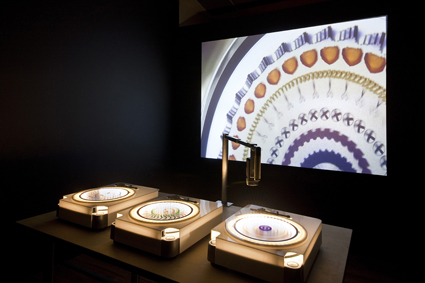
Katie Turnbull, Modern Vanitas 2012
photo Mark Ashkanasy, RMIT Gallery, 2012 (commissioned by Experimenta)
Katie Turnbull, Modern Vanitas 2012
The ISEA Symposium this year is co-chaired by Ross Harley (College of Fine Arts, UNSW) and Cathy Cleland (University of Sydney) who, Parsons says, “have been driving the final selection of papers and presenters. On one level it’s an academic conference so certain processes need to be adhered to in terms of making sure that all the papers are published afterwards and there’s a peer-review process for selection into the conference. We’re providing administrative support. Where I’ve become involved is in the crossover territory—like the selection of keynote speakers. But the conference is just part of a range of talks programs that we’re presenting. The other key component is the Vivid Ideas program.”
The three-day ISEA2013 Symposium features 200 speakers and eight keynote addresses “from global leaders in the fields of art, science, technology, media and communications” on topics including “bio-art, data visualisation, robotics, augmented realities and urban and virtual ecologies” (press release). The ISEA conference keynote speaker is pioneering US media artist Michael Naimark who “has made interactive ‘moviemaps’ and stereo-panoramic movies around the world, ranging from Aspen, Paris and San Francisco to Angkor, Jerusalem and Timbuktu,” exploring “‘place representation’ and its impact on culture” (press release). Professor of Experimental Psychology and Fellow and Tutor in Psychology, Pembroke College, University of Oxford, Brian Rogers will speak on “Perception, Art & Illusion.”
Speaking at Vivid Ideas will be Paul Cirio and Alessandro Ludovico (The Hacking Monopolism Trilogy), “whose infamous online project Face to Facebook involved stealing one million Facebook profiles, filtering them with face-recognition software, and posting them on a custom-made dating website” (press release). Vivid Ideas takes place on the first weekend of ISEA. Parsons says, “the opportunity to work with Vivid was a chance to offer more public presentations, appealing to a broader audience than the conference does.
Other speakers include Stelarc, Mark Hosler of Negativland (US), Kate Chapman (Australia) and Genevieve Bell (Australia/US), Director of Interaction and Experience at Intel Labs—and, says Parsons, an anthropologist by training whom Intel thought might have something to say about the engagement with technology.
ideas realised: exhibitions
![Ryoji Ikeda, data.tron [8k enhanced version], audiovisual installation, 2008-09, © Ryoji Ikeda](https://www.realtime.org.au/wp-content/uploads/art/62/6222_gallasch_isea_datatron.jpg)
Ryoji Ikeda, data.tron [8k enhanced version], audiovisual installation, 2008-09, © Ryoji Ikeda
photo by Liz Hingley
Ryoji Ikeda, data.tron [8k enhanced version], audiovisual installation, 2008-09, © Ryoji Ikeda
The ISEA centrepiece is Ryoji Ikeda’s Datamatics (see cover image) in the huge main theatre at Carriageworks. Parsons thinks some Sydney-siders will remember Ryoji Ikeda from his performances as part of Dumb Type in the 1990s. “Since then,” says Parsons, “he’s moved into solo practice. Sydney has not seen any of his major installation work.”
Ikeda’s test pattern will also have a one-off presentation, again at Carriageworks. Parsons describes it as “a performance that as an audience you can drop in and out of. It’s an even more intense experience than Datamatics. That will be happening on the Friday June 7 as a one-off. It’s our kick-off really for the ISEA’s 10 days and then everything else at Carriageworks, including the installation, will happen from the Saturday night.”
I’m curious about the nature of the Ikeda experience which Parson describes as “intensely visual, and the sound as much a part of it as the visual. The sheer scale assists with this. I can assure you that Ryoji Ikeda absolutely works on the immersive level. There’s quite a refined aesthetic in the work—black and white—a connection with his heritage in Japanese culture.” As well as representing the entwining of tradition and the new, Parsons sees Ikeda as central to the “‘big data’ issue—is data visualisation an artistic practice or not? Certainly it’s true that a lot of artists are becoming interested in that field. To me, Ryoji Ikeda’s work is the ultimate in data visualisation. It’s absolutely about art, purely about the aesthetic quality for which the data and the code can be utilised by him as an artist. It’s not about the content.”
The extensive exhibitions program features works by 150 artists from Australia and around the world. At Carriageworks, Sydney artist Alex Davies will stage Very Near Future, “a large scale mixed reality/interactive cinema installation which will question what is real or virtual, fact or fiction (press release).” At the same venue, Performance Space will present John A Douglas’ Body Fluid II (Redux) (RT106; p44) “ a performance and video installation in which the artist presents the monotony of his daily dialysis treatment as a sublime act of self-transformation.”
Artspace will feature engaging robotics by Mari Velonaki (Australia)—involving a very human humanoid robot; Petra Gemeinboeck & Rob Saunders (Australia)—“an infestation [by] a colony of curious, social machines hidden within the Artspace gallery walls”; and Simon Ingram (New Zealand)—“a cluster of machines paint live in the space through an operational system run remotely by the artist in Auckland.”
Catching Light is an exhibition staged by Campbelltown Arts Centre which has “brought together five creative innovators from the analogue and early digital eras to mentor, collaborate and exchange ideas with five ‘new generation’ artists from various disciplines—art, sound and performance—who have a practice reliant on engagement. The teams are Linda Dement & Kelly Doley; Tom Ellard & Paul Greedy; Troy Innocent & Benjamin Kolaitis; Stephen Jones & Pia van Gelder; and Wade Marynowsky & Michael Candy.”
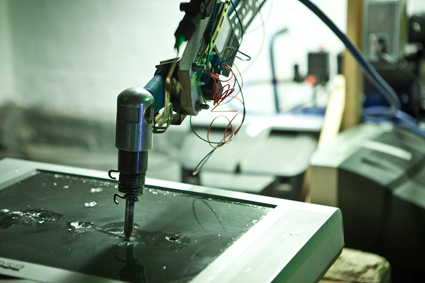
Golden Solution, First Draft Depot
photo Alex Davies
Golden Solution, First Draft Depot
Parsons says of the Running the City exhibition, “It looks in a different way at the resistance theme, about just how this technological work is becoming integrated into the urban fabric, especially via portable devices. What does this technology allow us to uncover or connect to in the city in different ways? Felicity Fenner is the curator and the artists are a mix of Australian and international exploring the theme in a range of different ways. Jun Nguyen-Hatsushiba is a Japanese-American of Vietnamese background, an amazing video artist who was here a few years ago with a beautiful work featuring fishermen pulling rickshaws underwater (Towards the Complex—for the Courageous, the Curious and the Cowards, 2001; RT46). This time his work is very playful. It’s set up like a jukebox and people are able to choose a video of someone running through different cities in the world.” The other artists are Richard Goodwin (Australia), Volker Kuchelmeister (Australia), Laurent Gutierrez + Valerie Portefaix (MAP Office; Hong Kong), Brad Miller and Ian McArthur (Australia) and Marnix de Nijs (the Netherlands).
Vivid Lights and Experimenta’s Speak to Me will feature Human Effect by Yandell Walton (Australia) in an urban laneway: “Flowering vines twine up pipes and moss and ferns spread across walls, while vividly coloured butterflies alight on window ledges. Echoing ages before human habitation, this scene entices viewers to move closer—only to see the new life wither and slowly die, destroyed by the human presence. The habitat is renewed once more in a riot of foliage and motion as viewers move away” (press release). The rest of Experimenta’s Speak to me (RT112) will be installed at the Powerhouse Museum.
Other exhibitions, says Parsons, cover emerging talent. “The Depot program for example is more grass roots, more underground. It was important for me to create various access points for a range of practices and also for artists at various stages of their careers.”
ideas embodied: performance & participation
As well as Ikeda’s test pattern (a work you’ll be inside rather than simply looking at) there will be a variety of performances including electronic music in NEW WAVE: SOUND presented by Seymour Centre and Vivid Sydney in association with ISEA featuring The Noise, Infinity room, Frostbyte and Collarbones.
A range of performances and workshops in ISEA2013 reveal the diversity of participatory involvement enabled by technologies old and and new. Perth’s tactical media art group pvi collective will take over the streets of Darlinghurst with Deviator: “immerse yourself in an outdoor game experience and become an urban ‘deviator,’ temporarily transforming the city into a playground” (press release).
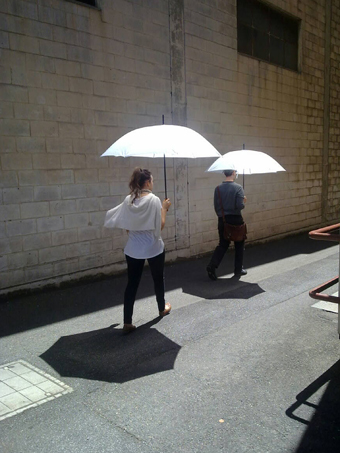
Stereopublic (Crowdsourcing the Quiet), Jason Sweeney
photo Martin Potter
Stereopublic (Crowdsourcing the Quiet), Jason Sweeney
In his review of the music program of the Adelaide Festival, Chris Reid describes Jason Sweeney’s Stereopublic (Crowdsourcing the Quiet), as “an absolute delight for its gentleness and its ability to make you think about sound and listen for it. Sweeney guides participants on a walking tour of city sites with particular sonic characteristics…This is relational art, from which a small community with a new awareness is born, each walking-tour group forming a bond in Trappist monk-like silence.” Stereopublic’s “Earwitnesses” will each receive a soundwork and their “city-specific location will be placed on an ever-growing virtual soundmap of Sydney” (press release).
Other events include Carbon Arts’ The City Data Slam featuring leading national and international data art practitioners, while dLux MediaArts and Dorkbot’s Art Hackfest will connect artists in Sydney, Darwin and Byron Bay.
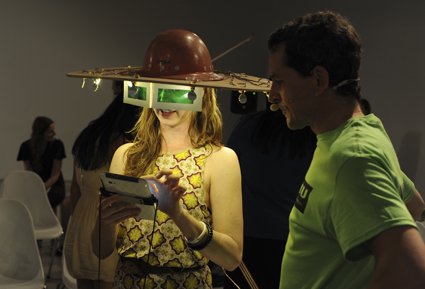
EBEMU, Paul Granjon, Paul Gazzola, Oh! I Wanna Dance With Somebody, Campbelltown Arts Centre
photo Heidrun Löhr
EBEMU, Paul Granjon, Paul Gazzola, Oh! I Wanna Dance With Somebody, Campbelltown Arts Centre
A Paul Gazzola (Australia/Berlin)-Paul Granjon (UK) collaboration “deals with the rise of new generations of inventors and tinkerers, playing with technology in the broader community.” Parsons saw the work, Experimental Body Extension Manufacturing Unit, in Campbelltown Arts Centre’s Oh! I Wanna Dance With Somebody last year (RT112) and “loved the community engagement, the playfulness of it, the mixture of low and high tech. This time they’ll be working within the community around Carriageworks, using the same process, constructing new, fantastical objects of invention.”
An opportunity to engage your body quite directly with technology comes in the form of George Poonkin Khut and James Brown’s Theta Lab, “an experimental art research project combining neurofeedback with participatory art, electronic music and ‘slow design’ to explore and document qualities of attention and subjectivity facilitated by Alpha/Theta brainwave biofeedback.”
While the conference is central to ISEA2013, Parsons and his team have built a substantial public program that encompasses a huge range of responses to the potentials and challenges offered by media technologies, from solo artistic creations to community workshop, from data projection to sound art, to collaborations between artists across generations, all of it positioned across the city. And all of it open to discussion and debate. For Parsons it’s about “what it means to be here now in 2013. Australia has a very important place in international developments in the field of electronic arts, thanks to both its artists and its organisations and institutions.”
Follow ISEA2013 closely by joining RealTime bloggers Urszula Dawkins and Gail Priest. There’ll also be online reviews and video interviews and the launch of the RealTime Media Arts Archive, 1994-present.
ISEA2013, 19th International Symposium on Electronic Art, Sydney, June 7-16; http://www.isea2013.org/
RealTime issue #114 April-May 2013 pg. 4-5
© Keith Gallasch; for permission to reproduce apply to realtime@realtimearts.net
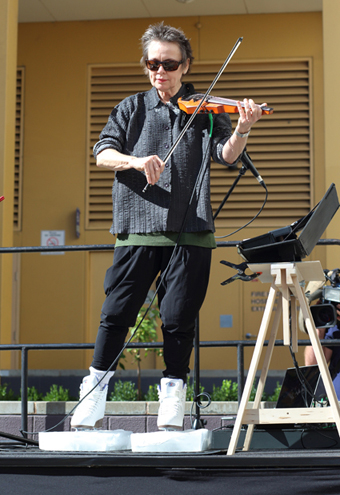
Laurie Anderson, Duets on Ice, Adelaide Festival 2013
photo Tony Lewis
Laurie Anderson, Duets on Ice, Adelaide Festival 2013
LAURIE ANDERSON IS MOST FREQUENTLY SEEN IN LARGE VENUES SHARING SHORT STORIES AND PERSONAL PHILOSOPHY, UNDERPINNED BY GENERALLY HUMMABLE TUNES, SO IT’S NOT SURPRISING THAT SOME MAY QUERY HER UBIQUITOUS BRANDING AS ‘EXPERIMENTAL.’ SHE HERSELF ADMITS TO OFTEN FEELING MORE LIKE A JOURNALIST THAN A DOYENNE OF THE AVANT-GARDE (GRITTV, 2011).
A long-time fan of Laurie Anderson, even I had begun to question how close to the experimental coalface she was operating these days. However the presentation of three major projects as part of the 2013 Adelaide Festival confirmed for me that Anderson’s experimentalism is not something accurately gauged via a single artwork, rather it arises from her consistently multi-disciplinary approach over a 40-year career.
present pasts

Laurie Anderson, Duets on Ice, Adelaide Festival 2013
photo Tony Lewis
Laurie Anderson, Duets on Ice, Adelaide Festival 2013
I arise obscenely early to get to Adelaide from Sydney by 10.30am for Anderson’s performance of Duets on Ice which opens her exhibition The Language of the Future at the Anne and Gordon Samstag Museum of Art. Back in the 1970s Anderson augmented a violin so that it played tape loops allowing her to duet with herself. The loop made the performance potentially endless so Anderson introduced a timing device: embedding ice-skates into blocks of ice, she would play until the ice melted.
Taking place outside the gallery in Adelaide heat, I suspect the performance might be short so I am keen to get there on time. I am a little disappointed that Anderson has replaced her tape-loop violin for her current rig—electric violin filtered through various digital systems—but of course technologies move on and Anderson is well-known for being adaptive and adoptive. It’s not at all disappointing to watch Anderson, a petite woman in her 60s, awkwardly ambulating across the Samstag courtyard to the makeshift stage, large blocks of ice attached to her bright white ice-skating boots. This is an informal and intimate performance (so rare to see experimental music in daylight) and Anderson semi-improvises and chats for 25 minutes, the time it takes for the ice to crack and break away from the skates.
The Language of the Future features five pieces illustrating the breadth of Anderson’s work as visual artist. The centre-piece is The Swimmer (2009-2012), a six-channel video down-projected along the length of the space. The projection surface is made from shredded paper in tight, tiny rolls, the printed text just visible if you peer closely. Seen on the ground floor it adds visual noise to the images creating a kind of analogue pixilation. Viewed from the balcony it appears more three-dimensional—a memory contour map perhaps.
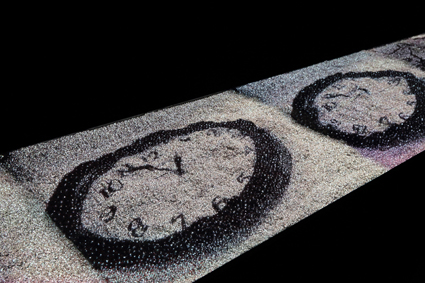
Laurie Anderson, The Swimmer (2009-2012), The Language of Future, Anne & Gordon Samstag Museum of Art
courtesy Adelaide Festival 2013
Laurie Anderson, The Swimmer (2009-2012), The Language of Future, Anne & Gordon Samstag Museum of Art
The video is a visual poem comprising fragmented images—rural scenes, the looming face of a nurse, clockfaces and a rabbit in a wheelchair—some in high-contrast black and white, others in dreamy colour. The images accompany the adjacent piece, A Story About a Story (2012), an artist book exploring the time Anderson broke her back as a child and spent months recuperating in a ward for seriously ill children. It’s Anderson at her most revealing as she admits to subsequently editing out details—the real horror of the situation—in the process of crafting the story into one of her set pieces. She concludes, “You get your story and you hold onto it and every time you tell it you forget it more.”
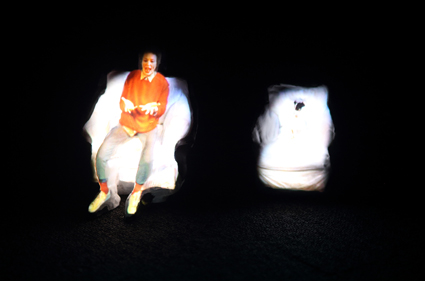
Laurie Anderson, From the Air (2008); The Language of the Future, Anne & Gordon Samstag Museum of Art
courtesy Adelaide Festival 2013
Laurie Anderson, From the Air (2008); The Language of the Future, Anne & Gordon Samstag Museum of Art
The use of a three-dimensional projection surface is something Anderson began in 1977 with her “fake hologram” At the Shrink. She projected an image of herself onto a small three-dimensional plaster figure, giving a beguiling sense of depth and life. From the Air (2008) revisits this technique presenting tiny models of herself and her dog Lolabelle. The Anderson figure tells the story of the time her dog was swooped on by turkey vultures but then deftly flips this domestic moment to reflect the state of American consciousness after 9/11—when people realised, like Lolabelle, that “They can come from up there!”
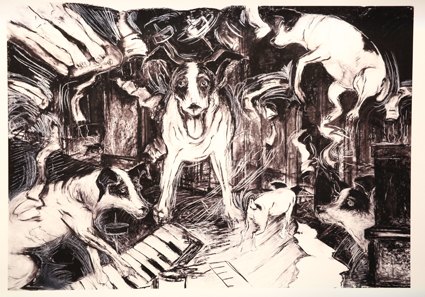
Laurie Anderson, Lolabelle in the Bardo, The Language of Future, Anne & Gordon Samstag Museum of Art
courtesy Adelaide Festival 2013
Laurie Anderson, Lolabelle in the Bardo, The Language of Future, Anne & Gordon Samstag Museum of Art
Lolabelle also makes an appearance in a series of prints taken from large-scale drawings depicting the rat terrier, now deceased, spending 49 days in the Bardo, the place Buddhists believe souls go before they are reborn. The rendering of the dog is cartoon-like yet the images are quite terrifying, full of turbulent motion and dark twisted figures. Lolabelle in the Bardo shows an artist willing to defy expectations and utilise whatever medium suits her project.
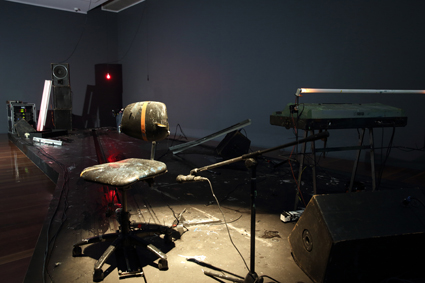
Laurie Anderson, Electric Chair, The Language of Future, Anne & Gordon Samstag Museum of Art
courtesy Adelaide Festival 2013
Laurie Anderson, Electric Chair, The Language of Future, Anne & Gordon Samstag Museum of Art
Similar idiosyncrasy is revealed in the final work, The Electric Chair. An installation from 1977, it was originally presented in a rundown warehouse using whatever was at hand, but now it is recreated in one of Australia’s newer white cubes. The sounds in this piece—the amplified hum and stutter of fluorescent tubes on the blink, the thump and grind of a swivel chair careening up and down a rail—have more rawness and authenticity than the faux paint-spattered floor and distressed electrical equipment. Ironic and playful, Electric Chair adds historical perspective to the survey—even Laurie Anderson started out in a dirty warehouse.
While not a comprehensive retrospective of Anderson’s oeuvre, the selected works in The Language of the Future rustle against each other in a way that highlights her dominant methodologies: multidisciplinarity; multi-dimensionality; the interplay of textual and visual poesy; and the personal as political.
connecting dots
If Language of the Future doesn’t confirm her ‘experimental’ status, Landfall, Anderson’s collaboration with the Kronos Quartet, certainly does. It explores what she describes as the processes of meaning-making by presenting the audience with fast flowing texts and symbols, conflicting audio and visual cues and an overall fragmentation that falls distinctly into the category of, to quote Anderson, “difficult music-c-c-c-c-c-c” (United States of America I-IV,1984).
The music alone doesn’t sound so difficult. Anderson’s electric violin forms a deep, rich bed over which the Kronos Quartet’s acoustic instruments shimmer. Nearly every musical segment is brief comprising beguiling melancholic melodies flavoured by Eastern European harmonies. It’s a music of beginnings with few pieces developing more complex internal structures, reminiscent of film scoring. It makes for a slippery, slightly frustrating experience—you long to hear some of the ideas expanded. It appears to be a deliberate tactic to aurally fragment the experience, just as the texts, spoken and projected, are broken up.
Subject matter is seemingly dissociative. Anderson was completing the commission when Hurricane Sandy hit New York so ideas of immersion flow through the piece. Near the beginning large text scrolls upwards, spaced and paced so that you are left to anticipate (often incorrectly) the next line:
“the city drowns
the city where children
are shot
and women have just
earned the right
to combat.”
At other times she talks of dreams, discussing how tedious it is when people recount them, which is ironic given that Anderson has spent much of her career sharing hers. There are texts about a book of extinct animals that weighs as much as 30 weasels; a job Anderson took to make a hotel lobby “sound bigger;” and a new letter of the alphabet called Olive which has no sound, you just open your mouth and think about it. These ideas weave around each other either spoken by Anderson or projected. The screened text comprises a variety of scrolling orientations, fonts and colours increasingly interrupted by typographic constructions, including warning and information symbols, silhouettes of figures replacing letters, ink splotches or simply missing chunks of words. We read, trying to fill the gaps. As William Burroughs says in “Sharkey’s Night,” “Hey sport. You connect the dots. You pick up the pieces” (Mister Heartbreak, 1984).
Laurie Anderson has always been associated with technological innovation, however in her later work she tends to let technology putter away in the background rather than fetishising it. In Landfall both tactics are employed. The program tells us that the composition is “generated from harmonies and delays” by the Erst software system—this perhaps explains the prevalent incremental build structure of most pieces. There is also interplay between the musicians and the text samples. This generally remains invisible except for one section in which violinist John Sherba breaks formation and solos, centre stage, generating flashes of words with sharp, frenetic bowing. Once again, I wished this had been extended beyond a brief moment of spectacle so that the cause and effect could develop more complexity.
Maybe Landfall is a little too genteel. The fragments themselves—both musical units and stories—are all quite pleasant and neat. A few more extremes and jagged edges, some freefall into utter ambiguity, might raise the stakes and make us work even harder in our role as meaning-makers.
story time
For those dissatisfied by the fragmentary nature of Landfall, the salve was Dirtday!. This is the Anderson we’ve come to expect. Stage and lighting design are stripped back but atmospheric, with small tea-light candles scattered around the floor adding warm shimmer to sharp beams of light. On stage is an armchair and next to it a small projection screen that remains mostly blank showing only shifting colours. While the chair is empty most of the time with Anderson positioned on the other side of the stage, its presence reminds us that this is story time.
After a brief musical introduction Anderson talks about evolution and how Darwin, “a mousey dresser,” was irked by the peacock, a species that allowed the female to make all the decisions. She moves on to the Catholic Church and its fear of multiple universes—what if there were multiple popes? Who would be top dog? And why is our planet called Earth? Why not simply Dirt?
Inevitably Anderson moves on to dreams—she tells us that at 63 she has dreamt for 21 years of her life. Now subjects begin to slip and intertwine: election seasons mix with peacocks, theories on cot death and tent cities, chickens in trees with the “politeness” of Alzheimer patients. Things consolidate again when Anderson finally sits in the armchair and talks about the death of her dog, ruminating on death from the Buddhist perspective: how to feel sadness but not be sad; how death is the release of love. From someone else’s lips all this could seem trite but Anderson’s touch is light and the inclusion of a crappy video of blind Lolabelle playing the keyboard a moment of leavening humour.
In her program notes Anderson discusses how she originally set out to make a music driven piece, utilising software that would render her solo playing symphonic, however the words just kept coming and she decided to go down the path of “musically arranged words that spoke up.” The music here is perfectly balanced, just rising above the background in swelling interludes then sinking back to keep things ticking over. Small details—the shudder of a helicopter, or the shimmer of rain, a dog bark, a pulsing beat—are near subliminal. Over the years Anderson’s use of the vocoder has also changed. Originally her down-pitched voice was used as the “voice of authority” but here she uses it as a more distant version of herself, her dream self. Perhaps she suggests our dream selves are our internal authority; or maybe they should be.
I had a moment of sadness during Dirtday! thinking that perhaps this might be the last time we see Anderson in Australia (given how far away we are from New York). If that is the case, these three projects presented by the Adelaide Festival offered the perfect showcase of the breadth and depth of this inspiring artist who is not afraid to keep doing what she knows she does well, but who also never wearies of the search for new ways to make sense of things.
Adelaide Festival 2013: The Language of the Future—Selected works from 1971-2012, Laurie Anderson, Anne & Gordon Samstag Museum of Art, March 1-April 19; Landfall, Laurie Anderson & The Kronos Quartet, performers Laurie Anderson, violin David Harrington, John Sherba, viola Hank Dutt, cello Jeffrey Ziegler, music and text Laurie Anderson, Erst programming Liubo Borrisov, electronics & software design Konrad Kaczmarek, dramaturg Bob Currie, transcription Jacob Garchik, audio rig Shane Koss, lighting design Brian H Scott, Festival Theatre, March 2; Dirtday!, music, text & visual design Laurie Anderson, lighting Brian H Scott, Dunstan Playhouse, March 3
RealTime issue #114 April-May 2013 pg. 6-7
© Gail Priest; for permission to reproduce apply to realtime@realtimearts.net
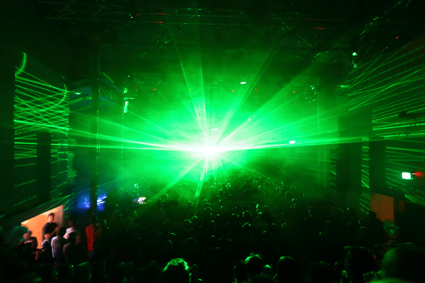
Robin Fox, Unsound
photo Tony Lewis, courtesy Adelaide Festival 2013
Robin Fox, Unsound
THE ADELAIDE FESTIVAL’S MUSICAL PROGRAMMING BROUGHT SIGNIFICANT AND WELCOME CHANGES, FOREGROUNDING CONTEMPORARY MUSICAL GENRES OUTSIDE THE CLASSICAL MOULD, BROADENING THE FESTIVAL’S APPEAL BEYOND ITS TRADITIONAL AUDIENCE AND ILLUMINATING PARALLEL MUSICAL UNIVERSES.
Much of the music was composed or arranged for a blend of acoustic and electronic instrumentation and some solely for electronics, showing how the use of electronics has permeated contemporary composition and how genres cross-fertilise.
kronos quartet and jg thirlwell
The festival introduced Adelaide to the extraordinary and absorbing music of Australian expat JG Thirlwell and his Manorexia septet, whose fluid membership featured Adelaide’s Zephyr string quartet, a percussionist and a pianist together with Thirlwell at the laptop. His Canaries in the Mineshaft opens with vibraphone and piano, the strings entering quietly, and moments of dissonance enrich the flavour. Ice on the Equator is built around a trance-inducing repeated vibraphone figure, the strings floating eerily around it, with a sudden shift into dramatic intensity. Multiple time signatures create a phasing effect that heightens the eeriness of Thirlwell’s music, and he quietly intrudes pre-recorded sounds, for example a distant siren, referencing other auditory realities. This is fine writing, highly musical, with complex rhythms and shifts in mood, that suggests film scores, jazz, musique concrete, contemporary classical and electronic music, and demands quality ensemble playing.
The highlight was Thirwell’s Armadillo Stance, which sounded like an armadillo might dance—slow and seductive with a deliciously enigmatic violin line running through, punctuated by a tiny bell. The CD version uses electronic keyboards for the melodic lines but string harmonics are more complex and engaging even when mediated by a PA. His music is essentially tonal but clever use of dissonance adds complexity, and its power comes from shifts in tempi and intensity, textural contrasts, multiple rhythms and instrumental voicing. Thirlwell’s music suggests a melange of influences, though it’s distinctively original.
The legendary Kronos Quartet, renowned for its innovative use of electronics, pioneering new musical territory and championing composers across all genres, headlined the festival. Following Manorexia, their enthralling set included Bryce Dessner’s Aheym (Yiddish for “homeward”), written for Steve Reich’s 75th birthday, with Dessner joining them on electric guitar; music from Clint Mansell’s soundtrack to the Darren Aranofsky movie The Fountain (2006); electronic music composer and performer Amon Tobin’s Bloodstone, rearranged for string quartet; and Thirlwell’s edgy Eremikophobia (fear of sand). Not exclusively electronic, Kronos also gave us Aleksandra Vrebalov’s arrangement of Wagner’s Prelude to Tristan and Isolde and, for an encore, a delightful arrangement of Swedish Folk Ensemble Triakel’s melancholy love song “Tusen Tankar” (A Thousand Thoughts). Kronos’ set ranged across contemporary classical, movie music, electronic hybrids and high romanticism. Their seamless integration of electronics extends their instrumentation well beyond stringed instruments, opening up all kinds of compositional and performance possibilities.
severed heads
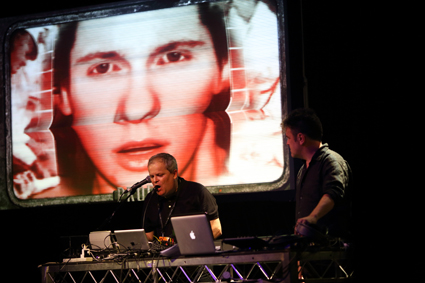
Severed Heads
photo Tony Lewis, courtesy Adelaide Festival 2013
Severed Heads
“Everyone is Beautiful in a Free World (Terms and Conditions apply)”—so goes the title of legendary post-punk/techno/industrial (what do these terms mean?) Australian band Severed Heads’ opening number in the breathtaking concert for which they re-formed—for what they declare is one last time. Their satirical but danceable music portrays a dystopian world of machine-like, futile human life, ruled by unseen (commercial) forces. Their set included the hits “Hot with Fleas,” “Profit,” “Petrol,” “Pilots Hate You (Obama mix)” and “Dead Eyes Opened.” Severed Heads’ 30-year career spans significant technological as well as musical development, and their songs are now remixed using updated technology, resulting in a cleaner, more refined sound, but sometimes recreating the characteristic sounds of old technologies such as slurred tapes. The stunning videos screened with the music are an essential component, and the Queen’s Theatre, recreated as a club-like venue, was the perfect location.
The performance was complemented by a downloadable computer game, core band-member Tom Ellard’s Hauntology House, hosted by the ABC website, which enables you to generate musical and visual material using simulacra of typical compositional devices such as laptops, radios, turntables and tape recorders. Users at home can mimic, in a game setting, what Severed Heads themselves do to create their work. This is a significant development in audience interactivity, but proficiency demands effort.
unsound—solaris
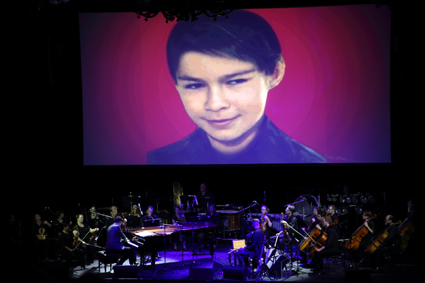
Solaris, Unsound
photo Tony Lewis, courtesy Adelaide Festival 2013
Solaris, Unsound
The Adelaide Festival brought to Australia the Krakow-based Unsound Festival, whose festival-within-a-festival included performances at the Queen’s Theatre and, as its central element, the staging of Ben Frost and Daníel Bjarnason’s co-composition Solaris at Adelaide Town Hall. Unsound commissioned Bjarnason and Frost’s version of Solaris to celebrate in 2011 the 50th anniversary of Polish writer Stanislaw Lem’s novel Solaris (see Gail Priest’s discussion of this work, RT103). Scored for strings, percussion, prepared piano, guitars and electronics, it is performed with Brian Eno and Nick Robertson’s video that uses still images of characters from the 1972 Andrei Tarkovsky film based on Lem’s book and also Pieter Brueghel’s painting, The Hunters in the Snow (1565), which Tarkovsky featured in the film.
The music is slow and hypnotic, opening with an ethereal whisper of strings and with a flavour of ambient electronic music but greater textural complexity. The video is correspondingly dreamy, with imagery materialising out of a haze of pixels. The pixilation seems to metaphorise the sub-atomic structure of matter and the possible neuronal structure of the planet Solaris’ intelligent ocean that induces hallucinations, the music seeming to characterise such neurological processes. Frost and Bjarnason’s Solaris is not a remake of the film or its score but an attempt to capture the psychological essence of Lem’s book. While the central musical work in Tarkovsky’s film is a Bach chorale prelude for organ, theirs is more secular and leaves the listener unsettled, the dissonance suggestive of psychological disturbance or unresolved tension.
Unsound also included three nights of world-class music in the categories of experimental, dub, ambient, drone and their derivatives, with international acts including Demdike Stare (performing with a string ensemble including Zephyr Quartet), Tim Hecker, Actress, Hype Williams, Lustmord, Robin Fox, Pole and again Ben Frost, an unparalleled showcase that demonstrated the depth of musical development in this broad field and its influence on mainstream music.
This use of different rhythmic structures, performance techniques independent of human playing and the greatly expanded sound palette that typifies this kind of music has permeated contemporary composition. Melodic and harmonic structures and linear, thematic development with variations are much less emphasised. Composers draw on the widest range of devices, blending samples, field recordings and pre-recorded sounds with live performance, with both programmed and improvised elements, using looping and phasing, and producing scores for acoustic instrumentation as well as electronics. Frost and Bjarnason, for example, used computer software in developing the Solaris score. The musical product retains its distinctive character even when transcribed, say, for strings or a chamber ensemble. It’s eclectic, mixing tonality with atonality, foregrounding process, using quotation and irony and sometimes making social commentary, and it potentially appeals to a wider audience. And video is commonly part of the composition—the concert is an audio-visual experience that extends the tradition of pop-rock video for TV.
Unfortunately, many of the Adelaide Festival’s musical events lacked a printed program, so you couldn’t always know what was being played or even who was playing unless you were already familiar with the material.
stereopublic

Stereopublic (Crowdsourcing the Quiet), Jason Sweeney
photo Martin Potter
Stereopublic (Crowdsourcing the Quiet), Jason Sweeney
Contrasting with the rest of the Adelaide Festival’s music, Jason Sweeney’s Stereopublic was an absolute delight for its gentleness and its ability to make you think about sound and listen for it. Sweeney guides participants on a walking tour of city sites with particular sonic characteristics—a fountain, an elevator, a park, an office tower foyer, an underground car-park and so on. On commencement, he hands you a business card reading “please be quiet.”
Stereopublic is like a perambulatory version of John Cage’s 4’ 33”—you listen to ambient sound and meditate on the idea of silence—but it takes you beyond Cage’s concept in that you map the city’s quieter locations where you might escape the traffic and other noise, and you learn to listen to buildings and spaces, rediscovering the city sonically.
The Stereopublic interactive webpage invites you to identify quiet places and offers an iPhone app. This is relational art, from which a small community with a new awareness is born, each walking-tour group forming a bond in Trappist monk-like silence. Stereopublic offers a different and welcome kind of musical awareness.
The ABC recorded the Severed Heads concert in full and is hosting Hauntology House. Stereopublic will be in Perth in May and in Sydney in June 2013.
Adelaide Festival, 2013: Kronos Quartet and JG Thirlwell’s Manorexia, Thebarton Theatre, March 4; Severed Heads, Queen’s Theatre, March 13; Unsound Festival, Queen’s Theatre, March 14-16; Solaris, Ben Frost and Daniel Bjarnason with members of Adelaide Symphony Orchestra, Adelaide Town Hall, March 15, Stereopublic, Adelaide, Feb 27-March 17 and at www.stereopublic.net.
RealTime issue #114 April-May 2013 pg. 8
© Chris Reid; for permission to reproduce apply to realtime@realtimearts.net
THE RHYTHMS OF A FESTIVAL IN ADELAIDE ARE LIFE AFFIRMING. FOR SEVERAL WEEKS, THE CITY COMES TO LIFE, INFUSED WITH ENTHUSIASM FOR THE ENERGIES OF ART. BUT THEN IMAGINATIONS, ONCE SO ENLIVENED, BECOME EXHAUSTED. THE VENUES FADE TO BLACK AND SOUNDS TO SILENCE. ‘IN THE MIDST OF LIFE’ WE LIVED IT UP; IN THE FALLOW WEEKS THAT FOLLOW, ‘WE ARE IN DEATH.’
Yet this year, in the midst of celebration, the tragedy of theatre was often felt. Violence, injury and trauma, physical and psychological, and death inflicted upon others in crimes of passion and times of war—these were the tropes of David Sefton’s wide-ranging theatre program, his first as festival director.
the kreutzer sonata
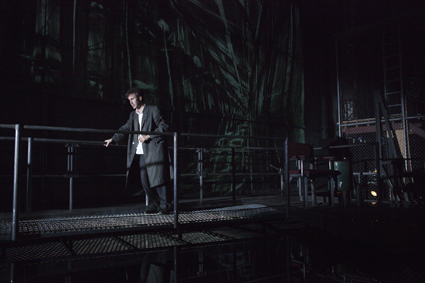
Renato Musolino, Kreutzer Sonata, Scenic Workshop, STCSA
photo Shane Reid, courtesy Adelaide Festival 2013
Renato Musolino, Kreutzer Sonata, Scenic Workshop, STCSA
In some productions, the forces that these tropes unleashed were threatening and chaotic. The Kreutzer Sonata, an ambitious staging of Leo Tolstoy’s novella, directed by Geordie Brookman for the State Theatre Company of South Australia, sought the passion of Beethoven’s music to elevate the artistry of Tolstoy’s tale about a husband’s jealous murder of his wife. Rehearsing the grim misogyny and self-delusion of the narrator from the constructivist depths of the State Theatre’s Scenic Workshop exhausted Barry Otto, who withdrew before opening night. The production forged ahead with Renato Musolino bravely taking on the role. Women in the audience, old enough to be his mother, found moments of release as the actor delivered the invective. Would they have done so if the part were delivered by an actor of their husbands’ or fathers’ generation? Geoff Cobham’s architectural lighting and the hand-etched artistry of Chris Petridis’ video design were majestically expressive. But the production’s rationale was all but broken.
doku rai
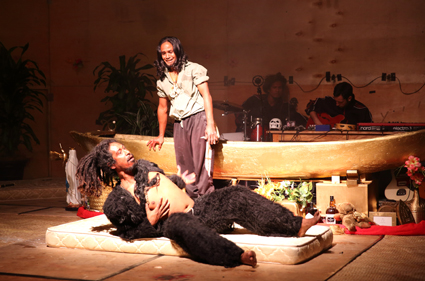
Doku Rai, Black Lung Theatre & Whaling C0mpnay, Liurai Fo’er and Galaxy
photo Tony Lewis, courtesy Adelaide Festival 2013
Doku Rai, Black Lung Theatre & Whaling C0mpnay, Liurai Fo’er and Galaxy
A four-year collaboration between the young men of Liurai Fo’er and Galaxy from Timor-Leste and the Melbourne-based Black Lung Theatre and Whaling Firm shook the gutted shell of the Queen’s Theatre with grubby violence, ritual slaughter and rock music. With the nation’s history of guerilla warfare, the colonial legacy of Catholicism and, now, the charity-capitalism of back-packing opportunists, Doku Rai re-enacts the story of a dead man, who is killed 77 times and never dies. Anarchistic energies, distilled from ritual mateship in a drinking circle, strut out on stage with the rock-star pride of fighting roosters and slash through our contemplation, balls in one hand, machete in the other. The production style is raw, and its surfaces are rough-and-ready. The meanings of its dialogue (much of it sur-titled) are without precedent. The violence stretches empathy to breaking point, way beyond the beneficence of, say, Katherine Thompson’s Mavis Goes to Timor (2002). (Female artists have largely been excluded from the making of Doku Rai.) But neither does the work resolve upon the sacrifice of white-man-journalist-as-hero that drove the film Balibo (2009), from which this collaboration emerged. There are risks in unfolding for an audience a process so unfinished, but the invitation is to witness the clash of collaboration. The provocation is to overcome our disbelief. Although in Doku Rai the killings are documented on video, the work is subtitled: “You, dead man, I don’t believe you.”
kamp
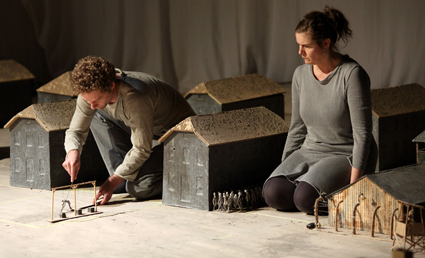
Kamp, Hotel Modern
photo Tony Lewis, courtesy Adelaide Festival 2013
Kamp, Hotel Modern
Two European productions delivered death in more methodical ways. Hotel Modern’s Kamp from the Netherlands is a puppet show in which three performers animate a scale model of a Nazi concentration camp. The model filled the entire floor of the Festival Centre’s Space Theatre. Dormitories are arrayed in a grid formation, with guard towers and sections of barbed wire fencing and a train track that delivers load after load of prisoners. Crowds of tiny puppets in striped pyjamas are processed through the camp. Their clay heads and distorted faces bear silent witness to their terror. Their bodies are given action by the puppeteers; their actions are magnified with live projection from a handheld video camera and amplified with sounds of excruciating realism. The scene is bleak. A prisoner scrapes at the earth, another drags a fallen inmate across the yard. The guards survey the inmates from the tower, beat a fallen prisoner and chase another into an electric fence. The camera takes us inside the building where guards gas the prisoners and burn their bodies in the furnace. In another shot, we fly across a mass grave of the dead to arrive at one who is not dead yet. These up-close shots are so disturbing that the closing image of inmates sleeping in a dormitory is calming in relief. But it is the remote view that persists. Across the model camp, the scale of its operation mutely obliterates an individual capacity to care.
nosferatu
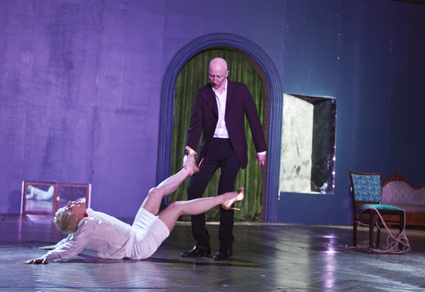
Nosferatu, TR Warszawa, Teatre Narodow
photo Shane Reid, courtesy Adelaide Festival 2013
Nosferatu, TR Warszawa, Teatre Narodow
Nosferatu from Poland’s TR Warszawa and Teatre Narodowy likewise took a methodical approach to reviving Bram Stoker’s ‘myth that will not die.’ On a spacious set with measured speed, Grzegorz Jarzyna directed an ageless cast of characters. Nervous men and languid women animated a series of dramatic tableaux. The production recalled a period when medical science could extend the life of fantasy, when extending life itself was beyond reach. The actors in Nosferatu conveyed feeling with commitment, yet their absorption in their performance removed the drama from our world.
beowulf
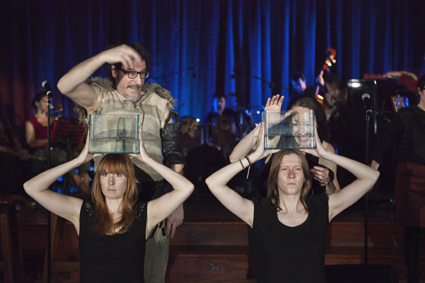
Beowulf—A Thousand Years of Baggage, BBB (Banana Bag & Bodice)
photo Shane Reid, courtesy Adelaide Festival 2013
Beowulf—A Thousand Years of Baggage, BBB (Banana Bag & Bodice)
By contrast, the beer hall at the German Club, with its laminex tables, vinyl chairs and open bar, gave artists from two companies an opportunity to connect. A ‘songplay’ from BBB of the USA, Beowulf revived the Anglo-Saxon battle saga for an audience well equipped to recognise the cartoon-bribery of its satire. The work is testament to Brecht’s legacy in American theatre education. A story with ‘a thousand years of baggage’ makes theatre with a message to unpack. Scholars’ notes intact, two women frame the work ironically in post-feminist critique, so that another two can sex it up with back-up singing and go-go dance-burlesque. An impressive klezmer-fusion band of seven pieces plays on, while the boys play out the battles between Beowulf and the monster Grendel. Their nerdy over-acting is melancholic for warrior rites now lost, and they encourage laughter at the monster-mother’s grief.
the strange undoing of prudencia hart
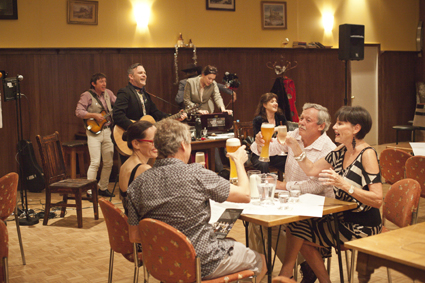
The Strange Undoing of Prudencia Hart, National Theatre of Scotland
photo Shane Reid, courtesy Adelaide Festival 2013
The Strange Undoing of Prudencia Hart, National Theatre of Scotland
The National Theatre of Scotland also drew us into an encounter with mortality at the German Club. They promised “an evening of anarchic theatre” which they delivered, not with mock-ironic violence, but with homespun, hand-made charm. The company of five performers travels light. Each an actor, singer and musician, they play among the audience, under the house lights. They make music without amplifiers and create effects without a lighting desk. The opening scene—a snowstorm flurry created by the audience tossing torn-up paper serviettes—was beautiful, both as an immersion in the performance and as permission to participate. The Strange Undoing of Prudencia Hart is superbly told in song and rhyming couplets, silly and sublime. An earnest folklore academic, snowed in at a conference, spends the evening at the pub where karaoke renditions have supplanted folk traditions, and the manager of the B&B hoards a library underground with every book on Scottish folklore—except Prudencia’s, of course. Her undoing, in the end, is our deliverance, warmly willed with pop songs, football chants and love.
ontroerend goed
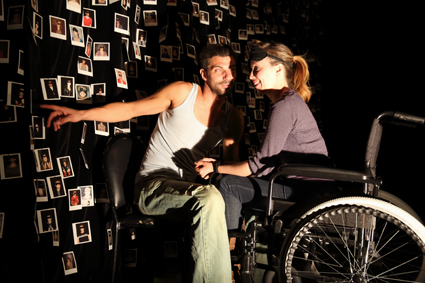
Smile off Your Face, Ontroerend Goed
photo Tony Lewis, courtesy Adelaide Festival 2013
Smile off Your Face, Ontroerend Goed
What passes between us in performance is often the look, the touch, the tragedy of life and love. That was the message hand-delivered by three performances—The Smile Off Your Face / Internal / A Game of You—from the ensemble Ontroerend Goed of Belgium. Strictly speaking, these are experiences rather than performances. They are elaborated in intimate sequences of encounter, processed along assembly lines of affect that progressively reveal their means of propagation. Intense with aspirations for individual revelation, yet designed with care to handle the delusions of self-projection, their performances worked in darkness on reflection, tapped into inner glow, and lived beyond the moment in the after-life of emotion.
Adelaide Festival 2013: The Kreutzer Sonata, by Leo Tolstoy, adaptation Sue Smith, director Geordie Brookman, Scenic Workshop, STCSA, Feb 27-March 17; Doku Rai—You, dead man, I don’t believe you, The Black Lung Theatre and Whaling Firm, Liurai Fo’er and Galaxy, Queen’s Theatre, Feb 28-March 4; Kamp, Hotel Modern, Space Theatre, March 12-17; Nosferatu, director Grzegorz Jarzyna, TR Warszawa and Teatre Narodowy, Dunstan Playhouse, March 14-17; Beowulf—A Thousand Years of Baggage, BBB (Banana Bag & Bodice), German Club, March 11-16; The Strange Undoing of Prudencia Hart, National Theatre of Scotland, German Club, March 1-9; The Smile Off Your Face / Internal / A Game of You, Ontroerend Goed, STCSA Rehearsal Room, Adelaide, Feb 28-March 17
RealTime issue #114 April-May 2013 pg. 10
© Jonathan Bollen; for permission to reproduce apply to realtime@realtimearts.net
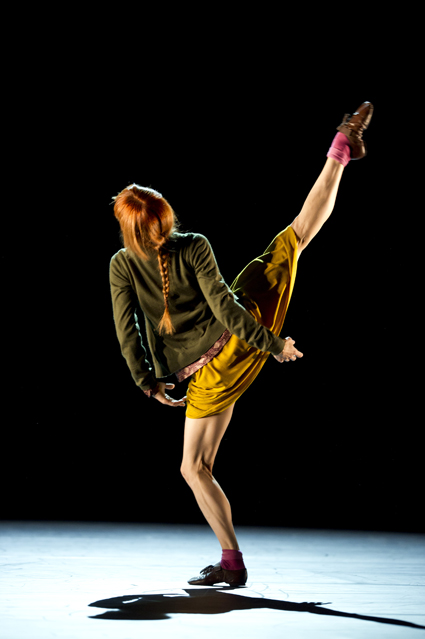
Sylvie Guillem, Bye, 6000 miles away
photo Bill Cooper
Sylvie Guillem, Bye, 6000 miles away
I MANAGED TO CATCH A HANDFUL OF SHOWS AT THE 2012 ADELAIDE FESTIVAL INCLUDING LAURIE ANDERSON’S QUIETLY PROVOCATIVE DIRTDAY! AND SYLVIE GUILLEM’S SUBLIMELY ENGROSSING 6000 MILES AWAY.
Brink’s Thursday, although flawed, impressed in the end, Larissa McGowan’s Skeleton was a favourite and the Australian-Timorese co-production Doku Rai a remarkable cross-cultural experience (enhanced by the brutally tropical conditions provided by the Queen’s Theatre). Each of these works in one way or another unsettled my emotional, cultural and physical centres of gravity.
sylvie guillem, 6000 miles away
In Jiri Kylian’s 27’52” two huge quartz halogen lamps spot the floor: in one a reclining male dancer, in the other a woman emerging from beneath a pale, heavy cloth. They dance in their own worlds until he enters her space, reaches to touch her and is twice repelled as if electrocuted. His hand placed on her head appears to contain her and the pair enter into a series of brisk entwinings, simpatico undulations and balletic lifts. She retires to the cloth; he solos, creating a line across the blue-lit stage on which he alternates fluid and sharply angled moves at a gentle pace, falling to the floor before turning to the woman, lifting her, now like him naked to the waist, into a beautifully sustained contemporary pas de deux. The sense of the two being at one is ruptured when she suddenly runs away from him. He surrenders his chase, lifting and disappearing under a black cloth. She returns to find him gone, runs in the opposite direction and likewise disappears. Wonderfully performed by Vaclav Kunes and Natasa Novotna, 27’52” embodies the Kylian vocabulary but with passages that speak of more recent dance languages while evoking fragile coupledom.
Sylvie Guillem and Massimo Murro execute William Forsythe’s challenging Rearray with apparent ease without ever surrendering its inherent sense of abstract drama in the choreography and David Morrow’s modernist score (piano, strings, feedback). The astonishing lighting (Rachel Shipp), best seen from the dress circle, patterns the floor in subtly shifting lines of ever merging and dissociating lines of metallic blues and greys on which the duo sortie, tangle, embrace and lock in glorious off-centre Forsythian configurations that hold when they should fall. Together and apart Guillem and Murro excel, their realisation of Rearray proof of the power and beauty of Forsythe’s radicalised ballet formalism.
The third work on the program was Matt Ek’s Bye, a dance theatre solo for Guillem which she performs with her own and other virtual selves to a recording of Beethoven’s Piano Sonata 111 played almost jazzily by Ivo Pogorelich. The lighting is again geometrical, a flow of rectangles and circles on which Guillem in girlish demeanour hyperactively bounces, rocks, walks on all fours and jettisons cardy and socks until stalled by the image of a man on a centrestage mirror-like screen. He disappears. She executes a headstand. A dog appears on the screen. Curious, Guillem investigates and finds herself there—but discovers it’s at once her and not her, synced at first and then not. As she mock hip hops, struts flatfooted, shoulders up and then headstands again, a crowd gathers on the screen, likewise curious about her. Cardy and socks on, Guillem merges with new companions. Bye is an odd little parable but as dance, and dance magically engaged with new media, it’s fascinating, revealing a comically characterful Guillem persona and steps we’ve rarely seen from her.
brink & english touring theatre, thursday
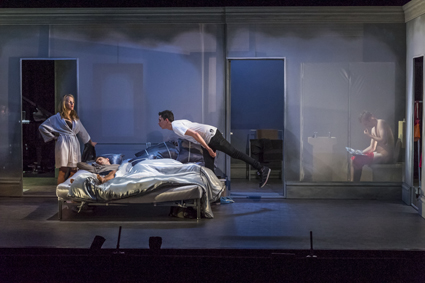
Thursday, Brink Productions and English Touring Theatre
photo Chris Herzfeld, Camlight Productions
Thursday, Brink Productions and English Touring Theatre
Thursday is built on an interesting conceit, transparency—the walls of the set are see-through, characters in different scenarios assemble in the one space simultaneously (as in Benedict Andrews’ account of Patrick White’s The Season at Sarsaparilla) and the inner thoughts of characters are delivered by others (“You’re thinking….”) while standing next to them. The latter was irritating, the audience struggling to get a handle on who’s who in the far too protracted opening of the play where ordinary lives are made transparent—and clearly permeable as relationships play out and overlap. The effect is unfortunately expository and soon overcrowded with supplementary scenarios. That said, once the pedestrian everyday and the horror of the terrorist bombing (London, 2005) are out of the way, Thursday becomes an engaging experience as various synchronicities play out, if sometimes melodramatically, and the characters grapple with profound loss, breakdown and disability.
The sense of a disaster reaching far beyond individual suffering is enhanced by the interplay of a large number of characters and the unfolding of inner lives (if sometimes awkwardly written and structured) within Bryony Lavery’s limits when it comes to psychological insights (as in Stockholm, 2008). There are some loose ends. Having been so firmly established, Paul Blackwell’s conservative Lionel is presumably killed in the blast; it would have been more telling had he lived to grapple with the aftermath. All that aside, Thursday is finally heartfelt and moving, strongly performed with ensemble unanimity by a mixed Australian-British cast and, for such a discursive work, tautly directed by Chris Drummond. Thursday grew on me, but if it is to have further life the extended opening needs to be more cohesively built into the balance of the play.
black lung & whaling firm, liurai fo’er & galaxy, doku rai
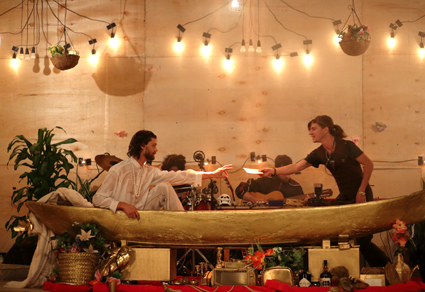
Black Lung & Whaling Firm, Liurai Fo’er & Galaxy, Doku Rai
photo Tony Lewis, courtesy Adelaide Festival 2013
Black Lung & Whaling Firm, Liurai Fo’er & Galaxy, Doku Rai
Briefly, because Jonathan Bollen reviews Doku Rai on page 10, I wanted to add how engrossing this Australian-East Timorese co-production (a tauter re-working of the original; RT111, p38) was, a ritualistic and intensely theatrical account of the dangers of superstition when entangled with power—colonial, tribal and familial. This is raw theatre, rich in barely contained symbolism, music, gruesome comedy and acting rough and subtle. The central crime, the murder of a brother using a deliberate misreading of a prophesy, results in the victim being resurrected and killed over and over again, until the horror and exhaustion of it all for victim and assassin, and audience, is stilled when the actor playing the victim tells us that his family was murdered and that he dies a death every day. All the power of Doku Rai (“dead man I don’t believe you”) distills in this moment, one that haunts me still.
larissa mcgowan, skeleton
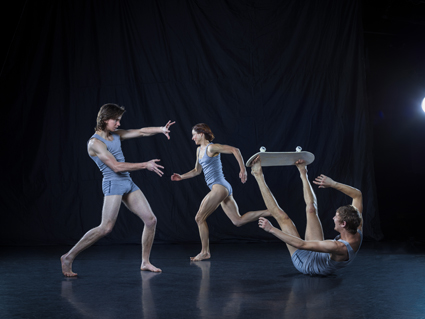
Tobiah Booth-Remmers, Lisa Griffiths, Lewis Rankin, Skeleton
photo Chris Herzfeld, Camlight Productions
Tobiah Booth-Remmers, Lisa Griffiths, Lewis Rankin, Skeleton
Accidents apparently happen in threes. Dancer-choreographer Larissa McGowan’s Skeleton is a dance theatre reverie-cum-nightmare in which the fragility of the human skeleton is subjected to instruments of popular culture (skateboards, bmx bikes, high heels, baseball bats, action films and noise-reducing headphones). Accident scenes are cyclically revisited with increasing intensity. Cultural objects are rendered utterly iconic—chalk white fetishes, as they are in the works of visual artist Ricky Swallow, one of McGowan’s inspirers.
As human scale black boxes-cum-screens automatically crisscross the stage they deposit these items on which we rest our gaze. First we see a skateboard, and then, in another pass, a man frozen in time, tilted forward on the board. Shortly we see him roll out, in slow motion, from a black box in a damaging tumble accompanied by the sound of an almighty crash rising out of Jethro Woodward’s dynamic, pop culture saturated score. With other accidents we sometimes see the damage first: the order of cause and effect is not always obeyed, heightening the sense of obsessive reflection on a traumatic moment.
The images of the man and skateboard are typically punctuated by others in a world where people appear to be ephemeral and replaceable. At worst they relive their accidents. A man (Louis Rankin) wearing large white headphones, is hit violently on three different occasions by a rushing passerby. A woman (Lisa Griffiths), appears, locked in muscle seizure. McGowan lifts her rigid frame and attempts to manipulate her back into shape. Later we’ll see Griffiths with the bike, folding herself, possibly lovingly, into it in various positions, one of which will become this rigor-mortised condition.
Manipulation of the damaged body is a significant motif in Skeleton. After our initial sighting of the writhing McGowan, she shortly reappears being extensively manipulated by a male dancer to sharp electric jabs heard in Woodrow’s score. What first appears helpful becomes threatening, in an extension of the motif, as the male repeatedly, in near slow motion, hits McGowan’s jaw.
This world of gliding black boxes depositing and disappearing humans and objects is scarily fast, but there is a telling, relatively slow and sustained scene that heightens the joint themes of damage and care. To a melancholy strain from Woodrow, Tobiah Booth-Remmers rolls and shapes the rigid Griffiths with increasing aggression, as if irritated by her body’s unresponsiveness. She suddenly softens, grabs his leg; he falters and crumbles. Sitting, she creates a push/pull pieta, drawing him softly into her lap only to repel him and then draw him back.
It’s the final stage of Skeleton where the work—after too many action scenes which emphasise popular culture’s invitations to risk-taking and thrill-seeking—achieves the thematic fruition that McGowan and co-director Sam Haren were doubtless aiming for with the completion of the ‘damage and care’ motif and now an evocation of not just the breaking of bones, but also the smashing of icons. We see the front wheel of the BMX shatter into plaster—this at last is Griffiths’ accident. The skateboard appears, shockingly, to crack of its own accord. The high heeled shoe, so delicately approached and negotiated by McGowan rolling, turning and slipping into it, crumbles beneath her. It’s as if, a la the dromology (the science or ‘logic’ of speed) of Paul Virilio, each of these instruments (they are all technologies—even the bat offers prosthetic reach) incorporates its own accident, damaging itself and its user. Louis Rankin, though, reminds us that the skeleton is likewise a piece of fragile technology as a rush of plaster pieces tumble from his t-shirt. After a final burst of violent energy the dancers, left only with the culture of fight, all fall down.
McGowan’s first major work reveals intelligence, thematic integrity and a potent sense of theatre magic, if at times the desire to amuse risks undercutting Skeleton’s seriousness, expressed most strongly in the ambivalence portrayed concerning our attitude to the pain of others—its meaninglessness in action films, and the tension between concern and denial in reality, yielding even cruelty. The design of Skeleton allows McGowan and her collaborators to replay and review, cut and paste the pleasures and traumas of youth with a three-dimensionality and physical and lo-tech immediacy still beyond the reach of digital media. The Skeleton team have made an analog machine for reflection, albeit one with all the speed and rapid cutting of its digital peers.
See Keith Gallasch’s full review of Skeleton as well as Carl Nilsson-Polias’ response as part of RT’s Dance Massive coverage.
–
Adelaide Festival 2013: Sylvie Guillem, 6000 Miles Away, Festival Theatre, March 1-4; Brink Productions & English Touring Theatre, Thursday, writer Bryony Lavery, director, dramaturg Chris Drummond, designer Dan Potra, Norwood Concert Hall, Feb 20-March 16; Black Lung & Whaling Firm, Liurai Fo’er & Galaxy, Doku Rai, direction, design Thomas M Wright, remount directors Thomas Henning, Melchior Dias Fernandes, Queen’s Theatre, Feb 28-March 4; Skeleton, choreographer Larissa McGowan, directors Sam Haren, Larissa McGowan, AC Arts Main Theatre, Adelaide, March 2-9
RealTime issue #114 April-May 2013 pg. 11
© Keith Gallasch; for permission to reproduce apply to realtime@realtimearts.net
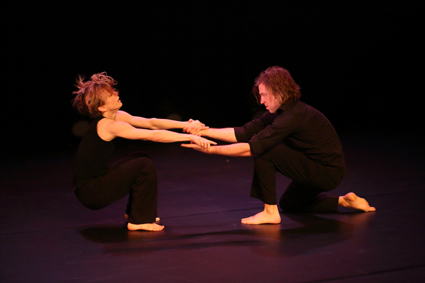
Louise Lecavalier, Patrick Lamothe, Children
photo Tony Lewis, courtesy Adelaide Festival 2013
Louise Lecavalier, Patrick Lamothe, Children
THE 2013 ADELAIDE FESTIVAL’S STRONG DANCE PROGRAM INCLUDED SYLVIE GUILLEM, LOUISE LECAVALIER, WIM VANDEKEYBUS’ ULTIMA VEZ, A FLAMENCO PROGRAM DIRECTED BY CARLOS SAURA AND THE PREMIERE OF A WORK BY EMERGING AUSTRALIAN CHOREO-GRAPHER LARISSA MCGOWAN. ANNE THOMPSON LOOKS AT THREE OF THESE, REFLECTING ON DANCE LANGUAGES, SKILL AND ENDURANCE AND ISSUES OF CULTURAL AND AESTHETIC FRAMING. (SEE P11 FOR RESPONSES TO GUILLEM AND MCGOWAN, EDS.)
louise lecavalier
Louise Lecavalier is formidable at 50—muscular, assured, capable of great nuance and completely at the centre of both works, Children and A Few Minutes of Lock. There is familiar vocabulary from Lecavalier’s time with Édouard Lock’s Canadian company La La Human Steps: the primal high crawl at speed, the decisive manipulation of an object (in this case pillows and a pole), fragments of ballet (fancy foot work, soft arms, stated arabesques), high velocity horizontal and vertical leaps, gestural partner work (expressing both tenderness and violence), forward and rewind, all performed with throw-away casualness.
Children is set against musical tracks that locate the piece in Lecavalier’s era. We move from the likes of Leonard Cohen to Miles Davis to Billie Holliday (to name a few) through to a Puccini climax; all songs of love and longing. Then there is the sound of children playing and later crying. The program note points us to conceive of the dancers (and ourselves) as children with the longings of children. This longing is represented with great irony and control. The impact of the determined and exact physicality in the piece has more to do with an experience of endurance and stamina. There is something poignant in that determination in the face of want.
A Few Minutes of Lock has Lecavalier suspended and moving in relation to two men. Occasionally they break out into moves of their own. There is dainty peripheral fluttering of feet and hands, daring catches, huge propulsion from small impetus. This is not about the simple meaning of weight and momentum. There is showmanship here, flair, even when the movement is again throw-away. Meaning is again produced in the assured relentlessness of the display. The intimate venue allowed us to breathe with Lecavalier, not just watch her convincing puppet-like performance. The music of Iggy Pop was featured in this piece. I remembered La La La Human Steps collaborating with David Bowie. There’s something of the rock star in Lecavalier strutting her stuff and I can’t help but admire her tenacity.
ultima vez
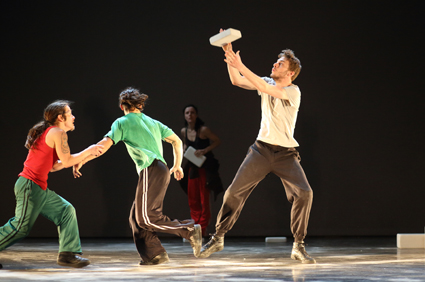
Ultima Vez, What the Body Does Not Remember
photo Tony Lewis, courtesy Adelaide Festival 2013
Ultima Vez, What the Body Does Not Remember
What the Body does not remember is a recreation of the seminal 1987 work. I enjoyed the disjunction between choreographic methods I associate with the late 70s and 80s (task work with objects and sound familiar to me from American postmodern dance) and these strong and varied European bodies (the favoured look of contemporary dancers now). The work is still charged. But when I leave my heart is pounding. I am disquieted by the European sensibility applied to this task work, taking it to an extreme both in duration and in terms of skill and danger. The sporty playfulness evident in American task work and a form like contact improvisation is absent.
Images surface despite the concreteness of the tasks. Lying, ‘sleeping’ bodies react/shift in response to loud noise, a dancer drumming a miked table (later I think of this as a guard and prisoners). Then dancers seek to traverse the space on different sized blocks using them as stepping stones. The game gets increasingly complex and dangerous. The blocks are thrown and caught (near misses occur); complex, precarious structures are built and balanced on, dancers leap and run and change position with each other (the image for me is of children playing in rubble). The skill of the performers is breathtaking.
Then we watch a long sequence of putting on and stealing towels and coats. The benign image of wrapping one’s hair in a towel and having the towel stolen is troubled by the recurring image of putting on a coat only to have it taken from you.
Then the games get gendered. A man tries to touch a woman’s knee; another man tries to touch a woman’s hair. The women stamp to rid themselves of the attention. The pursuit is relentless. This turns into a disturbing game of men feeling women’s bodies while the women stand legs wide, arms stretched out at shoulder level, reminiscent of the posture and action of security checks. The women move to escape and are caught. They return again and again to stand outstretched, available to be searched. The image drifts towards and away from the erotic and the pornographic—my sense of the agency of the women determining my response.
A more innocent game of orientation follows—a man sitting on a laid-down chair changing positions and a woman sitting on a chair standing up mirroring his moves. This evolves into a series of photos with the whole company. Three solos by dancers blowing a feather up and letting it float down allow us to rest in some depiction of innocence.
There are other structures but the finale is a game of one dancer stamping near another who is lying down. The one lying responds by curling and uncurling. As the pace, duration and proximity of the stamping increase so does the danger. The stamping is fierce. There are also solos of stamping apart from the lying bodies. This extended sequence is violent, eloquently violent.
The performers do not use facial expressions to suggest what our attitude might be to what is happening. Meaning is all in the movement. This is performance as finally brutal. We are lured there by the pleasure of watching the performers’ skill at tasks and games.
carlos saura
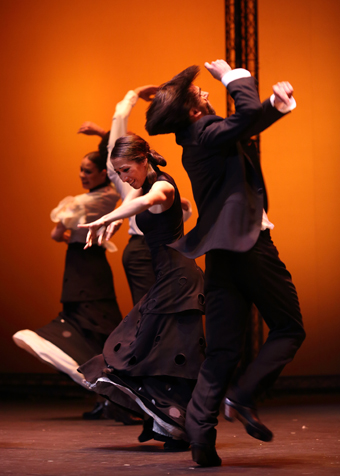
Flamenco Hoy
photo Tony Lewis, courtesy Adelaide Festival 2013
Flamenco Hoy
This was a strange ‘concert’ in the grand Festival Theatre. The evening consisted of discrete items—pieces with the company of dancers, solos created by choreographers Rafael Estévez and Valeriano Paños, guitar solos and accompaniment by Antonio Rey sometimes with other musicians, piano solos and accompaniment by Chano Dominguez and singing by Sandra Carrasco, Blas Córdoba and Israel, sometimes alone and sometimes as accompaniment to dancing. Costumes are changed, screens are moved to delineate space and lights in bold colour illuminate each piece. The entire event is directed by Carlos Saura who so masterfully used flamenco as a theatrical language on film in the 1980s with Bodas de Sangre (Blood Wedding), Carmen and El amor brujo. Here it is hard to discern his hand. I notice that the producer tours rock groups and opera productions. These aesthetic and production values dominate and prevent consistent immersion in the physicality, rhythm and sounds of this form.
The skill of all the artists is exquisite. I find myself relishing the moments which seem improvised. The solos have that feel. I am reminded of tap or hip hop solos, of someone dancing at the peak of their skill level and in response to rhythm and music. The singing has a rawness of tone that is thrilling, close to calling or wailing. The section where a number of solo dancers worked with different solo singers finally drew me in to some space of performance not constrained by the production. The engagement between the singer and dancer was electric and robust like a great jazz duet.
I read in the program that the Flamenco vocabulary used by these choreographers has been modified with jazz and contemporary influences, even ballet. I could sense that. There was an unexpected looseness to the bodies at times, a breaking away from and returning to the strict Flamenco frame. There was also ballet virtuosity. I could hear the influence of 20th century composers such as Bartók in the piano compositions and hints of jazz in the guitar pieces. All of these developments were enticing.
I am not versed in this dance style so I found myself seeking cues as to how to watch any differently than as a tourist, as somehow separate but with investment in the piece delivering something I want; in this case, some drama. The production spoke of cultural trading in a way I rarely see in international festivals these days; the products of a culture delivered in a commercial form but made ‘contemporary’ as befitting an arts festival through incorporation of recognisable cultural influence from some cultural power (in this case, the United States). I am used to trade deals being less visible and thus making the work more comfortable for me to be part of as a member of an ‘educated arts audience.’ This was a timely reminder of what is always at stake even when I choose not to notice.
Adelaide Festival 2013: Louise Lecavalier, Children, choreographer Nigel Charnock, dancers Louise Lecavalier, Patrick Lamothe; A Few Minutes of Lock, choreographer Édouard Lock (excerpts from Salt and 2), dancers Louise Lecavalier, Keir Knight, Patrick Lamoth, Space Theatre, March 6-9; Ultima Vez, What the Body Does Not Remember, direction, choreographer, scenography Wim Vandekeybus, Dunstan Playhouse, March 7-10; Flamenco Hoy, director Carlos Saura; Festival Theatre, Adelaide, March 15, 16
RealTime issue #114 April-May 2013 pg. 12
© Anne Thompson; for permission to reproduce apply to realtime@realtimearts.net
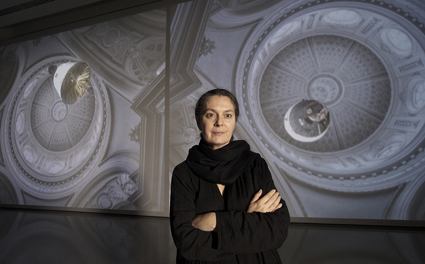
Grazia Toderi with Orbite Rosse (Red Orbits)
photo Toni Wilkinson
Grazia Toderi with Orbite Rosse (Red Orbits)
PERTH AUDIENCES WERE BLESSED WITH THE THEME OF LIGHT FOR THE 2013 EDITION OF THE INTERNATIONAL ARTS FESTIVAL WITH A SPECTRUM OF ILLUMINATION WORKS RANGING FROM PROJECTION TO INSTALLATION.
The array of light manipulations on display took me back to somewhere in the depths of Norway, where underground runs the longest road tunnel in the world, the Lærdal Tunnel. This feat of engineering has a curious surprise embedded in its depths. Just as the driver is slipping into somnolence and fearing having entered a time warp, a dreamy bluish speck appears in the distance. As it grows it is easy to wonder if it is a portal to another dimension and when it swallows you up, twin feelings of wonder and disappointment envelop you. All the immersive delight in the mystery of the light source is dispelled, revealed as a simple effect designed to ease monotony and potential claustrophobia. It does not, after all, indicate the final radiance you might observe before being split into several billion particles and recombined some place alien.
This experience illustrates one of the defining features of light. It has an inherent mystery to it, yet it is also that universally familiar stuff that signals the beginning of a new day and artificially illuminates our nights. It has a remarkable range of qualities, from bright to dull, searing heat to ice cold. Whether we squint at the sun or follow a flitting firefly, light is that elusive electromagnetic radiation that can be a substance of both spectacular intensity and delicate subtlety. This broad potentiality of light was revealed in the Perth Festival.
jim campbell, scattered light
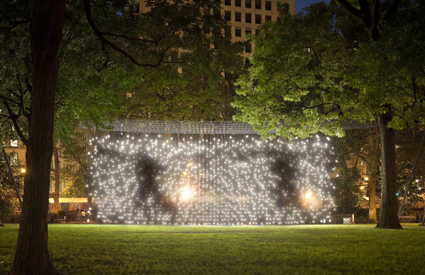
Scattered Light, Jim Campbell
photo James Ewing
Scattered Light, Jim Campbell
American media artist Jim Campbell is a technically innovative tinkerer. For Scattered Light (2010), on display in the Kings Park gardens, Campbell has hung a three dimensional ‘screen’ of over 1,600 light bulbs that presents the viewer with more than first envisaged. Each bulb is carefully engineered with an LED fixture and strategically positioned to be on or off according to a programmed video sequence. A shadowy scene of passers-by in New York’s Grand Central Station crosses the lights. Their bodies are fuzzy close up and defined from a distance, yet each point of observation has its own qualities—whether crisp resolution is desired or the more hypnotic qualities of being confronted by an army of bulbs, with such curious details as the odd bulb seen gently couched in the lush green grass. (See the interview with Jim Campell, RT112, p6.)
luminous flux
Campbell also has a work at the Lawrence Wilson Art Gallery, Motion and Rest #4 (2002), in the group exhibition Luminous Flux. It is a scaled down and simplified version on the same theme, with the added pathos of only limping figures traversing a small screen of LED lights. This exhibition is illuminated by not only LED, but by neon, fluoro, light box, projection and reflection pieces. The installation of the works recalls the logistics of Dome films which are most successful when they take on visually dark topics, like space or underwater. This is because brightness spills over to the other side of the screen and so dulls the overall clarity of the image. It is all too evident in Luminous Flux that spill is occurring and that most of the works would function better in pitch black.
Nonetheless the individual works are mesmeric once you enter within their glow. Rebecca Baumann’s Reflected Glory (2013) splashes onto the walls like effervescence in colour and light. It optimises a simple, low-tech effect of reflection from sundry materials—perspex, wrapping paper and mirror. If this were the sight glimpsed in the middle of a tunnel, it would certainly have one wondering if some raucous clandestine rave were underway.
ross manning, volumes
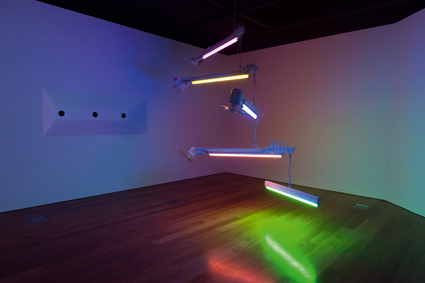
Ross Manning, Volumes, PICA, courtesy of the artist and Milani Gallery, Brisbane
photo Mark Sherwood, courtesy Perth Festival
Ross Manning, Volumes, PICA, courtesy of the artist and Milani Gallery, Brisbane
A similar reflection effect is apparent in the exhibition Volumes, by Australian artist Ross Manning at PICA. For his Dichroic Filter Piece (2012), a projector is used to shine black and white lines through diachronic glass placed on the ground. This, again, results in a spectacular, prismatic spill upon the walls, like the hard-edged version of soft rainbows scattered throughout a room by the sun’s rays passing through a hanging crystal. Manning is renowned for kinetic light installations and his other works in the exhibition combine circular movement, fans, coloured fluoros and ribbon, to create wondrous hanging, spinning and glowing contraptions.
grazia toderi
One of the most impressive exhibitions is by Italian artist Grazia Toderi at the John Curtin Gallery. Toderi is an artist adept at creating spectacular digital projections characterised by monumental scale and compelling ambivalence. They appear other-dimensional and earthly all at once; cities unfold as dense interstellar constellations with the line between earth and sky indistinct. The projections undergo digital manipulation, with light used as a compositional layering tool. For example, in her 2009 Venice Biennale work, Orbite Rosse (Red Orbits), a dual projection displays a nightscape of Turin as two orbs that slowly transform. Terrestrial and celestial mapping appear to converge in a seeming timelessness that unfolds at a carefully measured pace.
srinivas krishna, my name is raj
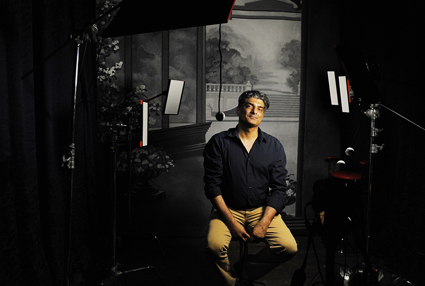
Srinivas Krishna with his work My Name is Raj
photo Toni Wilkinson
Srinivas Krishna with his work My Name is Raj
My Name is Raj by Canadian filmmaker Srinivas Krishna is like a donkey in a field of stallions, petite in stature, quaint and unique. Its oddity in the context of the theme may be attributed to the fact that it is not concerned directly with light, in the literal sense, but more with the idea of fame and the desire to be under the celebrity spotlight. As an interactive installation it plays upon audience narcissism and folds layers of cultural and historical references into one another—the proto-Bollywood films of Raj Kapoor, photographs of Kapoor starring in his own films in heroic and romantic poses, historical photographs of Indians superimposed in scenes of wealth and fantasy and a make-shift camera studio with an Arcadian backdrop. As audience member, you can catch a film and then fulfil your own wish for fame and glory by having a portrait taken and superimposed in a Kapoor film still, which then becomes your own personal keepsake.
When wielded effectively as a sculptural medium, light not only mesmerises, but also has a transcendental effect. I was compelled to drive through that Norwegian tunnel not once but two or three times simply to reach that immersive artificial wonderland that harmonised so sublimely with the natural wonderland of the fiords beyond. The exhibitions in this year’s Perth Festival each hinted at such an experience, where the combinations of light, colour, scale and form collude to take you, if only momentarily, somewhere else.
Perth International Arts Festival, Jim Campbell, Scattered Light, Kings Park; Luminous Flux, Lawrence Wilson Art Gallery; Ross Manning, Volumes, PICA; Grazia Toderi, John Curtin Gallery; Srinivas Krishna, My Name is Raj, Shopfront, Central Institute of Technology; Perth, Feb 8-March 2
RealTime issue #114 April-May 2013 pg. 13
© Laetitia Wilson; for permission to reproduce apply to realtime@realtimearts.net
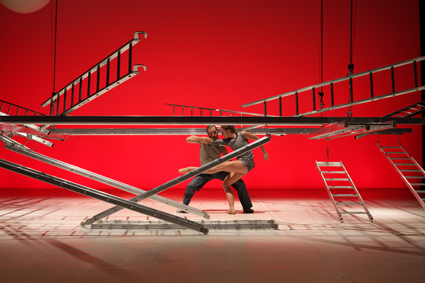
The Truth 25 Times a Second, Ballet National de Marseille
photo Pino Pipitone
The Truth 25 Times a Second, Ballet National de Marseille
IT WAS A CURIOUS, ALMOST DISSOCIATIVE MOMENT I HAD WHILE WATCHING THE PRETTY SPECTACLE THAT IS BALLET NATIONAL DE MARSEILLE’S THE TRUTH 25 TIMES A SECOND. INTO MY HEAD, UNBIDDEN AND UNEXPLAINED, POPPED THE PHRASE “ALL ART IS A LIE.”
Not an original thought, and not a very interesting one, but what most surprised me was that it didn’t seem mine at all. It certainly didn’t seem a poignant response to what was unfolding before me, and it took me a long while to unpack. As best I can understand it, now, it was a part of my mind protesting at the space between what it had been promised and what was subsequently delivered. And that promise was great.
the truth 25 times a second
The Truth is a collaboration between Belgian Frédéric Flamand and China’s Ai Weiwei, whose international renown is today inextricably bound up in his role as a national dissident. The performing ensemble breaks from ballet tradition in being heavily skewed towards male, which opens up much potential in terms of movement dynamics. And there’s the title: any work that invokes the troubled notion of “truth” in such a brazen fashion has some courage indeed.
That title itself is an allusion to Jean-Luc Godard’s famous proclamation that film is truth at 24 frames per second. As in much of the discourse around Ai, Godard was exploring the connection between art and politics, and the ability of the artist to explore the constructed nature of our reality and its connections with various forms of power. Updating the reference by one fps, presumably to incorporate the technology of video and its omnipresent use as a tool of surveillance, is a very suggestive move.
But what we get is some fairly standard live video capturing the onstage performance and beaming it onto a rear drop. There’s some pre-recorded footage of dancers in sterile urban spaces—a bathroom, an empty corridor—and an enlarged image of an eye that occasionally looks out toward the audience. There doesn’t seem to be much ‘truth’ under the microscope here, even in an ironic or negatory form. It’s almost as if the title was chosen because, well, it’s a nice quote.
As with so much of the work, the title seems closer to that notion of ‘truthiness’ [the term promoted by Stephen Colbert. Eds]. Everything has the sheen of meaning but the signifiers wind up unbound, untethered to anything but one another. The work draws inspiration from Italo Calvino’s The Baron in the Trees, another allusion that holds out the promise of Serious Art, but it’s hard to find any response to the novel here apart from a strictly formal one. People climb tree-like structures. Okay.
Ai’s contribution to the project is just as disappointing, but perhaps perfectly in keeping with its logic. The set is almost entirely composed of a series of interlocking ladders, many of which can be disconnected and rearticulated at different points. They form the aforementioned tree, are dragged like heavy wings behind a performer’s back, and at a stretch might draw associations with the frames of a strip of film, if we were dealing with film here instead of video. But after a time it seems that the combinatorial possibilities here are their own end, and we’re simply watching a game of ‘things you can do with ladders.’
The choreography itself is attractive, and again its formal aspects are perfectly admirable. The dancers are of an athletic variety and Flamand makes the most of this—perhaps a local equivalent would be ADT. It would be a satisfying affair if it weren’t for all that promise, which is even further reinforced by the hyperbole of the program notes. But it felt, in the end, as if a better fable to compare it to would be something about emperors and their attire.
duck, death and the tulip
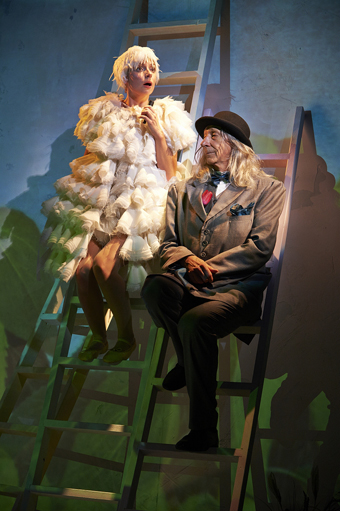
Death and the Tulip, Barking Gecko
photo Jon Green
Death and the Tulip, Barking Gecko
Take the other extreme. A few days later, speaking to a fellow critic about Barking Gecko’s Duck, Death and the Tulip, she exclaimed, “It didn’t lie!” It was a simple yet ideal rebuttal to that odd formulation that was still irritating my thoughts. Barking Gecko’s production doesn’t lie, and it makes for an astonishing piece of children’s theatre.
A duck lives out her days on a lake in quiet, carefree fashion until the handsomely-suited figure of Death arrives and introduces her to the very concept of mortality. He explains the various ways by which she might depart the world, but her infectious playfulness soon wins his affection and he spends the season in her company, holding back the inevitable. And then winter comes and the landscape freezes over, and the Duck dies and sinks beneath the waves.
There’s no lie. There’s no suggestion of an afterlife, no retreat into memory or the sense that the Duck’s death meant anything more than a duck’s death does. Nobody mourns, and death itself is presented for the dumb fact it is. From the faces of the younger children in the audience, this was an encounter that raised questions it refused to answer with comforting platitudes. There must have been some interesting conversations on the way home afterwards.
It’s a lavish production. A full band in white formal wear plays from an elevated spot at the stage’s rear, complete with Jazz Age half-shell footlights. Chris More’s projected backdrop is a subtle, painterly evocation of mountains and fields that shift gently across seasons, while a bathtub filled with rubber balls amply manages to suggest the lake in which much of the action takes place. Ella Hetherington’s Duck is energetic and mischievous and despite being wordless (she communicates through a duck whistle) never crosses into panto mode. As Death, George Shevtsov balances gravitas and dry humour.
None of this works to aestheticise the work’s central subject of mortality, however, to offer art as a soothing balm or fetish with which to keep death at arm’s (or wing’s) length. The final image is of Death returning to his lofty perch at the top of a ladder, surveying the land for the next creature he’ll be paying a visit. And so it goes.
la marea
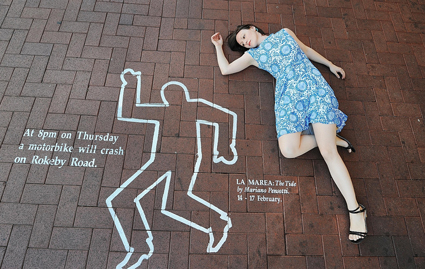
La Marea
photo Toni Wilkinson, courtesy Perth Festival
La Marea
As a celebration of life, there’s much to commend in Mariano Pensotti’s La Marea. Unfortunately it’s a celebration that takes place despite the piece, not just because of it: a length of street is transformed by a wandering audience who stumble upon any of a dozen vignettes played out on balconies, in shop windows and alleyways. There was something of a festival air, as all manner of strollers stopped to discuss the playlets with strangers, to offer conjecture or review. Many had happened upon the event by chance, and their curiosity added a frisson to the atmosphere.
But several logistical problems undermined the course of the evening. All of the scenes involved projected surtitles, as much of the text unfolded in the heads of each character, and in many cases the crowd gathered so close to the words that only 10 or so could read what was going on. For some sequences, sightlines were so narrow that only one or another player was visible to most.
The majority of scenes didn’t make much of their potential, either—given that so many were internal monologues by characters who were essentially static for their duration, thinking over their lives while sipping a drink or waiting for a date to show up, there was little impetus to look at anything but the text, when it was visible. It amounted to a series of short stories being read in public by a large crowd, which seems a let-down given the sheer scale of the event and the operational difficulties it presented. It was a hugely complicated production, but surprisingly lacking in complexity.
watt
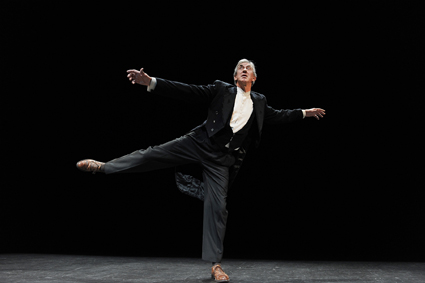
Barry McGovern, Watt
photo Toni Wilkinson, courtesy Perth Festival
Barry McGovern, Watt
The opposite can be said of Gate Theatre’s production of Watt. One performer, Barry McGovern, recites Beckett’s novella on an almost empty stage, floating on the silence between his words. There’s so little to look at that every button, every mote of dust caught in the spotlight, takes on great significance. McGovern’s performance is just as precise, as if a rollicking shaggy dog tale told by a veteran jester in a pub had been repeated so many times, for so many years, that every pause and stop has been honed to perfection.
McGovern brings just enough of the clown in Beckett to get the tone of his writing right; too many take the writer’s works as a cue to deliver heavy-faced existential despair, whereas the seriousness of the work lies in the conditions to which it reacts, not in the actions of his players. His characters may live in a unforgiving universe, but they go on, in their manner.
Watt was the work Beckett gave us before Waiting for Godot, and it’s a fine companion, tracing the story of a man who takes up appointment as some kind of house-aid in a sinister manse whose occupants never clearly manifest. His ascension upstairs and relationship with the master take on a mystical aspect, but allegory is continually undermined by the narrative’s own unreliability and occasionally self-referential nature. In any case, Watt ends his story ejected from the space before discovering his true place within it, and unable to make solid sense of what has become of him. As with Godot, the possibility of existence’s meaninglessness is at all times counterpoised by a terrific abundance of language, which is itself liberated by its inessential nature. It may be a lie, but to lie so well is its own art.
Ballet National de Marseille, The Truth 25 Times a Second, choreography Frédéric Flamand and Ballet National de Marseille dancers, design Ai Weiwei, Heath Ledger Theatre, State Theatre Centre of WA, Feb 8-11; Barking Gecko, Duck, Death and the Tulip, writer Wolf Erlbruch, director John Sheedy, performers George Shevtsov, Ella Hetherington, Subiaco Arts Centre, Feb 8-16; La Marea, creator Mariano Pensotti, Rokeby Road, Subiaco, Feb 14-17; Gate Theatre Dublin, Watt, novel by Samuel Beckett, text selection & performance Barry McGovern, director Tom Creed, Heath Ledger Theatre, State Theatre Centre of WA, Feb 13-17
Representing RealTime, John Bailey was a guest of the Perth International Arts Festival. Illness unfortunately prevented coverage of the Robert Wilson production of The Threepenny Opera for the Berliner Ensemble.
RealTime issue #114 April-May 2013 pg. 14-15
© John Bailey; for permission to reproduce apply to realtime@realtimearts.net

Clouds, Aracaladanza
courtesy Perth Festival
Clouds, Aracaladanza
FOUR PRODUCTIONS, LA CUCHINA DELL’ARTE (BELGIUM), CLOUDS (SPAIN), SHIVA SHAKTI (INDIA) AND 3G (TROIS GENERATIONS) (FROM FRANCE TO PERTH) VIEWED IN THIS YEAR’S FESTIVAL, CAUSE REFLECTION ON THE ANTAGONISTIC RELATIONSHIP BETWEEN ENTERTAINMENT AND ART.
While artfulness abounds in the works under question, all revel, unashamedly, in seducing audiences into their respective worlds of absurdity, illusion, lush dynamism and humanism. Their different performance inflections, nevertheless, speak of vagaries of the human condition, viscerally penetrating thought. La Cuchina’s accident-prone pizzeria is not without its message of a consumerism which, like the pizza dough, is spun out of nourishing usefulness. Awareness of René Magritte’s examination of disproportion probably enhances interpretation of Clouds and familiarity with cultural symbolism might enable viewers to penetrate depths underlying the rhythmic extravaganza of Shiva Shakti and, yet, few would miss the play on reality of the former or the mighty force of gender relations in the latter. The unembellished dancing people, 24 in total, of 3G simply populate the stage with movement and the traceries of tales such gestures weave. There is a subtle dig at elitism with this festival programming which might have affronted the stalwarts of the avant garde but which I found to be ‘entertainment’ with zest and purpose.
la cuchina dell’arte
Circus Rinaldo’s La Cuchina dell’Arte unfolded under a tent in the slow cook of Perth’s mid-summer heat. This ‘small top’ encircled a display of low-tech gags enacted by two skilled performers, a commanding straight-man-chef and his charming, if conniving, waiter who emerges from the darkness with a match or, rather, multiple boxes of matches to light the first candle of the night on a tiny romantic, checked table-clothed table for two. In the fumble of falling light and intermittent utterances, the scene is set, deliciously positioned between surprise and predictability. What follows embraces the anarchy of commedia dell’arte, taking detours into audience participation, stolen sweets and juggled pizza dough whose swirling produced holes in the circular texture to proclaim (gently) the wisdom of failure. Appeal lay in the ability of the brothers to construct an imaginative world from the fundamentals of shallots, brooms, pizza shovels and plate-spinning, matched consummately with their ability to smooth the anxieties of their chosen participants (and the rejected ones) with the absurdity of trying to succeed.
clouds
“Fantasy, imagination and magic,” Aracaladanza’s guiding principles, play lightly in Clouds with the perspectival disjunctions and incongruous logic of Magritte’s imagery. Choreographer, Enrique Cabrera, utilises the imagery of clouds as raw material to be transformed into hand-held balls of fluff or translucent inflatables rolling across the stage. At other moments, clouds become huge bubble-tutus costumed by hidden performers, silly sheep gambolling in and around dancers’ legs or stormy trickeries in an enchanting shadow sequence where dis-embodied hands encase the seemingly diminutive human forms. Green apples appear and disappear, doors leading no-where swallow unsuspecting adventurers and bowler hats, like a Magritte ‘brand,’ head the dancers off to willy-nilly encounters. Object theatre meets contemporary dance in this child-like terrain where decapitated black-suited bodies entertain with snappy jazz routines stomped-flopped by the cast of six tireless dancers. The jokes probe Magritte’s take on the sur-real, the surface non-sense which unhinges inner desire.
shiva shakti
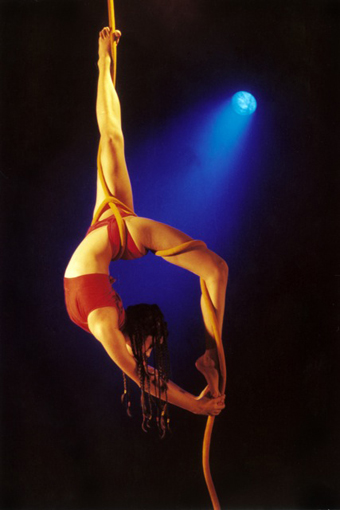
Shiva Shakti, Daksha Seth Dance Company
courtesy Perth Festival
Shiva Shakti, Daksha Seth Dance Company
Throbbing drums herald the spectacle of two cosmological principles, Shiva (masculine) and Shakti (feminine), of the splitting and cohering of male and female rhythms as only Hindu artists can conjure. The percussive presence of the Daksha Seth Dance Company, beaten out with hands, feet and reverberating bodies, harnesses the forces of the ancients by way of Kathak dance, martial arts’ Chhau and yogic traditions of rope and pole to revel in the time-space of Bollywood. Shiva Shakti represents an India here and now, which is simultaneously an erotic Sanskrit past. Some might think the colour, virtuosity and symbolism an excessively sensuous onslaught but the insistent interplay of sound patterns embodied by dancers and musicians alike warms the blood. The slipped polyphonic beat in its intricate and often thrashed concentration on a big drum with rice raining down in a column of red light cannot but both entrance and terrify. This opposition is enhanced by the aerial work with rings, silks, rope and a marvellous fighting sequence on a double harness which brings Crouching Tiger, Hidden Dragon on stage. The gods and their skilled human representations bounce off the earth of our imagining.
3G
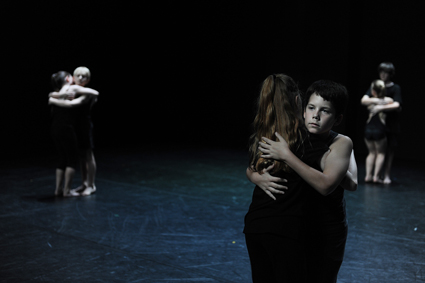
Jean-Claude Gallotta, STRUT dance in association with STEPS Youth Dance Company
photo Christophe Canato
Jean-Claude Gallotta, STRUT dance in association with STEPS Youth Dance Company
Against the thunderous tumult of Shiva Shakti, quietude returns with Jean-Claude Gallotta’s 3G, where dancers across three generations construct, out of their diverse bodily understandings, the same choreographic material. The children ‘do’ the movements with utter seriousness as if demonstrating their proficiency at the alphabet or times table. The eight-some has been drilled to professional accuracy and fulfils those expectations without missing a beat. Context for all sections is shyly suggested in introductory Italian film snippets from the 1930s or 40s. In the generational beginning, a grandma arrives to an over-flowing saucepan of boiling milk, only to transform the moment of disaster for the young boy into an imaginative riverine landscape on the spilt milk’s floor. Ends, through this imaginative device, are tied to beginnings.
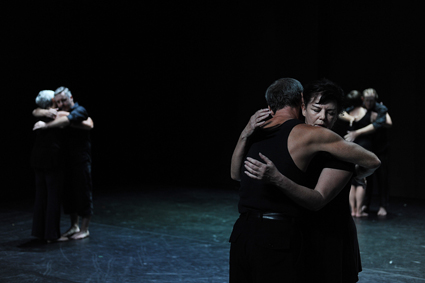
Jean-Claude Gallotta, STRUT dance in association with STEPS Youth Dance Company
photo Christophe Canato
Jean-Claude Gallotta, STRUT dance in association with STEPS Youth Dance Company
Physically, the child generation (performed by members of Steps, WA’s Youth Dance Company) levitate, as if gravity had not touched their small statures and dreams. The adults enter with visceral density which grounds the movement and its sensual/sexual complications. Interactions compound not in a narrative through-line but in glance, luscious gesture and powerful leaps and stamps, communicating a dynamic range of engagement which, with all of its power, still admits limits and emotional anxieties. The third generation, the eldest, bind the work together: curiously they are more and less confined in weightedness. Grace enters into the equation, given through gesture which suits Gallotta’s particularised movement. The film before this segment is a comic rendition of a community who trot into a stream of sunshine in a snow-defined landscape. The image of this generation gravitating to light exemplifies the generational journey. The shaft of sunshine fades and the third generation of dancers begin their enactment. Strangely, via the imagination of this third generation, the dance continues within a landscape built around beginnings in spilt milk.
When the three generations came together in a brief epilogue and final bow, the sense of family and community presented a powerful image, redolent across time and space, of the way in which performance touches the aching mix of dream and actuality to which we all subscribe.
Perth International Arts Festival 2013: Circus Rinaldo, La Cuchina dell’Arte, Russell Square, Northbridge, Feb 9-24; Aracaladanza, Clouds, choreographer Enrique Cabrera, Regal Theatre, Feb 14-17; Daksha Seth Dance Company, Shiva Shakti, choreographer Daksha Seth, director Devissaro, Regal Theatre, Feb 25-28; STRUT with Steps Youth Dance Company and Centre Choregraphique de Grenoble (France), 3G (Trois Générations), choreographer Jean-Claude Gallotta, rehearsal directors: Generation1 Alice Holland, Generation 2 Danielle Michich, Generation 3 Sue Peacock, State Theatre Centre of Western Australia, Studio Underground, Feb 28-March 2
RealTime issue #114 April-May 2013 pg. 16
© Maggi Phillips; for permission to reproduce apply to realtime@realtimearts.net
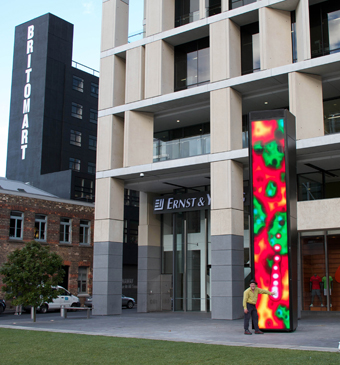
Tim Gruchy with SCOUT
photo Rhana Davenport
Tim Gruchy with SCOUT
AS WORKERS ENJOY A SUNNY LUNCH ON GRASSY TAKUTAI SQUARE, IN THE RECENTLY REDEVELOPED BRITOMART PRECINCT OF DOWNTOWN AUCKLAND, A DARK COLUMN LOOMS ABOVE THEM.
It is eight metres tall and rectangular, similar to the marble block columns of an adjacent building but painted almost black with a matt skin-like finish on three sides. The fourth side has a tinted glass panel, custom-made to create a full-height diffused LED screen that faces into the square, observing the comings and goings of commuters, late morning loafers, weekend market shoppers or after-dark malingerers. Behind the glass, a mix of gaseous, liquid and geometric forms drifts across and up the column, accompanied by soft pulsing music. The colours and sounds change in hue, form and dynamics across the day, and from season to season, as if absorbing the environment and responding with their own interpretation; an electronic world projected behind the glass.
This is Tim Gruchy’s SCOUT (Sentient Co-relator of Urban Transaction), a public sculpture privately commissioned as part of Cooper & Co’s redevelopment of an area that combines Auckland’s main rail station with new high-rise corporate accommodation, shopping and restaurant-bars set in historic former port buildings. SCOUT was developed in collaboration with Sydney architects Johnson Pilton Walker (JPW), designers of the adjacent tower, and was launched in early 2012. Its ever-changing soundscapes were developed with musician-artist James Pinker (ex-Fetus Productions/SPK/Dead Can Dance) and features several vocalists, including Precious Clark from local iwi (Maori tribe) Ngati Whatua, whose performance greets the dawn. Well-known technician and weather boffin Richard Huntington has contributed to the sophisticated back-end, which is activated by camera, microphone, clock and calendar events or climate sensors (humidity, brightness, temperature, rainfall), all of which feed three networked computers that drive the audio and graphics in real time—there is no pre-recorded video.
SCOUT’s primary relationships, however, are with humans. Its camera detects motion in the square, its microphone responds to sound, and the lower portion of the glass has touchscreen functionality, allowing people to interact directly through gesture, releasing an additional range of sound and light events into the virtual space inside. But, existing as an entirely self-contained artificial entity rather than as a tool or extension for the human body, SCOUT is no cyborg. Although the slight twist and skin-like surface of its ‘spiny’ exoskeleton gives it subtle anthropomorphic qualities, it is not humanoid, but designed to be a benevolent presence that shares the landscape with us.
This could be the most technically complex public artwork in New Zealand, unrivalled in its advanced mix of electronics, interdisciplinary collaboration and advanced materials. It seems this unique mix of engineering, programming and art has its unlikely roots in the can-do DIY ethic instilled in the post-punk generation of art school-educated musicians as they attempted to reboot music’s excesses in the midst of an increasingly technological era. For some, this was a license for avant-garde experimentation, where the likes of John Cage, Terry Riley, Brian Eno, Kraftwerk or Talking Heads were equally likely influences, establishing a space that sits somewhere between art, music, theatre and technology.
Tim Gruchy started out in the Brisbane punk scene in the late 1970s. The subsequent industrial movement of the early 1980s (including groups like Severed Heads, SPK and Fetus Productions) was quick to absorb technological developments to make multimedia a core element of their shows, paving the way for media-saturated raves, interactive dance and hi-tech theatre presentations. Gruchy’s career grew in the midst of these developments. Like many media artists of his generation, he either built his own equipment or had to adapt consumer gear as it became available, inventing outcomes in lieu of any existing precedent, and customising new formats as they became available. This makes him Australia’s go-to person for cutting edge video projects, working anywhere from Chinese art galleries to the Sydney Opera House, although he has so far maintained a low profile in New Zealand, where he has been living since 2006.
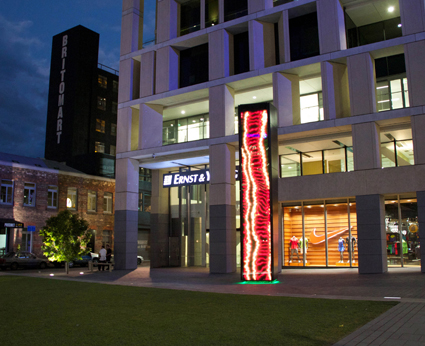
Tim Gruchy, SCOUT
photo Tim Gruchy
Tim Gruchy, SCOUT
Eno seems an obvious reference point, with his well-known interest in electronic ambient music as a way to ‘tint’ an environment, and his slow-change semi-abstract video paintings, notably in vertical format, starting with the oversaturated cityscapes of Mistaken Memories of Mediaeval Manhattan (1981). Gruchy acknowledges Eno as an important early influence but it is Eno’s approach to serial composition that is most relevant here—using chance, algorithms and generative strategies to create almost endlessly variable music and installations from interacting components, most recently his 77 Million Paintings project and his series of iPad apps, Bloom, Trope and Scape (2012). Underpinning these is an interest in ecology and the kind of events and time-scales that defy typically short-term human thinking. The Eno-supported Long Now Foundation is working on a 10,000 year clock that ticks only once a year. Similarly, SCOUT’s climate controls and seasonal variations suggest a structure that extends well beyond the duration of evening concerts or short-loop screensavers, making it more akin to the planetary and temporal sensitivies of land art, such as Nancy Holt’s Sun Tunnels (1973-76) or James Turrell’s Roden Crater (2006). Like Eno’s art-school origins, Gruchy’s early architectural studies have suggested different ways to construct enduring systems rather than to compose music of finite duration. Architecture works on a much larger scale than most art forms, not just physically but temporally too, ideally with a long view of how it impacts on its environment.
Compared to most inanimate public art, SCOUT is also unique in the way it evolves as a form of smart sculpture. Not only can its existing algorithms learn and adapt from the patterns and conditions of its location, it also exists as a form of hardware that could accommodate ongoing software updates—I’m told the existing installation has features that haven’t yet been activated. This makes SCOUT an intelligent presence in the urban environment, co-existing and communicating, but for whom? Another clear reference is the monolith in the film 2001 A Space Odyssey, adapted from Arthur C Clarke’s short story, The Sentinel (1948)—Gruchy shares a birthday with sci-fi writers Clarke and Philip K Dick. SCOUT’s dynamic behavioural qualities raise questions of sentience and artificial intelligence. Although SCOUT is unlikely to be communicating with extra-terrestrials, it’s possible that it may have something interesting to say to our future selves.
Tim Gruchy, SCOUT, 2012, LED video display, LED strip light, touch screen, speakers, microphone, video camera, environmental sensors, networked computers, audio and media servers, generative computer programme in glass, compressed fibreboard and steel shell. Takutai Square, Britomart Precinct, Auckland, NZ; www.grup.tv
RealTime issue #114 April-May 2013 pg. 17
© Andrew Clifford; for permission to reproduce apply to realtime@realtimearts.net
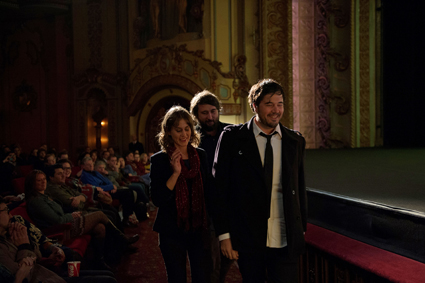
Julius Avery, Jessica Mitchell, Michael Spiccia, winners of the Dendy Award for Best Live Action Short for Yardbird, 2012 Sydney Film Awards
photo Fiona Lumsdaine
Julius Avery, Jessica Mitchell, Michael Spiccia, winners of the Dendy Award for Best Live Action Short for Yardbird, 2012 Sydney Film Awards
HAVING ATTENDED THE EVENT AND WATCHED THE TELECAST, I FELT QUITE DISSATISFIED WITH THIS YEAR’S AUSTRALIAN ACADEMY OF CINEMA AND TELEVISION ARTS (AACTA) AWARDS, THE MAJOR EVENT FOR THE AUSTRALIAN SCREEN INDUSTRY. ANTICIPATING THAT THE OSCARS WOULD ALSO BE AN UNDERWHELMING EXPERIENCE, I STARTED THINKING ABOUT WHAT WAS WRONG WITH AWARDS GENERALLY, AND WHAT MIGHT BE DONE TO RESCUE THEM.
Because there is certainly something wrong; people still attend them, or watch them on TV, but there are more and more complaints, ranging from issues with the host or hosts or about the presentation to more serious concerns to do with the actual awards.
new times, new media, old categories
In the time running up to each event and in much of the feedback, questions are asked and suggestions made as to what is wrong and what can be done, but none of this seems to register with those in control. The big questions are, do awards still have a role? In this digital age, especially, with so many changes to screen production, distribution and delivery systems, aren’t there large and growing areas of work that are being ignored? Aren’t the selection processes and judging systems now quite questionable, as the parameters of eligibility and the criteria for comparison are thrown open by such changes?
It would certainly appear that the old categories are not really working anymore. For the AACTAs in particular, the huge range of categories, many seeming quite indulgent, unnecessary or just inaccurate, only makes for an overburdened event—and for an electorate equally overburdened by out of date criteria. So I wanted to write something that investigated these issues, looked at the AACTAs and the Oscars, and even worried about the future of the new kid on the block, the APSAs (Asia Pacific Screen Awards).
demise of the if awards
Events, as they often do, intervened. The demise of the IF Awards was announced; that fun and rather irreverent award celebration, produced by IF magazine, which went into hiatus last year, will now not return. With audience-based voting and close ties to the screen industry, these awards, from their inception in 1999, had become a strong alternative to the AFIs, but financial constraints have brought them to an end (although the IF Awards Group is still considering a much less formal celebration). Then, less than two years after a major overhaul of the AFIs and a big launch for the new game in town, and only weeks after the second Awards had been held, it was announced that the AACTAs were in serious financial trouble.
the aacta crisis
The team which had developed the first and second AACTA Awards had suddenly been halved in size, with six staff positions going, and AFI/AACTA CEO Damian Trewhella admitted that the organisation was in the red, with the loss of a naming rights sponsor for the 2013 AACTA Awards causing serious and urgent financial difficulties. With much of the income coming from sponsors and advertisers in the non-screen sector focused on the glamorous awards, the industry and craft categories—such as television direction, documentary, editing, sound, production design and short films, only supported by about 15% of the operating costs—are under serious threat. With outside sponsors not wanting to fund the industry awards, and the industry so far unable to provide the money, Trewhella says, “The only way forward is to have the activities re-evaluated by the screen sector itself.”
Trewhella thinks that it probably is time to rationalise the awards, to perhaps roll a few categories together. And while he sees sense in the suggestion made by a number of commentators to hold the film and television awards separately, he says that the AFI is not in a position to have two entirely separate events. He’s looking forward to discussions across the industry, with the state and federal funding bodies, the guilds and organisations and with the filmmakers themselves; after all, he says, the awards are there to celebrate the people working in the industry.
The Australian Academy of Cinema and Television Arts was established in August 2011 by the Australian Film Institute, the general membership-based organisation that had been conducting the AFI Awards to recognise screen excellence for over 50 years. This followed a year-long review and industry consultation; the inaugural AACTA Awards were held in Sydney in January 2012 and the second in January 2013. At the AACTA launch in 2011, the new academy was described as a peak peer assembly for leading Australian screen practitioners, made up of 15 chapters covering key facets of the screen industry, from acting, directing and screenwriting to production and distribution, each headed by an industry luminary in an honorary post, with AACTA itself governed by an honorary council which would develop policy, aimed at “creating greater unity among screen professionals.” It’s unclear, however, how much input this academy is having into addressing AACTA’s problems.
The screen industry’s eight guilds and unions want to support the awards; each organisation is preparing recommendations and they’ll come together to work out a joint submission with the sort of changes they want to see and suggestions to solve the many issues they have with existing awards. (The need for the international awards, for example, is universally queried.) Kingston Anderson, Chief Executive of the Australian Directors Guild, asks what the awards are supposed to do, and answers, “celebrate our industry. But what we want is a fair system where people are recognised fairly in their categories—and that the categories themselves are fair.” He adds that the Guilds’ own awards work well, and “that’s because we’re driven by our members. We all have extraordinarily interesting discussions on guidelines and awards.”
With all the guilds and unions holding their own awards annually, there is a suggestion of more co-operation, of an awards season with the specific awards held before the AACTAs, as a build-up to the main event. There are concerns, too, that the marketing of the awards dictates a number of decisions, seen as too driven by the needs of the telecast. “They’re coming from the wrong end,” argues Anderson, “Let’s get the event right first, and then market it. Even if it’s screening on a cable channel, it’ll become desirable once it’s really working.”
On March 19 the AFI/AACTA announced four new AFI board members, Geoff Brown, Russell Howcroft, Alaric McAusland and Ian Sutherland, all industry heavy hitters, who will join existing members Mike Baard, Jennifer Huby, Robert Sessions and Sigrid Thornton, with Alan Finney as chair, restoring the AFI Board to its full capacity (and earning a quip from one media commentator that the AFI now has more board members than staff). This beefed-up board should give it some more bargaining power in the trying times ahead.
the asia pacific screen awards
The Asia Pacific Screen Awards, which had been rumoured to be in trouble along with other cultural activities in Queensland following the change of government, are apparently safe. Des Power, Chair of APSA, is feeling very positive; he’s just had some very encouraging talks with the Queensland Government and believes that they want to continue with APSA.
These awards were established in 2008 to recognise and promote the cinematic excellence and cultural diversity of the vast Asia Pacific region with an annual awards ceremony each November. They’ve slowly but surely established a role and an identity for themselves; it would be a shame to see them disappear after all that hard work. Awards are decided following a complex and rigorous nomination and judging process, taking in hundreds of films from the many and diverse countries involved. An APSA Academy was established in 2008, with an influential alumni of filmmakers growing by around 100 each year. Development funding is now provided to the region’s filmmakers, aiming to stimulate collaboration. Eight films are now at various stages of production.
Des Power, who was behind APSA from the beginning, says that “it’s been a very difficult year for the government, financially, and we want to give them a bit of latitude, use a bit of common sense.” As he explains, it was always envisaged that once the awards were firmly established, they would be held every second year in Brisbane, and in one of the member countries in the alternate year. “We’ve had some very healthy discussions about this, and we’re hoping to be able to announce that this year APSA will take place in one of several cities in the region.” He adds that the move from the Gold Coast to Brisbane last year was very successful, and he’s hopeful that more screening opportunities for APSA’s nominated films will present themselves in future, not only at the Brisbane International Film Festival, but with other festivals and events around Australia.
a model past its use-by date?
Late last year, as the movie award season got under way, Andrew L Urban in his online journal Urban Cinephile argued that “the use-by date for film awards has arrived.” Mainly talking about the Oscars, but with remarks that could also be applied to the AACTAs, he complained about “outdated and old world restrictions” and “creaky and inadequate” categories, arguing that “there really is no rational way to argue that 282 films made in 2012 can be assessed for a single Best Picture award, nor that there is only one contribution in all the other categories that deserves the ‘Best’ stamp.” He added, “So far, no awards body has managed to find an effective alternative system to the template: the nominees & winner formula remains cast in concrete.”
He also suggested that “in a more sophisticated world where people with vision and imagination manage such things, there may be a system that recognises and encourages excellence without demanding that there be one ‘winner,’ a few also-rans and hundreds of ‘losers’…one way to overcome some of the major limitations and strictures of old awards systems might be to discard the old nomination/winners construct and instead to recognise ‘Outstanding Achievement’ in the various award categories…(giving) equal value to all the work that has been peer-judged as outstanding…it elevates the accolade for each and avoids having to compare apples with oranges.”
Some kind of radical overhaul of the system is definitely needed. The constant criticism, both here and overseas, allied with disappointing audience numbers, would certainly indicate that we don’t need this bloated, out-of-date and very expensive monster. A solution is needed that addresses all the issues, canvasses alternatives and hopefully comes up with something new, different and genuinely fresh and exciting; something that does away with the current categories and looks at what awards are actually for. The Sydney Prize, given out at the Sydney Film Festival’s relatively new competition, goes to the film that best satisfies a very specific set of criteria, including innovation—why not then work towards a number of awards, each with its own criteria? We’re looking to compare very different work and practices, and there are all sorts of ways in which this could be done, but we need to start! The situation that AACTA finds itself in should provide a perfect impetus to do something a lot more radical than just fiddle around at the edges.
RealTime issue #114 April-May 2013 pg. 18
© Tina Kaufman; for permission to reproduce apply to realtime@realtimearts.net
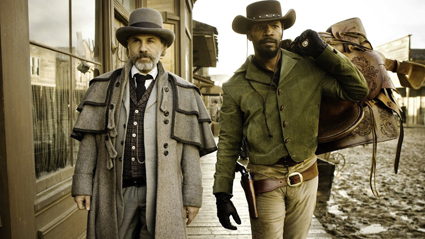
Christoph Waltz, Jamie Foxx, Django Unchained, Quentin Tarantino
AMID THE THOUSAND AND ONE LAZY ASSUMPTIONS ON HOW POSTMODERN CINEMA IS PRESUMED TO WORK IN THE FILMS OF QUENTIN TARANTINO, IT HAS BECOME DIFFICULT TO DIVINE HOW HIS ‘JUKEBOX CINEMA’ AUDIOVISION FUNCTIONS, AND TO DISCERN HOW HIS SONG AND SCORE SELECTION REFLECTS A POLITICISED MUSICOLOGY.
Tarantino’s authorial conceit and post-authorial recontextualisation of cinematic predecessors is only of conservative relevance to cinema, for his heightened audiovision constitutes a cinematic textuality that is cannily true to a medium born of narrative pulping, stylistic regurgitating and generic melding.
Yet as celebrated as he is for colliding pop songs with filmed action, that very effect has become terrifyingly rationalised in the hands of so many wannabe-outré directors (and producers). Tarantino meanwhile has forged ahead and refined the technique through a mode of perceptual crafting nominally excluded from discussion of postmodern art making.
Django Unchained (2012) marks a high in song selection, narrative recontextualisation and musicological territorialisation with alpine clarity. More importantly, it does so through operations seemingly opposed to the insular textuality of postmodern construction (allusions, appropriations, quotations, de-historicisation etc), and in their place broadly evidences trans-historical networking and even globalised positioning. If the film were simply a new post-PC revision of slave lore and suppressed American history, it would be ingrained in the vein of universalist ore mined by Hollywood cinema, something like a hip mash-up of Michael Cimino’s notorious big budget Zionist Western Heaven’s Gate (1980) and George Englund’s lesser-known low budget messianic Rock Western Zachariah (1971). But a crucial rustling of the filmic fabric is evident in Tarantino’s choosing a slew of Ennio Morricone music cues from other films. This audiovisual tactic does not simply point outward to the world of Pop Music, but rather draws inward the sono-musical phenomenality of recorded songs and cues to create a fertile grounding for the visualised action.
The 60s Spaghetti Western genre—a gloriously impure mutation that has fuelled the Western since its classical demise at the close of the 50s—is renowned for its transmutation of mythic narrative frameworks into visceral operas of violence. Ennio Morricone was the pre-eminent composer who if not defining the genre’s sound, refined it into an archetypal sonography, for evermore branding the movies with the twang of an electric Telecaster and dissonant wailing strings, both drenched in distinctive studio reverb from the era. Yet that description ignores the cultural project of these films and their deliberated soundtracks. In their debunking of the John Ford heroics of Hollywood’s ‘new world’ frontier ethics championed by the films’ collective pioneering spirit, the Italian Westerns embodied a critique of post-war Americanism before it had gained traction as a target of superpower rhetoric by the end of the convulsing 60s. It’s curiously perplexing that the Spaghetti Westerns were regarded by conservative critics and aesthetes as being vulgar, derivative and bombastic, for these Italian revisions of US folkloric history chose mostly to side with forces usually annulled by Hollywood scripts—namely, brutal revenge and retribution sought by Mexican revolutionaries and native Indian war tribes. Surveying the bulk of Morricone’s Western scores, one can audit his musicological allusions to those musical cultures, amplifying them through orchestrations of Italo-Catholic pomp and veneration.
So when Tarantino chooses these tracks, he is—with his voracious knowledge of these mutated generic film histories—working from a specific set of generic blue-prints, other than what might be ordinarily presumed. While the title theme to Django Unchained is the theme song to Sergio Corbuccio’s Django (1966), composed by Luis Bacalov, a number of other cues appear throughout Django Unchained from Morricone’s score to Two Mules For Sister Sarah (1970). Added to this are some distinctive Morricone excerpts from the political thriller Violent City (1970), plus a cue from Riz Ortolani’s title theme from I giorni dell’ira (1967). Along with still more excerpts, the musical fabric of Django Unchained’s score cross-patches songs and cues which sonographically evoke a distinctive Italian aesthetic of scoring terse drama and emotional exhaustion which sounds a universe away from the Austro-Germanic academic tradition which saturates the Continental aspirations of Hollywood’s grand orchestrations. Of course, Martin Scorsese is renowned for historicising his Italo-American crime sagas with songs reflecting the sensibilities of his characters, but Tarantino—of Italo-American descent himself—enacts a more complex tactic by eschewing song (already overused as a device for character assignation in movies post-Scorsese) for Italian film scores originally designed to convey a culturally coded mode of address and commentary which gave the Italian Western its identity.
Now this would all be straightforward enough if Tarantino was just making a rebooted Western, but Django Unchained reboots—or unchains—something that has lain for decades festering in the American Gothic of the South: the slave saga. Americans mostly avoided it until the mid-70s, when films like Richard Fleischer’s Mandingo (1975) and the TV mini-series Roots (1977) were made; slavery was mostly handled symbolically in prison dramas like Stuart Rosenberg’s Cool Hand Luke (1967). Again, it was the Italians who were first off the mark with amazingly violent ‘exploitation’ flicks associated with this sub-genre (the Italians themselves knowing a bit about slavery from their days of Roman glory). Historical movies like Goodbye Uncle Tom (1971) actually overlapped with contemporary American depictions of violence in the Blaxploitation cycle of movies (some of which were Westerns, notably Fred Williamson’s Boss Nigger, 1973). Both generic trends held a lot in common: racial violence, white oppression, black power and fantastic film scores and songs more associated with Pop Music than the film industry.
Perceived this way, Django Unchained becomes a carnival of echoes, bouncing references back and forth between Electric Italy and Black America. Echoic balladeering, Latino flutes and ocarinas, wild fuzzed guitars, Bach-like string fugues and funky booming drum kits perform a dance of stylistic fusion to beget not simply an eclectic mix-tape of cool retro tracks, but a concise mapping of the way pop and folk music at the time provided a transcultural system of signage that allowed these populist films—so derided by critics because of their polyglotic noise—a far sharper prism of politicised refraction than many presumed possible.
Tarantino’s Django Unchained thus audio-visually births a gangster rap visitation of the slave pic as produced by leftist Italian radicals, and blasts it into the auditorium of Hollywood’s white Western museography, whose Old Testament Hebrew tales of heroic land-securement are scored by megalomaniacal Germanic orchestrations. In this melting pot of global currents and murky waters we hear yet another example of Tarantino looking at cinema and calling a spade a spade: the very thing that falls on so many deaf ears.
–
RealTime issue #114 April-May 2013 pg. 20
© Philip Brophy; for permission to reproduce apply to realtime@realtimearts.net
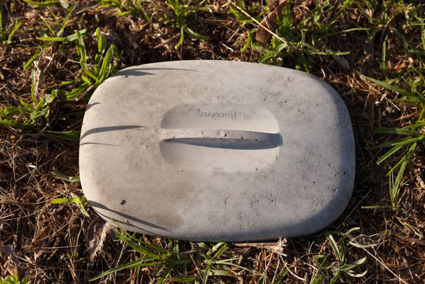
Connie Anthes, Untitled (98 vacancies) (2013)
photo Brett East
Connie Anthes, Untitled (98 vacancies) (2013)
BIENNALES, ART FESTIVALS, ART FAIRS AND ART MONTHS ARE CONSTANTLY PRESENTED TO US AS CONTEXTUAL FRAMEWORKS FOR CONTEMPORARY ART CONSUMPTION. THESE DIVERSE CULTURAL EVENTS, MOSTLY LARGE IN SCALE AND CONCEPTUALLY AMBITIOUS, SERVE TO CONGLOMERATE OUR ART-GOING EXPERIENCES.
Cementa 13, a new kid on the conglomerate block, took on-board this experimental premise with a critical tongue-in-cheek approach. We have all heard of Documenta and Monumenta and now, in Australia anyway, we have Cementa. And here lies the key. Unlike the others, Cementa is firmly located within a social and site-specific context that debunks the white-cube-washing of contemporary art.
Presented by Kandos Projects under the directorship of Ann Finnegan, Georgina Pollard and Alex Wisser, Cementa’s exhibiting artists were invited to undertake residencies in the town of Kandos to develop their works. This residency model resulted in a range of works that not only connected site-specifically, but also with the community and the town’s distinctive character. Works were presented over four days in disused community buildings, empty shopfronts, people’s backyards, on the streets and even the local golf club.
Kandos, over 200 km northwest of Sydney, was certainly not on my regional road-trip radar until I heard the chatter about Cementa at arts gatherings around Sydney. Spurred on by the word-of-mouth build-up as well as the large and impressive list of participating artists I committed to a three-day stay for Cementa.
memorials
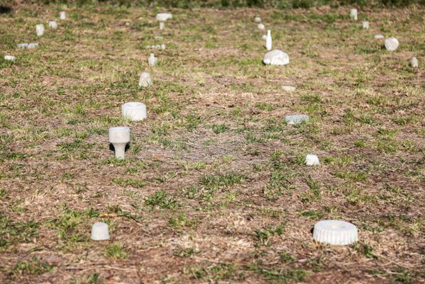
Connie Anthes, Untitled (98 vacancies) (2013)
photo Brett East
Connie Anthes, Untitled (98 vacancies) (2013)
Heading straight out for a walk around town led me to Connie Anthes’ work Untitled (98 vacancies) (2013). In late 2011, Kandos’ main industry—the local cement works and limestone quarry—was decommissioned, inevitably impacting on local economies and the community’s social fabric. In an attempt to memorialise this change, Anthes collected a range of discarded domestic objects from the local tip. Everyday useful items, seemingly no longer needed, were rescued and re-cast in cement. Placed outdoors on the ground of a vacant lot, the meticulous grid of familiar objects became less familiar, disguised by the sameness of their new grey concrete appearance. Like miniature monoliths in the grass, Anthes’ objects invited us to question the everyday effect of industrial change in a rural town.
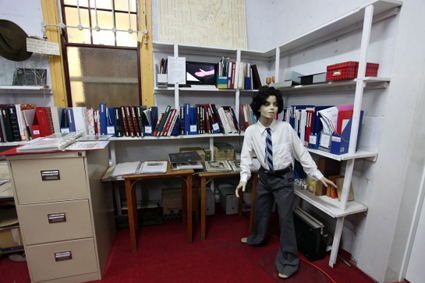
Fiona Davies, Cane (2012)
photo Fiona Davies
Fiona Davies, Cane (2012)
Another work boldly entered the emotionally charged realm of memorialisation within a community context. In her video work Cane (2012), Fiona Davies asked Kandos locals to reflect on school punishment. With the video frame tightly focused on each person’s palm as they recounted punishment by cane in conversation with the artist, we see the hand open, not waiting for punishment but as a marker of memory. Placed beautifully in the Kandos Museum (an Instagrammers heaven), the work sits well amongst a bountiful archive of Kandos’ history. The responses from the participants to their canings range from ‘deserved’ to ‘resented’ and the work brings to light what is mostly amiss in such museological spaces—the personal voice informing the collection’s significance.
intercessions
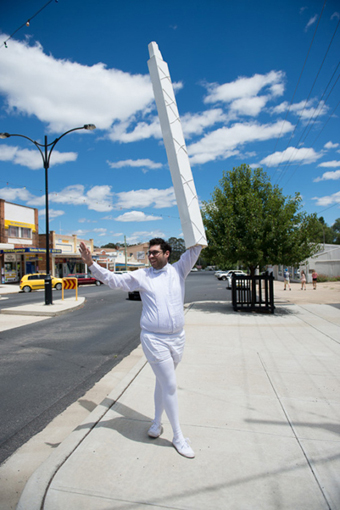
David Capra, Intercessions, Kandos (2013)
photo Alex Wisser
David Capra, Intercessions, Kandos (2013)
Heard loud and clear as he shimmied down the streets of Kandos, artist David Capra continued his investigations into live intercessory performance. Dressed head-to-toe in white, Capra’s outfit intentionally evoked the holy as well as the ubiquitous white of exhibition walls. With an untrained operatic voice and moves that are certainly not trending in contemporary dance studios, Capra’s performance of speaking-in-tongues, banner-waving and dancing became a conduit for intuitive intercession. Unrehearsed and unable to be replicated, his absurd performances on the streets of Kandos were unique experiences of undefined communication and spirit.
During his Kandos residency, Capra was also asked by the Cementa directors to paint the Cementamobile—a handy white van used to cart artists and objects around town. Avoiding a well-trodden path to painterly over-statement, Capra denied the van canvas its loud voice. With sparse, minute motifs on the van—banners, hands shaking and his dachshund Teena—Capra’s van mural was an extremely restrained work. From a distance, the work was indistinguishable. Up close, the motifs came to life in charged patterns Memphis style, an aesthetic born of 1980s post-modernist rejection. Not so coincidentally, the van had a practical role to play in Capra’s performances around town.
serenades
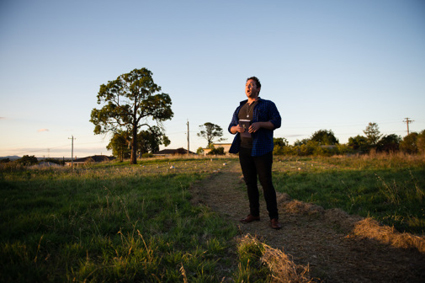
Liam Benson, Cementa (2013)
photo Alex Wisser
Liam Benson, Cementa (2013)
From Hobart Hughes to Sarah Goffman, Cigdem Aydemir and Liam Benson, it was not hard to catch live performance in Kandos. Self-confessed contemporary art romantic, Liam Benson’s daily sunset and sunrise serenades were emotional homages to the Kandos landscape and community. During his residency, Benson developed an affection for the local Glossy Black Cockatoos. Indigenous to the area and with a haven nearby at the Wollomi National Park, the cockatoos are very visible Kandos locals.
Over the four days of Cementa, inspired by the cockatoo’s forlorn call, Benson continued his investigations into masculinity and Australian identity by performing songs of longing and love across Kandos. Singing alone and a capella, each performance’s location unannounced, Benson’s strong rock-infused vocals could be heard emerging from the uniquely Australian local landscape. A sunset performance outside the main pub lured art-goers and locals who followed Benson singing and walking against the backdrop of the dipping sun. As darkness encroached we listened to his rendition of Fleetwood Mac’s “The Chain,” a song about love gone wrong; “Listen to the wind blow, down come the night, running in the shadows, damn your love, damn your lies.”
When not drawing a crowd, Benson sang to Kandos, to an escarpment, a lake, a lone shiftworker in hi-vis clothing, a sleepy campsite and, underlining the ephemerality of performance, to the Glossy Black Cockatoos.
burn-outs
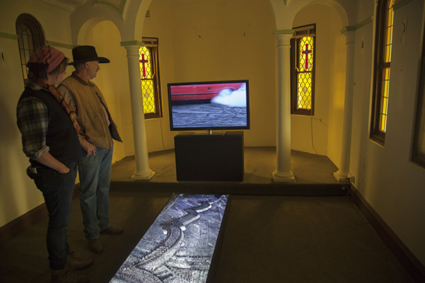
Josephine Starrs, Leon Cmielewski, Chapel of Rubber (2013)
photo Josephine Starrs
Josephine Starrs, Leon Cmielewski, Chapel of Rubber (2013)
Performances of a different kind were the subject of Chapel of Rubber (2013) by Josephine Starrs and Leon Cmielewski. Poetically placed in the now disused chapel at the Kandos Presbytery, the work documented a significant date on the local calendar, the annual Kandos Street Machine and Hot Rod Show. Incongruous with the quiet beauty of the town, this popular but also controversial event is characterised by excessive noise, burn-outs and fluoro cars.
Starrs and Cmielewski’s screen-based work, framed by the intimate architecture of the small chapel, directed our eyes not to the cars, but to the ground—to the spinning tyres and burning rubber. Shot at low-level and in slow-mo, the creeping movement of rising smoke travelled across the screen, at times revealing heavy deposits of burnt rubber on the ground, layered markings of excess, of thrill and of the town’s people and visitors letting go a little. In a town undergoing post-industrial transformation, Chapel of Rubber redefined the strongly symbolic chapel space, maintaining its sense of worship and reverence by channelling hedonistic thrill-seeking action.
There is no doubt there was a lot to conceptually consume at Cementa. At the same time, the incidental social atmosphere—constantly bumping into Sydney-siders and locals while walking along the main drag or grabbing a coffee at the Railway café—meant that Cementa was enjoyably easy to consume. As a conglomerate art experience, the event inhabited the nooks and crannies of Kandos, injecting contextual soul into contemporary art and making it part of the everyday in a rural town. Here’s hoping Cementa 2015 comes around quickly, so we can all get on-board the contemporary art road trip to Kandos.
Cementa 13, directors Ann Finnegan, Georgina Pollard, Alex Wisser; Kandos NSW, Feb 1-4, for participating artists and some great documentation see cementa13.com/
This article first appeared as part of RT’s online e-dition April 3, 2013
RealTime issue #114 April-May 2013 pg. 55
© Sophia Kouyoumdjian; for permission to reproduce apply to realtime@realtimearts.net
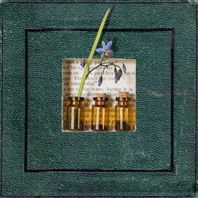 self-release
self-release
zephyrquartet.com
This music CD is accompanied by a booklet of poems, the music and the poetry each carrying equal weight in the resulting artistic product. Developed collaboratively over some years, the music is a collection of compositions that were either written in response to certain poems or to which poets responded with poems. The compositions are by Zephyr members, and some of Australia’s most prominent poets are featured, as well as Mexican-American author Gary Soto (http://www.garysoto.com/). The CD demonstrates how music and poetry can stimulate the creation of the other.
The CD opens with Zephyr violinist Belinda Gehlert’s serene “Ewens Ponds,” which was the inspiration behind Adelaide poet and writer Rob Walker’s poem “Reflecting.” Walker’s brief work suggests both senses of the word ‘reflect’—the mirror image and the thoughtful response. Beginning wistfully, the music develops a stepping rhythm based on repeated statements and is embellished in its voicing and sonority as it progresses. The music triggers a quietly reflective, as in thoughtful, state of mind, finally circling back to the opening theme.
The anthology also includes Walker’s poem “Taisho Pond and Mt Takedake, Japanese Alps,” describing a volcano reflected in a nearby pond whose surface is so still the reflection appears more real than the reality, a comment on human subjectivity. But the pond is silting up—beauty is transient.
The CD title, A Rain from the Shadows, is a line from Australia-based Iraqi journalist and teacher Yahia Al-Samawy’s beautiful poem “Four Loaves from the Heart’s Oven,” whose third stanza is thus:
3.
I built in my imagination
A minaret
And a playground with swings
And I embroidered the deserts
With fountains that played in orange groves
And when I fell asleep at the window of my prayers
I saw my tent was an orchard
And I a cloud that poured down onto the wild wastes
A rain from the shadows
Al-Samawy’s collaboration with Zephyr elicited two compositions by Zephyr cellist Hilary Kleinig. Kleinig’s music, as with much of that on the CD, opens with a simple statement that builds in complexity through restatement, elaborate voicing and variations. Typically, Zephyr compositions are carefully measured, texturally lush and firmly tonal. Though accessible, they do not lack charm or appeal, the engaging tunes lingering in the mind. Zephyr has established its own unique and special genre of string quartet music.
Assembled through an interactive process rather than around a connecting theme, this diverse anthology comprises poetry of depth and power. Prize-winning poet and children’s author Gary Soto’s “The Space” inspired Kleinig’s work of the same name, which is slow, restrained and poignant. Prolific Australian playwright Finegan Kruckemeyer was prompted to write “Because My Dreams” on hearing violinist Emily Tulloch’s “Skyroads” and Nicki Bloom wrote “Draggers” in response to Tulloch’s “Air,” which includes whistling. The steady rhythm of Belinda Gehlert’s “Dirt” is taken up in the ABC’s Poetica presenter Mike Ladd’s haunting evocation of a long distance road trip on the Plenty Highway in Central Australia, a “battered, holy ground” of immense cultural significance (Dirt, Mike Ladd). And Gehlert’s “Shearwaters,” inspired by another Rob Walker poem, evokes birds slowly swooping at sunset, momentarily hinting at Vaughan Williams’ “Lark Ascending.” The music that is inspired by the poems is not intended to be programmatic. The poetry and music complement each other, rather than trying to meld. Listener-readers can approach the material as they wish.
The recording is beautifully mixed and produced. I was at CD launch at the Wheatsheaf Hotel, Adelaide, one of Zephyr’s regular venues. Strings usually don’t sound as good amplified through a PA, especially on a hot night with the air-conditioning running, but the large audience was enchanted. Barbara Coddington’s design for the CD cover is itself an artwork, suggesting a well-worn book, painted over and full of personal history, adding another dimension to the CD’s concept.
Zephyr has always been concerned with accessibility to wider audiences and theirs typically range beyond the traditional classical music audience. Renowned for its exploratory collaborations, Zephyr often works with visual artists and writers as well as musicians and composers in all genres and this CD represents a significant artistic development for the ensemble.
Chris Reid
Excerpt from Yahia Al-Samawy’s “Four Loaves from the Heart’s Oven” reproduced with permission of Zephyr Quartet.
giveaway
We have 3 copies of A Rain from the Shadows to give away courtesy of Zephyr Quartet.
Email onlinegiveaways@realtimearts.net with your name, address and a rain from the shadows in the subject line.
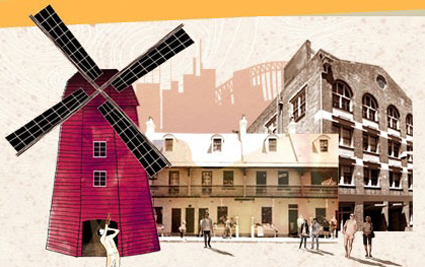 DOWN AT THE ROCKS PRECINCT THE CULTURAL SCHEMERS AT THE SYDNEY HARBOUR FORESHORE AUTHORITY ARE NOT AFRAID TO DREAM BIG.
DOWN AT THE ROCKS PRECINCT THE CULTURAL SCHEMERS AT THE SYDNEY HARBOUR FORESHORE AUTHORITY ARE NOT AFRAID TO DREAM BIG.
In 2009 they presented Fire Water by Michael Cohen and Joey Ruigrok van der Werven—a ship moored in the harbour that caught alight and sank every night for the duration of its performance season (see RT90). So maybe it’s not at all surprising that the same team have now decided to build a four-storey windmill!
The Rocks Windmill is again the brainchild of van der Werven, this time working with interdisciplinary artist Paul Gazzola. The structure will actually operate as a functioning mill with visitors invited to collect a bag of wheat and grind their own flour. The structure pays homage to the first theatre of the colony, set up by former convict Robert Sidaway, who allowed audience members to pay for entry with flour.
The windmill with also be a creative hub for a range of activities exploring both local history and contemporary issues. Windmill Live will see the structure become home to a variety of performance events including the Bell Shakespeare Company performing excerpts from Henry IV (the first work performed in the colony); a creative development showing by My Darling Patricia; an evening of Rocks themed stories by a Newtown writers group, Penguin Plays Rough; film screenings and secret music events.
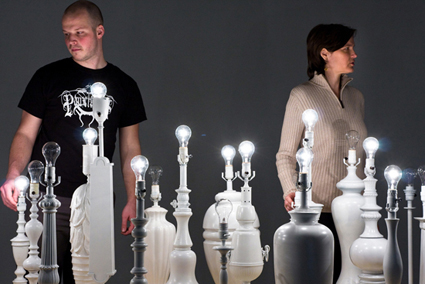
Tiffany Holmes, Dark Sky, ElectriCITY Sparks Community Eco-Viz , Carbon Arts And Media Lab Melbourne
Inside these Walls is the exhibition program. On one floor will be ElectriCITY Sparks Community Eco-Viz Exhibition which will display “world-leading projects and proposals for electricity visualisation in public space” (website), produced by Carbon Arts and Media Lab Melbourne. A surround sound installation by radio producer Jane Ulman will develop over time, incorporating sounds from all the activities within the building. The Tilting at Windmills project by Tessa Zettel and Jennifer Hamilton will explore our relationship, real and fictional, with weather. A series of talks is bundled under the Windmill Whispers program while Grist to the Mill offers a range of hands-on activities including naturalist Diego Bonetto’s popular Foraging the City weed workshops.
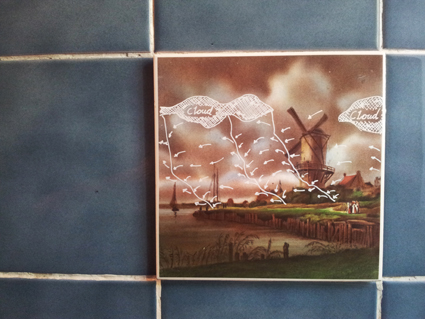
Tilting at Windmills, Tessa Zettel and Jennifer Hamilton
courtesy of the artists
Tilting at Windmills, Tessa Zettel and Jennifer Hamilton
Compared with the razzmatazz of Vivid and the touristic vibe of the area, the Rocks Windmill Project is particularly impressive as its programming focuses on grass roots ideas and issues with an emphasis on participatory engagement between artists, audiences and the local residential community.
The last windmill to dominate the Sydney skyline was demolished in 1878. Although temporary, it seems the 2013 windmill will be an important addition to both the physical and cultural landscape of Sydney, connecting its past with its future.
Sydney Harbour Foreshore Authority: The Rocks Windmill, key artists Paul Gazzola and Joey Ruigrok van der Werven, April 12-May 12; http://www.therocks.com/sydney-Things_To_Do-The_Rocks_Windmill.htm
RealTime issue #113 Feb-March 2013 pg. web
© RealTime ; for permission to reproduce apply to realtime@realtimearts.net
exist conference, brisbane
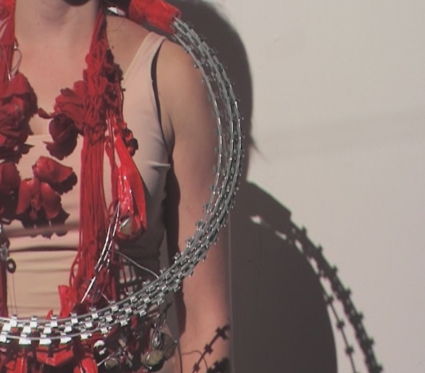
a study in red weight, Rebecca Cunningham, Exist-ence 2010
video still Nicola Morton
a study in red weight, Rebecca Cunningham, Exist-ence 2010
The inaugural exist conference will take place June 26-27 at the Queensland College of Art. Co-directors Rebecca Clunn and Nicola Morton are calling for proposals for papers and presentations which address the theme of Performance, the Body and Time in the 21st century. Topics could include mediatised and digital performance, durational practice, globalisation and gender in mass-media culture and more.
Abstracts are due April 8, www.existenceperformanceart.wordpress.com
next wave 2014
The theme of 2014 Next Wave Festival is New Grand Narratives and applications to participate are now open. Eight to 10 new works will receive artistic and production assistance and “brokerage into funding contexts” (press release) for their premieres at the festival in Melbourne in May 2014. The focus is on emerging artists and there are specific partnerships: Aphids will support a regional artist and John Butler’s The Seed will support a large scale work in public space.
Applications close April 17; http://nextwave.org.au/applications/
cultivate, force majeure
Cultivate is a dance theatre lab presented in association with Performance Space and Carriageworks. The 2014 lab is led by Force Majeure director Kate Champion and Associate Director Byron Perry and will take place from July 15-August 2. Applications are now invited from choreographers, directors, dancers and physical performers/actors who might wish to participate.
Deadline April 30; http://forcemajeure.com.au/creative-professional-development/cultivate/
abr voiceless fellowship
The Australian Book Review is seeking expressions of interest for a fellowship sponsored by the animal protection organisation Voiceless. The successful applicant will be commissioned to write a 7,000-8,000 word article on animal protection issues for $5,000. For the fiction writers the Elizabeth Jolly Short Story prize is also open for entries offering a $5,000 prize.
Applications for both close May 31, https://www.australianbookreview.com.au/programs/abr-patrons-fellowship
nka arts residencies, ghana
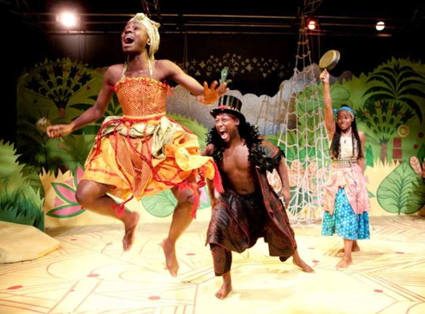
Anansi: An African Fairy Tale by Lisa Cagnacci – Southwark Playhouse
photo Donald Cooper
Anansi: An African Fairy Tale by Lisa Cagnacci – Southwark Playhouse
The Nka Foundation is based in Ghana and focuses on “human capital development through use of the arts” (website) by running a range of workshops, laboratories and residencies. Currently Nka is accepting applications for residencies of one to nine months in their artist village at Abetenim in the Ejisu-Juaben district, Ashanti region of Ghana. Artists working in theatre, film, music, visual arts and multidisciplinary are eligible.
E-mail to info@nkafoundation.org; http://www.nkafoundation.org
leisa shelton workshop, judith wright centre
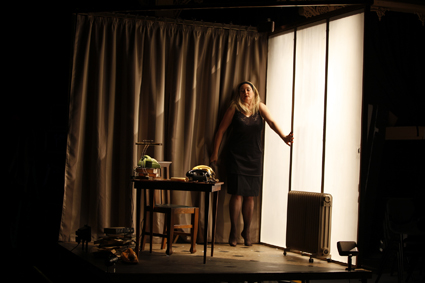
Leisa Shelton, Irony is Not Enough: Essay on My Life as Catherine Deneuve, Fragment31
photo Ponch Hawkes
Leisa Shelton, Irony is Not Enough: Essay on My Life as Catherine Deneuve, Fragment31
Performance maker Leisa Shelton will be running a one-day workshop in Responsive Performance Practice for Brisbane-based practitioners (see RT101). The technique draws on “actor training developed by Etienne Decroux, the rehearsal processes of Pina Bausch via Meryl Tankard, and Autonomous Actor training as developed by Lindy Davies alongside a continuing dialogue with Eastern principles of theatre practice” (website).
Judith Wright Centre, $60 (capacity is limited), April 20, 10am – 4pm; http://judithwrightcentre.com/event/leisa_shelton_workshop
still in the loop
Vitalstatistix: Adhocracy
Deadline April 12
http://vitalstatistixtheatrecompany.blogspot.com.au/
ISEA Conference June 11-13
Earlybird registrations close April 19
http://www.isea2013.org/events/conference/
Gasworks Circus Showdown
Deadline March 18; showdown May 15-18
www.gasworks.org.au
Dimanche Rouge Festival, Tallinn, Estonia
Applications close May 1
www.dimancherouge.org/dimanche-rouge-estonia
Sydney Fringe
Registrations close May 10
http://2013.sydneyfringe.com
Artspace Montreal residency
Applications due April 19
www.artspace.org.au/residency_international.php
Artspace Sydney residency
Applications close Friday 3 May 3, 2013
www.artspace.org.au/about_news.php?i=20130225189240
selected australia council grant deadlines
(for full list seewww.australiacouncil.gov.au/grants)
Theatre: Community Engagement Residency April 12
Theatre: Remount Fund for Independent Artists April 12
Visual Arts: Fellowships April 15
Visual Arts: New Work – Early Career April 15
Visual Arts: New Work – Mid-Career April 17
Visual Arts: New Work – Established April 17
International Performing Arts Markets (IPAMS) Travel Fund April 26
Music: International Pathways – Round 3 May 6
Music: Program May 6
Literature: Digital & New Media May 15
RealTime issue #113 Feb-March 2013 pg. web
© RealTime ; for permission to reproduce apply to realtime@realtimearts.net
There’s a lot of epic art out there: a metropolis of music, rooms filled with bodies, shopping malls sprouting monuments, big pictures, big game and shifting histories. We suggest you keep notes.
metropolis new music festival, melbourne
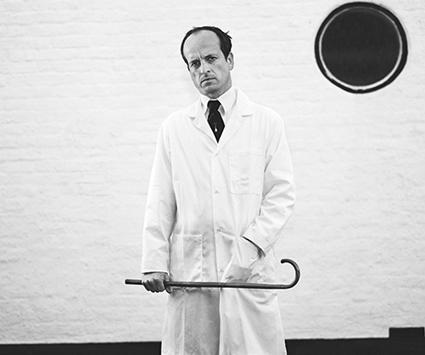
Matthew Herbert, playing as part of Metropolis
Melbourne’s Metropolis Festival has expanded its metaphorical city limits this year with some very adventurous programming. For those firmly in the contemporary classical corner there’s visiting UK composer, pianist and conductor Thomas Adès. There are also concerts featuring DJ/composer Matthew Herbert (UK) and electronic ambient composer Mira Calix (UK). Australia’s Ensemble Offspring, Speak Percussion and Syzygy will perform as well as The Wild (featuring Erik Griswold), presenting a curious re-imagining of The Cure’s “Pornography.”
Metropolis New Music Festival, Melbourne Symphony Orchestra & Melbourne Recital Centre, April 8-20; http://www.metropolisfestival.com.au/
13 rooms, kaldor art projects #27
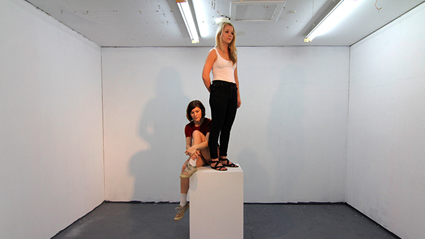
Clark Beaumont, Co-existing, Kaldor Public Art Project #27: 13 Rooms
courtesy the artists
Clark Beaumont, Co-existing, Kaldor Public Art Project #27: 13 Rooms
Surely no-one needs to be told, but maybe the fact that it’s only on for 11 days hasn’t quite hit home. This high-art extravaganza will present intimate performance based work—“living sculpture” (press release)—by leading international artists such as Marina Abramovic (see RT113), Joan Jonas, Xavier Le Roy, Tino Seghal and Damien Hirst. The 13th chamber will feature Brisbane-based emerging artist duo Clark Beaumont in the only new work in the event.
Kaldor Art Projects #27: 13 Rooms, curators Hans Ulrich Obrist, (Serpentine Gallery, UK), Klaus Biesenbach (MoMA PS1, US), Pier 2/3 Walsh Bay, April 11-21; http://kaldorartprojects.org.au/13rooms/index.html
trio a/dance is hard to see, sara wookey
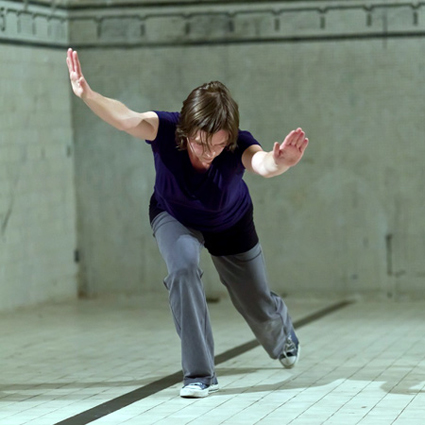
Sara Wookey, Trio A
courtesy of the artist
Sara Wookey, Trio A
Trio A is a seminal work choreographed by Yvonne Rainer in 1966 that informed a new approach to contemporary dance. US-based dancer Sara Wookey has worked extensively with Rainer and is one of a handful of people allowed to ‘transmit’ this choreography to other dancers. Wookey will be running workshops in Perth and Sydney teaching Trio A, as well as presenting a performance lecture about Rainer and her work.
PICA: lecture April 6; http://www.pica.org.au; Performance Space/UNSW Io Myers: workshop April 9-12, lecture April 13, Io Myers Studio; http://www.performancespace.com.au (The project is initiated by Hannah Mathews with thanks to Performa.)
mca: ultimate vision, monuments to us; workout
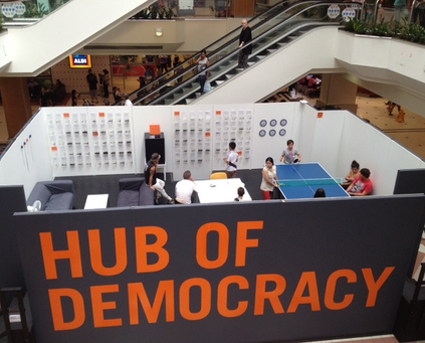
Hub of Democracy, Centre Court, Westfield Hurstville
photo Lara Thoms
Hub of Democracy, Centre Court, Westfield Hurstville
Lara Thoms (see RT Studio) has been hanging out in the mall in Hurstville for the last few months, asking local youth about their favourite things—which colour, word, time, music? After the votes have been counted Thoms will create a series of celebratory monuments, some physical, some performative, in and around the Westfield complex.
MCA/C3West: Ultimate vision, Monuments to us, Lara Thoms, Westfield Hurstville, April 5-10, http://www.mca.com.au
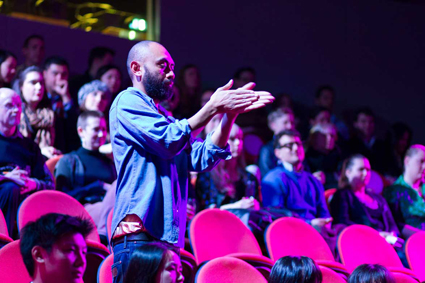
Brian Fuata (Wrong Solo), Reverse Lecture 2012
courtesy & © the artist, photo Catherine McElhone
Brian Fuata (Wrong Solo), Reverse Lecture 2012
Also at the MCA is Workout. Over one week seven artists will be given a day to create a performance exploring “workout as both a strenuous exercise routine and a test of performance capability” as well as the ”creative act of ‘working out ideas’” (press release). Featuring David Capra, Domenico de Clario, Brian Fuata, Sarah Goffman, Agatha Gothe-Snape with Susan Gibb, The Motel Sisters (Liam Benson and Naomi Oliver) and Jodie Whalen.
Workout, curator Anna Davis, Museum of Contemporary Art, April 22-28; http://www.mca.com.au
wang gongxin, maap space
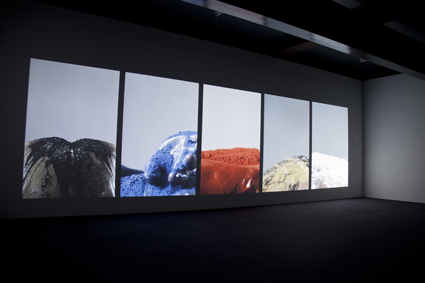
Wang Gongxing, Basic Colour (2010)
courtesy MAAP and the artist
Wang Gongxing, Basic Colour (2010)
Have you noticed a lot of pigment hurling in advertisements and video clips of late (eg Pink’s “Try”)? As usual mainstream media merchants are sucking out ideas from contemporary art. The use of pigment is most notable in the works of Anish Kapoor (showing at the MCA until recently) but also in Chinese video art pioneer Wang Gongxin’s five-channel video piece Basic Colour (2010). “[T]he slow accumulation of coloured pigment on each image is a kind of performance-based painting” (press release). This work is showing at MAAP Space along with Maybe Have Wind which explores manipulations of time and speed in the video format.
Wang Gongxin, MAAP Space, Brisbane, til April 26; http://www.maap.org.au/
the big picture, stills gallery
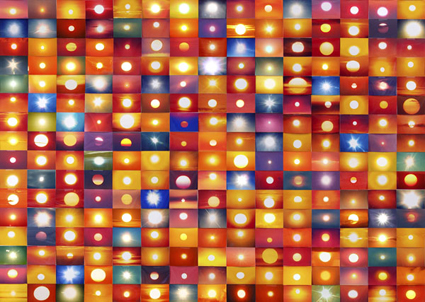
Penelope Umbrico, 541795 Suns from Sunsets from Flickr (Partial) 1/26/06, (2006-ongoing), detail of 2000 4″ x 6″ machine c-prints
Next up at Stills Gallery is an exhibition that asks “If a picture speaks a thousand words, what can a thousand pictures reveal?” (press release). The Big Picture will feature, photographic, video and installation work by Daniel Connell, Drew Flaherty, Gemma Messih, Patrick Pound, Penelope Umbrico (USA) and Tim Webster exploring how the plethora of visual imagery that is now being generated and consumed is affecting our sense of the sublime.
The Big Picture, Stills Gallery, Sydney, April 17-May 18; http://www.stillsgallery.com.au/
big game hunting, fiona hall, heide
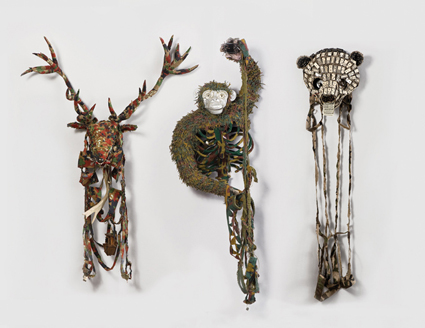
Fiona Hall: (l-r) Cervus elaphus/red deer Europe, North America 2012, IUCN threat status: least concern; Pan troglodytes/chimpanzee, Equatorial Africa 2012, IUCN threat status: Ailuropoda melanoleuca/giant panda, China 2012, IUCN threat status: critical
All images courtesy the artist and Roslyn Oxley9 Gallery, Sydney
Fiona Hall: (l-r) Cervus elaphus/red deer Europe, North America 2012, IUCN threat status: least concern; Pan troglodytes/chimpanzee, Equatorial Africa 2012, IUCN threat status: Ailuropoda melanoleuca/giant panda, China 2012, IUCN threat status: critical
Also looking at big ideas is Fiona Hall’s exhibition at Heide in regional Victoria. The centrepiece is Hall’s recent work for Documenta (13), Fall Prey, in which she uses military camouflage material and found objects to create curious hunting trophies of endangered animals.
Big Game Hunting, Fiona Hall, Heide Museum of Modern Art, Vic, till July 21; http://www.heide.com.au
the agony the ecstasy and i
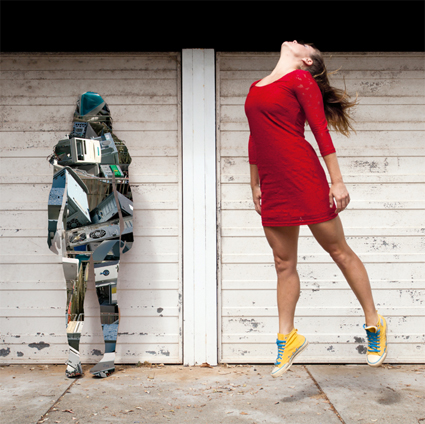
The Agony and the ecstasy and i
image Ivan Shaw and Simon Runkel
The Agony and the ecstasy and i
In this post-postmodern world all works of art talk to and about each other and this is clearly the case in dancer Tarryn Runkel and actor Lauren Hopwood’s The Agony, the ecstasy and i, a work that engages with the issues raised by Mike Daisey’s similarly titled solo show about Steve Jobs in which his representation of fiction and reality became a bit too blurry for some.
The Agony, the ecstasy and i, director Cara Philips, The Blue Room, Perth, April 16-May 4, http://blueroom.org.au/seasons/seasonone2013/
oi you!, urban art festival adelaide street art festival
While Melbourne is synonomous with ‘street art’ each of Australia’s capitals has its fair share and Adelaide is set to celebrate its own urban expression. Hopefully the irony is not lost that the major street art exhibition will take place in the Adelaide’s centre of all things cultural, the Festival Centre and will feature major works from internationals including 22 pieces from the king of urban art Banksy. (It’s a touring exhibition organised by a New Zealand group http://streetart.co.nz/.) There’s also a range of activities highlighting local work such as city tours and a ‘scrawl wall’ for locals to try their hand.
Oi You!, Urban Art Festival, April 20-June 2, Artspace Gallery Adelaide Festival Centre and Adelaide Streets; https://www.facebook.com/OiYouStreetArt
the past is a foreign country, the paper cut collective and trantrum
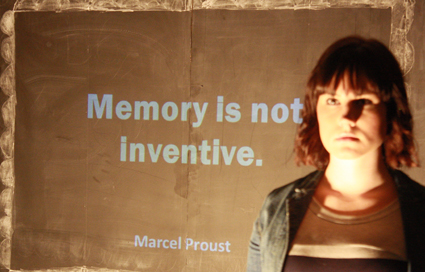
Emily Daly, The Past is Foreign Country, Paper Cut Collective
photo Justine Potter
Emily Daly, The Past is Foreign Country, Paper Cut Collective
Paper Cut Collective is a new performance collective in Newcastle NSW. With the help of local theatre for young people Tantrum, they will be presenting their first show, The Past is a Foreign Country. It’s in the verbatim theatre mode and explores how retelling the past inevitably reshapes it.
The Past is a Foreign Country, Paper Cut Collective & Tantrum, Civic Theatre, Newcastle, April 10-13; http://www.tantrumtheatre.org.au/season-2013/the-past/
still in the loop
The Good Room, I should have drunk more champagne
The Basement, Metro Arts, Brisbane, March 27- April 13
www.metroarts.com.au/
Drawn from Sound, curator Cat Hope
Spectrum Project Space, Edith Cowan University, Perth, March 28-April 12
http://www.drawnfromsound.com/
Made in China, Australia
McClelland Sculpture Park + Gallery, Langwarrin, VIC, (a Salamanca Arts Centre & CAST Touring exhibition), March 17 – June 9
http://www.mcclellandgallery.com
RealTime issue #113 Feb-March 2013 pg. web
© RealTime ; for permission to reproduce apply to realtime@realtimearts.net















































 “What is this film about? If one accepts its hypno-haunto inclination, it’s a dual text. One, a dream-narrative about Peter (Toby Jones), a very British sound editor from the mid-70s who ends up producing sound effects for a very Italian mixer, Santini, tracking and mixing an unseen film, The Equestrian Complex, in the eponymous Italian post-production studio. The other, an audiophiliac celebration of the components, procedures and techniques for recording sound effects back then, with an ancillary appreciation of the Italian giallo subgenre of erotic thrillers produced in Italy since the 1960s” (Philip Brophy,
“What is this film about? If one accepts its hypno-haunto inclination, it’s a dual text. One, a dream-narrative about Peter (Toby Jones), a very British sound editor from the mid-70s who ends up producing sound effects for a very Italian mixer, Santini, tracking and mixing an unseen film, The Equestrian Complex, in the eponymous Italian post-production studio. The other, an audiophiliac celebration of the components, procedures and techniques for recording sound effects back then, with an ancillary appreciation of the Italian giallo subgenre of erotic thrillers produced in Italy since the 1960s” (Philip Brophy,  Danny, just out of gaol, struggles to find employment and to confirm love, but circumstances and his damaged psyche coalesce to set him on a path to brutal vengeance. Not a film for the faint-hearted. After seeing Hail at its premiere in the 2011 Adelaide Film Festival, I wrote, “Hail is a drama feature that deftly manages to fuse documentary immediacy (fluid hand-held camera work, raw dialogue) with carefully constructed scenography built around lyrical editing and richly textured and adroitly framed widescreen cinematography (Germain McMicking). It’s a big screen, immersive experience… Despite some uneven plot development, Hail is a remarkable film: Daniel Jones and Leanne Letch’s performances are excellent in their portrayal of a profoundly uneasy love, cinematography is superb and the script tightly focused, conveying both spontaneity and a sense of craft and purpose” (Keith Gallasch,
Danny, just out of gaol, struggles to find employment and to confirm love, but circumstances and his damaged psyche coalesce to set him on a path to brutal vengeance. Not a film for the faint-hearted. After seeing Hail at its premiere in the 2011 Adelaide Film Festival, I wrote, “Hail is a drama feature that deftly manages to fuse documentary immediacy (fluid hand-held camera work, raw dialogue) with carefully constructed scenography built around lyrical editing and richly textured and adroitly framed widescreen cinematography (Germain McMicking). It’s a big screen, immersive experience… Despite some uneven plot development, Hail is a remarkable film: Daniel Jones and Leanne Letch’s performances are excellent in their portrayal of a profoundly uneasy love, cinematography is superb and the script tightly focused, conveying both spontaneity and a sense of craft and purpose” (Keith Gallasch,  “In the late 1960s, a musician was discovered in a Detroit bar by two celebrated producers struck by his soulful melodies and prophetic lyrics. They recorded an album that they believed was going to secure his reputation as one of the greatest recording artists of his generation. The album bombed and the singer disappeared into obscurity amid rumours of a gruesome on-stage suicide. But a bootleg recording found its way into apartheid South Africa and, over the next two decades, it became a phenomenon. In this Oscar-winning documentary two South African fans set out to find out what really happened to their hero [leading] them to a story more extraordinary than any of the existing myths about the artist known as Rodriguez” (Madman Press release).
“In the late 1960s, a musician was discovered in a Detroit bar by two celebrated producers struck by his soulful melodies and prophetic lyrics. They recorded an album that they believed was going to secure his reputation as one of the greatest recording artists of his generation. The album bombed and the singer disappeared into obscurity amid rumours of a gruesome on-stage suicide. But a bootleg recording found its way into apartheid South Africa and, over the next two decades, it became a phenomenon. In this Oscar-winning documentary two South African fans set out to find out what really happened to their hero [leading] them to a story more extraordinary than any of the existing myths about the artist known as Rodriguez” (Madman Press release).






![Ryoji Ikeda, data.tron [8k enhanced version], audiovisual installation, 2008-09, © Ryoji Ikeda](https://www.realtime.org.au/wp-content/uploads/art/62/6222_gallasch_isea_datatron.jpg)
















































 self-release
self-release DOWN AT THE ROCKS PRECINCT THE CULTURAL SCHEMERS AT THE SYDNEY HARBOUR FORESHORE AUTHORITY ARE NOT AFRAID TO DREAM BIG.
DOWN AT THE ROCKS PRECINCT THE CULTURAL SCHEMERS AT THE SYDNEY HARBOUR FORESHORE AUTHORITY ARE NOT AFRAID TO DREAM BIG. 















